ZyXEL Communications P660WTXV2 802.11g Wireless ADSL2+ Router User Manual SMG 700 User s Guide V1 00 Nov 2004
ZyXEL Communications Corporation 802.11g Wireless ADSL2+ Router SMG 700 User s Guide V1 00 Nov 2004
Contents
- 1. Users manual1
- 2. Users manual2
- 3. Users manual3
Users manual1

www.zyxel.com
P-660W-Tx v2
ADSL Router over POTS/ISDN
User’s Guide
Version 3.40
03/2008
Edition 2
DEFAULT LOGIN
IP Address http://192.168.1.1
Password 1234

About This User's Guide
P-660W-Tx v2 User’s Guide 3
About This User's Guide
Intended Audience
This manual is intended for people who want to configure the ZyXEL Device using the web
configurator. You should have at least a basic knowledge of TCP/IP networking concepts and
topology.
Related Documentation
• Quick Start Guide
The Quick Start Guide is designed to help you get up and running right away. It contains
information on setting up your network and configuring for Internet access.
• Web Configurator Online Help
Embedded web help for descriptions of individual screens and supplementary
information.
• Command Reference Guide
The Command Reference Guide explains how to use the Command-Line Interface (CLI)
and CLI commands to configure the ZyXEL Device.
"It is recommended you use the web configurator to configure the ZyXEL
Device.
• Supporting Disk
Refer to the included CD for support documents.
• ZyXEL Web Site
Please refer to www.zyxel.com for additional support documentation and product
certifications.
User’s Guide Feedback
Help us help you. Send all User’s Guide-related comments, questions or suggestions for
improvement to the following address, or use e-mail instead. Thank you!
The Technical Writing Team,
ZyXEL Communications Corp.,
6 Innovation Road II,
Science-Based Industrial Park,
Hsinchu, 300, Taiwan.
E-mail: techwriters@zyxel.com.tw

Document Conventions
P-660W-Tx v2 User’s Guide
4
Document Conventions
Warnings and Notes
These are how warnings and notes are shown in this User’s Guide.
1Warnings tell you about things that could harm you or your ZyXEL Device.
"Notes tell you other important information (for example, other things you may
need to configure or helpful tips) or recommendations.
Syntax Conventions
• The P-660W-T1 v2 and the P-660W-T3 v2 may be referred to as the “ZyXEL Device”,
the “P-660W-Tx v2”, the “device”, the “system” or the “product” in this User’s Guide.
• Product labels, screen names, field labels and field choices are all in bold font.
• A key stroke is denoted by square brackets and upper case text, for example, [ENTER]
means the “enter” or “return” key on your keyboard.
• “Enter” means for you to type one or more characters and then press the [ENTER] key.
“Select” or “choose” means for you to use one of the predefined choices.
• A right angle bracket (>) within a screen name denotes a mouse click. For example,
Maintenance > Log > Log Setting means you first click Maintenance in the navigation
panel, then the Log sub menu and finally the Log Setting tab to get to that screen.
• Units of measurement may denote the “metric” value or the “scientific” value. For
example, “k” for kilo may denote “1000” or “1024”, “M” for mega may denote “1000000”
or “1048576” and so on.
• “e.g.,” is a shorthand for “for instance”, and “i.e.,” means “that is” or “in other words”.
Icons Used in Figures
Figures in this User’s Guide may use the following generic icons. The ZyXEL Device icon is
not an exact representation of your ZyXEL Device.
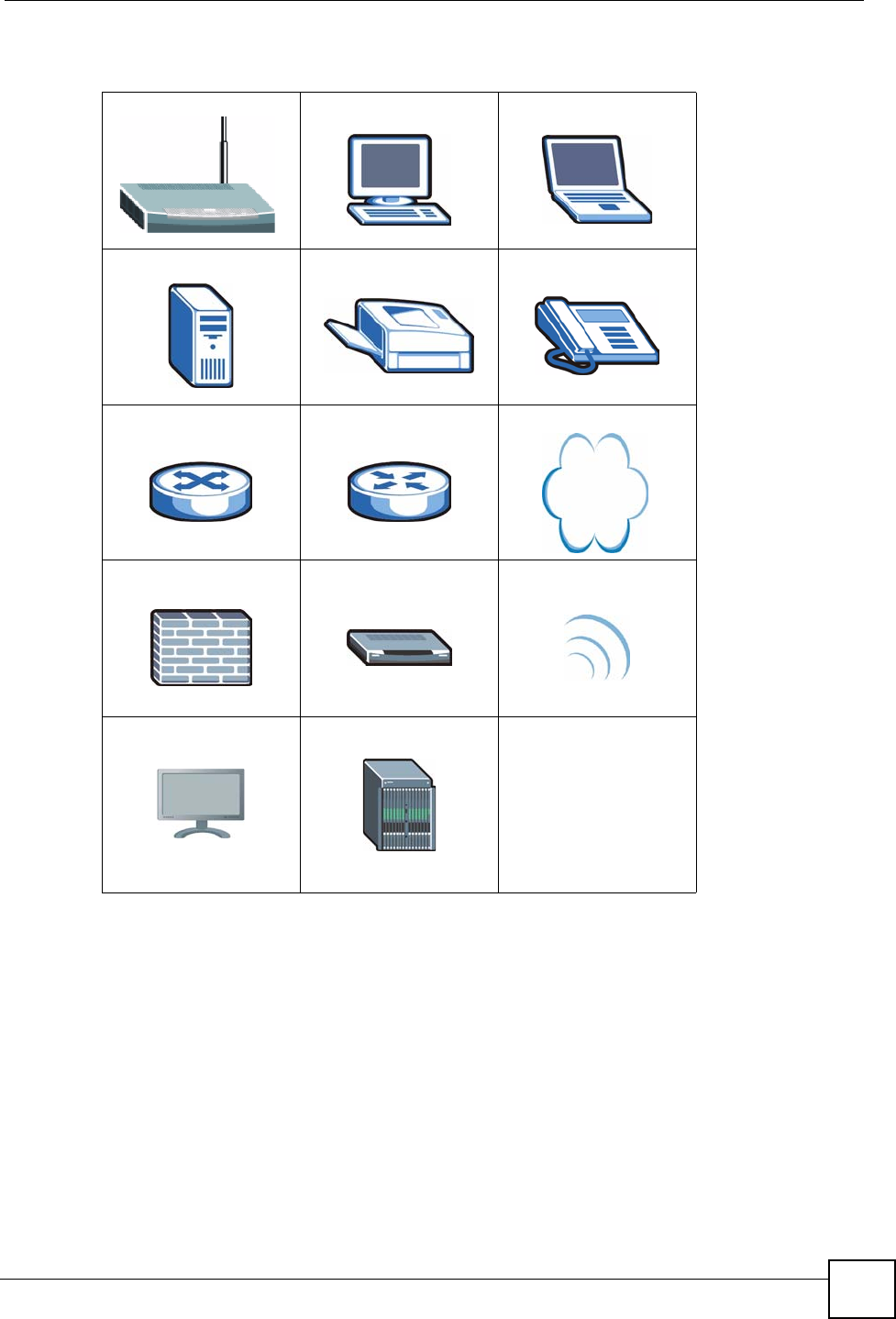
Document Conventions
P-660W-Tx v2 User’s Guide 5
Table 1 Common Icons
ZyXEL Device Computer Notebook
Server Printer Telephone
Switch Router Internet Cloud
Firewall Modem Wireless Signal
Television DSLAM

Safety Warnings
P-660W-Tx v2 User’s Guide
6
Safety Warnings
1For your safety, be sure to read and follow all warning notices and instructions.
• Do NOT use this product near water, for example, in a wet basement or near a swimming
pool.
• Do NOT expose your device to dampness, dust or corrosive liquids.
• Do NOT store things on the device.
• Do NOT install, use, or service this device during a thunderstorm. There is a remote risk
of electric shock from lightning.
• Connect ONLY suitable accessories to the device.
• ONLY qualified service personnel should service or disassemble this device.
• Make sure to connect the cables to the correct ports.
• Place connecting cables carefully so that no one will step on them or stumble over them.
• Always disconnect all cables from this device before servicing or disassembling.
• Use ONLY an appropriate power adaptor or cord for your device. Connect it to the right
supply voltage (for example, 110V AC in North America or 230V AC in Europe).
• Use ONLY power wires of the appropriate wire gauge (see Chapter 20 on page 201 for
details) for your device. Connect it to a power supply of the correct voltage (see Chapter
20 on page 201 for details).
• Do NOT allow anything to rest on the power adaptor or cord and do NOT place the
product where anyone can walk on the power adaptor or cord.
• Do NOT use the device if the power adaptor or cord is damaged as it might cause
electrocution.
• If the power adaptor or cord is damaged, remove it from the device and the power source.
• Do NOT attempt to repair the power adaptor or cord. Contact your local vendor to order a
new one.
• Do not use the device outside, and make sure all the connections are indoors. There is a
remote risk of electric shock from lightning.
• Do NOT obstruct the device ventilation slots, as insufficient airflow may harm your
device.
• Use only No. 26 AWG (American Wire Gauge) or larger telecommunication line cord.
• Antenna Warning! This device meets ETSI and FCC certification requirements when
using the included antenna(s). Only use the included antenna(s).
• If you wall mount your device, make sure that no electrical lines, gas or water pipes will
be damaged.
This product is recyclable. Dispose of it properly.

Safety Warnings
P-660W-Tx v2 User’s Guide 7

Safety Warnings
P-660W-Tx v2 User’s Guide
8

Contents Overview
P-660W-Tx v2 User’s Guide 9
Contents Overview
Introduction ............................................................................................................................ 27
Introducing the ZyXEL Device ...................................................................................................29
Introducing the Web Configurator .............................................................................................. 33
Setup Wizard .......................................................................................................................... 39
Connection Setup Wizard.......................................................................................................... 41
Media Bandwidth Management Wizard ..................................................................................... 49
Advanced Setup ..................................................................................................................... 53
LAN Setup ................................................................................................................................. 55
Wireless LAN ............................................................................................................................. 65
WAN Setup ................................................................................................................................ 81
Network Address Translation (NAT) Screens ............................................................................ 93
Dynamic DNS Setup ................................................................................................................ 103
Time and Date ......................................................................................................................... 105
Firewalls .................................................................................................................................. 107
Firewall Configuration ...............................................................................................................119
Content Filtering ...................................................................................................................... 139
Remote Management Configuration ........................................................................................ 143
Universal Plug-and-Play (UPnP) ............................................................................................. 147
Logs Screens ........................................................................................................................... 159
Media Bandwidth Management Advanced Setup .................................................................... 165
Maintenance ......................................................................................................................... 179
Maintenance ............................................................................................................................ 181
Troubleshooting and Specifications .................................................................................. 193
Troubleshooting ....................................................................................................................... 195
Product Specifications ............................................................................................................. 201
Appendices ........................................................................................................................... 207

Contents Overview
P-660W-Tx v2 User’s Guide
10

Table of Contents
P-660W-Tx v2 User’s Guide 11
Table of Contents
About This User's Guide ..........................................................................................................3
Document Conventions............................................................................................................4
Safety Warnings........................................................................................................................ 6
Contents Overview ...................................................................................................................9
Table of Contents.................................................................................................................... 11
List of Figures ......................................................................................................................... 19
List of Tables........................................................................................................................... 23
Part I: Introduction................................................................................. 27
Chapter 1
Introducing the ZyXEL Device............................................................................................... 29
1.1 Overview .............................................................................................................................. 29
1.2 Ways to Manage the ZyXEL Device .................................................................................... 29
1.3 Good Habits for Managing the ZyXEL Device ..................................................................... 30
1.4 LEDs .................................................................................................................................... 30
Chapter 2
Introducing the Web Configurator ........................................................................................ 33
2.1 Web Configurator Overview ................................................................................................. 33
2.1.1 Accessing the Web Configurator ................................................................................ 33
2.1.2 Resetting the ZyXEL Device ...................................................................................... 34
2.1.3 Navigating the Web Configurator ............................................................................... 34
2.2 Change Login Password .................................................................................................... 37
Part II: Setup Wizard .............................................................................. 39
Chapter 3
Connection Setup Wizard ...................................................................................................... 41
3.1 Introduction .......................................................................................................................... 41
3.1.1 Internet Access Wizard Setup .................................................................................... 41

Table of Contents
P-660W-Tx v2 User’s Guide
12
Chapter 4
Media Bandwidth Management Wizard................................................................................. 49
4.1 Introduction .......................................................................................................................... 49
4.1.1 Media Bandwidth Management Wizard ..................................................................... 49
Part III: Advanced Setup........................................................................ 53
Chapter 5
LAN Setup................................................................................................................................ 55
5.1 LAN Overview ..................................................................................................................... 55
5.1.1 LANs, WANs and the ZyXEL Device .......................................................................... 55
5.1.2 DHCP Setup ...............................................................................................................56
5.1.3 DNS Server Address .................................................................................................. 56
5.1.4 DNS Server Address Assignment .............................................................................. 56
5.2 LAN TCP/IP ......................................................................................................................... 57
5.2.1 IP Address and Subnet Mask ..................................................................................... 57
5.2.2 RIP Setup ................................................................................................................... 58
5.2.3 Multicast ..................................................................................................................... 58
5.2.4 Any IP ......................................................................................................................... 59
5.3 Configuring LAN ................................................................................................................. 60
5.4 Configuring Static DHCP .................................................................................................... 62
Chapter 6
Wireless LAN........................................................................................................................... 65
6.1 Wireless Network Overview ................................................................................................. 65
6.2 Wireless Security Overview .................................................................................................66
6.2.1 SSID ........................................................................................................................... 66
6.2.2 MAC Address Filter .................................................................................................... 66
6.2.3 User Authentication .................................................................................................... 66
6.2.4 Encryption .................................................................................................................. 67
6.3 Additional Wireless Terms ................................................................................................... 68
6.4 The Main Wireless LAN Screen .......................................................................................... 68
6.5 Configuring the Wireless Screen ........................................................................................ 70
6.5.1 No Security ................................................................................................................. 71
6.5.2 WEP Encryption ......................................................................................................... 72
6.5.3 WPA-PSK/WPA2-PSK ................................................................................................ 73
6.5.4 WPA/WPA2 ................................................................................................................ 75
6.6 Configuring MAC Filters ................................................................................................... 77
6.7 WDS Screen ........................................................................................................................ 79
Chapter 7
WAN Setup............................................................................................................................... 81

Table of Contents
P-660W-Tx v2 User’s Guide 13
7.1 WAN Overview ................................................................................................................... 81
7.1.1 Encapsulation ............................................................................................................. 81
7.1.2 Multiplexing ................................................................................................................ 82
7.1.3 VPI and VCI ............................................................................................................... 82
7.1.4 IP Address Assignment .............................................................................................. 82
7.1.5 Nailed-Up Connection (PPP) ..................................................................................... 83
7.1.6 NAT ............................................................................................................................ 83
7.2 Metric .................................................................................................................................. 83
7.3 PPPoE Encapsulation ......................................................................................................... 84
7.4 Traffic Shaping ..................................................................................................................... 84
7.5 Zero Configuration Internet Access ..................................................................................... 85
7.6 The Main WAN Screen .......................................................................................................85
7.7 Configuring WAN Setup ...................................................................................................... 86
7.8 Traffic Redirect .................................................................................................................... 90
7.9 Configuring WAN Backup ................................................................................................... 90
Chapter 8
Network Address Translation (NAT) Screens.......................................................................93
8.1 NAT Overview ..................................................................................................................... 93
8.1.1 NAT Definitions ..........................................................................................................93
8.1.2 What NAT Does ......................................................................................................... 94
8.1.3 How NAT Works ......................................................................................................... 94
8.1.4 NAT Application ..........................................................................................................94
8.1.5 NAT Mapping Types ................................................................................................... 95
8.2 SUA (Single User Account) Versus NAT ............................................................................. 96
8.3 SUA Server .......................................................................................................................... 96
8.3.1 Default Server IP Address .......................................................................................... 97
8.3.2 Port Forwarding: Services and Port Numbers ............................................................ 97
8.3.3 Configuring Servers Behind SUA (Example) ............................................................. 97
8.4 Selecting the NAT Mode ..................................................................................................... 98
8.5 Configuring SUA Server Set ............................................................................................... 98
8.6 Configuring Address Mapping Rules .................................................................................. 99
8.7 Editing an Address Mapping Rule .................................................................................... 101
Chapter 9
Dynamic DNS Setup .............................................................................................................103
9.1 Dynamic DNS Overview ................................................................................................... 103
9.1.1 DYNDNS Wildcard ................................................................................................... 103
9.2 Configuring Dynamic DNS ................................................................................................. 103
Chapter 10
Time and Date ....................................................................................................................... 105
10.1 Configuring Time and Date ............................................................................................. 105

Table of Contents
P-660W-Tx v2 User’s Guide
14
Chapter 11
Firewalls................................................................................................................................. 107
11.1 Firewall Overview ............................................................................................................ 107
11.2 Types of Firewalls ............................................................................................................ 107
11.2.1 Packet Filtering Firewalls ....................................................................................... 107
11.2.2 Application-level Firewalls ...................................................................................... 108
11.2.3 Stateful Inspection Firewalls .................................................................................. 108
11.3 Introduction to ZyXEL’s Firewall ....................................................................................... 108
11.3.1 Denial of Service Attacks ....................................................................................... 109
11.4 Denial of Service .............................................................................................................. 109
11.4.1 Basics ..................................................................................................................... 109
11.4.2 Types of DoS Attacks ..............................................................................................110
11.5 Stateful Inspection .............................................................................................................113
11.5.1 Stateful Inspection Process .....................................................................................114
11.5.2 Stateful Inspection and the ZyXEL Device ..............................................................114
11.5.3 TCP Security ...........................................................................................................115
11.5.4 UDP/ICMP Security .................................................................................................115
11.5.5 Upper Layer Protocols .............................................................................................116
11.6 Guidelines for Enhancing Security with Your Firewall .......................................................116
11.6.1 Security In General ..................................................................................................116
11.7 Packet Filtering Vs Firewall ...............................................................................................117
11.7.1 Packet Filtering: .......................................................................................................117
11.7.2 Firewall ....................................................................................................................118
Chapter 12
Firewall Configuration ..........................................................................................................119
12.1 Access Methods ...............................................................................................................119
12.2 Firewall Policies Overview ...............................................................................................119
12.3 Rule Logic Overview ....................................................................................................... 120
12.3.1 Rule Checklist ........................................................................................................ 120
12.3.2 Security Ramifications ............................................................................................ 120
12.3.3 Key Fields For Configuring Rules .......................................................................... 121
12.4 Connection Direction ....................................................................................................... 121
12.4.1 LAN to WAN Rules ................................................................................................. 121
12.4.2 Alerts ...................................................................................................................... 122
12.5 The Main Firewall Screen ................................................................................................ 122
12.6 Configuring Default Firewall Policy ............................................................................... 122
12.7 Rule Summary ............................................................................................................... 123
12.7.1 Configuring Firewall Rules ................................................................................... 125
12.8 Customized Services ......................................................................................................128
12.9 Configuring A Customized Service ................................................................................. 128
12.10 Example Firewall Rule ................................................................................................... 129
12.11 Predefined Services ....................................................................................................... 133

Table of Contents
P-660W-Tx v2 User’s Guide 15
12.12 Anti-Probing ................................................................................................................... 134
12.13 DoS Thresholds ............................................................................................................ 135
12.13.1 Threshold Values ................................................................................................. 135
12.13.2 Half-Open Sessions ............................................................................................. 135
12.13.3 Configuring Firewall Thresholds ........................................................................... 136
Chapter 13
Content Filtering ................................................................................................................... 139
13.1 Content Filtering Overview ............................................................................................. 139
13.2 The Main Content Filter Screen ....................................................................................... 139
13.3 Configuring Keyword Blocking ........................................................................................ 140
13.4 Configuring the Schedule ............................................................................................... 141
13.5 Configuring Trusted Computers ...................................................................................... 141
Chapter 14
Remote Management Configuration ................................................................................... 143
14.1 Remote Management Overview ..................................................................................... 143
14.1.1 Remote Management Limitations .......................................................................... 143
14.1.2 Remote Management and NAT .............................................................................. 144
14.1.3 System Timeout .................................................................................................... 144
14.2 Telnet ............................................................................................................................... 144
14.3 FTP .................................................................................................................................. 144
14.4 Web ................................................................................................................................. 145
14.5 Configuring Remote Management .................................................................................. 145
Chapter 15
Universal Plug-and-Play (UPnP).......................................................................................... 147
15.1 Introducing Universal Plug and Play ............................................................................... 147
15.1.1 How do I know if I'm using UPnP? ......................................................................... 147
15.1.2 NAT Traversal ........................................................................................................ 147
15.1.3 Cautions with UPnP ............................................................................................... 147
15.2 UPnP and ZyXEL ............................................................................................................148
15.2.1 Configuring UPnP ................................................................................................. 148
15.3 Installing UPnP in Windows Example .............................................................................. 149
15.4 Using UPnP in Windows XP Example ............................................................................. 152
Chapter 16
Logs Screens ........................................................................................................................159
16.1 Logs Overview ................................................................................................................ 159
16.1.1 Alerts and Logs ...................................................................................................... 159
16.2 Configuring Log Settings ................................................................................................. 159
16.3 Displaying the Logs ........................................................................................................ 161
16.3.1 Example E-mail Log ............................................................................................... 162

Table of Contents
P-660W-Tx v2 User’s Guide
16
Chapter 17
Media Bandwidth Management Advanced Setup .............................................................. 165
17.1 Media Bandwidth Management Overview ...................................................................... 165
17.2 Bandwidth Classes and Filters ........................................................................................ 165
17.3 Proportional Bandwidth Allocation ................................................................................... 166
17.4 Bandwidth Management Usage Examples ...................................................................... 166
17.4.1 Application-based Bandwidth Management Example ............................................ 166
17.4.2 Subnet-based Bandwidth Management Example .................................................. 166
17.4.3 Application and Subnet-based Bandwidth Management Example ........................ 167
17.5 Scheduler ........................................................................................................................ 167
17.5.1 Priority-based Scheduler ........................................................................................ 168
17.5.2 Fairness-based Scheduler ..................................................................................... 168
17.6 Maximize Bandwidth Usage ............................................................................................ 168
17.6.1 Reserving Bandwidth for Non-Bandwidth Class Traffic .......................................... 168
17.6.2 Maximize Bandwidth Usage Example .................................................................... 168
17.7 Bandwidth Borrowing .......................................................................................................170
17.7.1 Maximize Bandwidth Usage With Bandwidth Borrowing ........................................ 170
17.8 The Main Media Bandwidth Management Screen .......................................................... 171
17.9 Configuring Summary ..................................................................................................... 171
17.10 Configuring Class Setup ............................................................................................... 172
17.10.1 Media Bandwidth Management Class Configuration ......................................... 173
17.10.2 Media Bandwidth Management Statistics ........................................................... 176
17.11 Bandwidth Monitor ....................................................................................................... 177
Part IV: Maintenance............................................................................ 179
Chapter 18
Maintenance .......................................................................................................................... 181
18.1 Maintenance Overview .................................................................................................... 181
18.2 System Status Screen .................................................................................................... 181
18.2.1 System Statistics .................................................................................................... 183
18.3 DHCP Table Screen ....................................................................................................... 185
18.4 Any IP Table Screen ....................................................................................................... 185
18.5 Wireless Screen ............................................................................................................. 186
18.5.1 Association List ..................................................................................................... 186
18.6 Diagnostic Screens .......................................................................................................... 187
18.6.1 General Diagnostic ................................................................................................ 187
18.6.2 DSL Line Diagnostic ............................................................................................. 188
18.7 Firmware Upgrade .......................................................................................................... 189
18.8 FTP Command Line ........................................................................................................ 190
18.8.1 Filename Conventions .......................................................................................... 191

Table of Contents
P-660W-Tx v2 User’s Guide 17
18.8.2 FTP Command Line Procedure ............................................................................. 191
18.8.3 GUI-based FTP Clients .......................................................................................... 192
18.8.4 FTP Restrictions .................................................................................................... 192
Part V: Troubleshooting and Specifications...................................... 193
Chapter 19
Troubleshooting.................................................................................................................... 195
19.1 Power, Hardware Connections, and LEDs ...................................................................... 195
19.2 ZyXEL Device Access and Login .................................................................................... 196
19.3 Internet Access ................................................................................................................ 197
19.4 Reset the ZyXEL Device to Its Factory Defaults .............................................................. 198
19.5 Wireless Router/AP Troubleshooting ............................................................................... 199
Chapter 20
Product Specifications .........................................................................................................201
20.1 General ZyXEL Device Specifications ............................................................................. 201
20.2 Wall-mounting Instructions .............................................................................................. 205
20.3 Power Adaptor Specifications .......................................................................................... 206
Part VI: Appendices ............................................................................. 207
Appendix A Pop-up Windows, JavaScripts and Java Permissions ...................................... 209
Appendix B Wireless LANs .................................................................................................. 217
Appendix C Common Services ............................................................................................ 231
Appendix D Legal Information .............................................................................................. 235
Appendix E Customer Support.............................................................................................241
Index....................................................................................................................................... 247

Table of Contents
P-660W-Tx v2 User’s Guide
18

List of Figures
P-660W-Tx v2 User’s Guide 19
List of Figures
Figure 1 High-speed Internet Access with the ZyXEL Device ................................................................ 29
Figure 2 Password Screen ..................................................................................................................... 34
Figure 3 Change Password at Login ...................................................................................................... 34
Figure 4 Web Configurator: Site Map Screen ....................................................................................... 35
Figure 5 Password .................................................................................................................................. 37
Figure 6 Internet Access Wizard Setup: ISP Parameters ....................................................................... 42
Figure 7 Internet Connection with PPPoE .............................................................................................. 43
Figure 8 Internet Connection with RFC 1483 ........................................................................................ 44
Figure 9 Internet Connection with ENET ENCAP ...................................................................................44
Figure 10 Internet Connection with PPPoA ............................................................................................ 45
Figure 11 Internet Access Wizard Setup: Third Screen .......................................................................... 46
Figure 12 Internet Access Wizard Setup: LAN Configuration ................................................................ 46
Figure 13 Internet Access Wizard Setup: Connection Tests .................................................................. 47
Figure 14 MBM Wizard: Media Bandwidth Management ...................................................................... 50
Figure 15 MBM Wizard: Media Bandwidth Management ...................................................................... 51
Figure 16 LAN and WAN IP Addresses .................................................................................................. 55
Figure 17 Any IP Example ...................................................................................................................... 59
Figure 18 LAN Setup .............................................................................................................................. 61
Figure 19 LAN > Static DHCP ................................................................................................................ 62
Figure 20 Example of a Wireless Network ............................................................................................. 65
Figure 21 Wireless LAN .......................................................................................................................... 69
Figure 22 Wireless Security Methods ..................................................................................................... 69
Figure 23 Network > Wireless LAN ....................................................................................................... 70
Figure 24 Network > Wireless LAN: No Security ................................................................................... 71
Figure 25 Wireless Screen ..................................................................................................................... 72
Figure 26 Network > Wireless LAN: WPA-PSK/ .....................................................................................74
Figure 27 Network > Wireless LAN > General: WPA/WPA2 ................................................................... 75
Figure 28 MAC Filter .............................................................................................................................. 78
Figure 29 Connecting Wireless Networks Using WDS .......................................................................... 79
Figure 30 Advanced Setup > Wireless LAN > WDS ............................................................................... 80
Figure 31 Example of Traffic Shaping .................................................................................................... 85
Figure 32 WAN ...................................................................................................................................... 85
Figure 33 WAN Setup (PPPoE) .............................................................................................................. 87
Figure 34 Traffic Redirect Example ........................................................................................................ 90
Figure 35 Traffic Redirect LAN Setup ..................................................................................................... 90
Figure 36 WAN Backup .......................................................................................................................... 91
Figure 37 How NAT Works ..................................................................................................................... 94
Figure 38 NAT Application With IP Alias ................................................................................................ 95

List of Figures
P-660W-Tx v2 User’s Guide
20
Figure 39 Multiple Servers Behind NAT Example ..................................................................................97
Figure 40 NAT Mode .............................................................................................................................. 98
Figure 41 Edit SUA/NAT Server Set ....................................................................................................... 99
Figure 42 Address Mapping Rules ....................................................................................................... 100
Figure 43 Edit Address Mapping Rule ................................................................................................. 101
Figure 44 Dynamic DNS ....................................................................................................................... 104
Figure 45 Time and Date ...................................................................................................................... 105
Figure 46 ZyXEL Device Firewall Application ....................................................................................... 109
Figure 47 Three-Way Handshake ..........................................................................................................110
Figure 48 SYN Flood .............................................................................................................................111
Figure 49 Smurf Attack ..........................................................................................................................112
Figure 50 Stateful Inspection .................................................................................................................113
Figure 51 Content Filtering .................................................................................................................. 122
Figure 52 Firewall: Default Policy ......................................................................................................... 123
Figure 53 Firewall: Rule Summary ...................................................................................................... 124
Figure 54 Firewall: Edit Rule ................................................................................................................ 126
Figure 55 Firewall: Customized Services ............................................................................................. 128
Figure 56 Firewall: Configure Customized Services ............................................................................. 129
Figure 57 Firewall Example: Rule Summary ........................................................................................ 130
Figure 58 Firewall Example: Edit Rule: Destination Address .............................................................. 130
Figure 59 Edit Custom Port Example ................................................................................................... 131
Figure 60 Firewall Example: Edit Rule: Select Customized Services ................................................... 132
Figure 61 Firewall Example: Rule Summary: My Service ................................................................... 133
Figure 62 Firewall: Anti Probing ........................................................................................................... 134
Figure 63 Firewall: Threshold ............................................................................................................... 136
Figure 64 Content Filtering .................................................................................................................. 139
Figure 65 Content Filter: Keyword ........................................................................................................ 140
Figure 66 Content Filter: Schedule ....................................................................................................... 141
Figure 67 Content Filter: Trusted .......................................................................................................... 141
Figure 68 Telnet Configuration on a TCP/IP Network ........................................................................... 144
Figure 69 Remote Management ........................................................................................................... 145
Figure 70 Configuring UPnP ................................................................................................................. 148
Figure 71 Add/Remove Programs: Windows Setup: Communication .................................................. 149
Figure 72 Add/Remove Programs: Windows Setup: Communication: Components ............................ 150
Figure 73 Network Connections ........................................................................................................... 150
Figure 74 Windows Optional Networking Components Wizard ............................................................ 151
Figure 75 Networking Services ............................................................................................................. 151
Figure 76 Network Connections ........................................................................................................... 152
Figure 77 Internet Connection Properties ............................................................................................ 153
Figure 78 Internet Connection Properties: Advanced Settings ............................................................. 154
Figure 79 Internet Connection Properties: Advanced Settings: Add .................................................... 154
Figure 80 System Tray Icon .................................................................................................................. 155
Figure 81 Internet Connection Status ................................................................................................... 155

List of Figures
P-660W-Tx v2 User’s Guide 21
Figure 82 Network Connections ........................................................................................................... 156
Figure 83 Network Connections: My Network Places .......................................................................... 157
Figure 84 Network Connections: My Network Places: Properties: Example ........................................ 157
Figure 85 Log Settings ......................................................................................................................... 160
Figure 86 View Logs ............................................................................................................................. 162
Figure 87 E-mail Log Example ............................................................................................................. 163
Figure 88 Application-based Bandwidth Management Example .......................................................... 166
Figure 89 Subnet-based Bandwidth Management Example ................................................................ 167
Figure 90 Application and Subnet-based Bandwidth Management Example ....................................... 167
Figure 91 Bandwidth Allotment Example .............................................................................................. 169
Figure 92 Maximize Bandwidth Usage Example .................................................................................. 170
Figure 93 Media Bandwidth Mgnt. ....................................................................................................... 171
Figure 94 Media Bandwidth Management: Summary .......................................................................... 171
Figure 95 Media Bandwidth Management: Class Setup ...................................................................... 173
Figure 96 Media Bandwidth Management: Class Configuration .......................................................... 174
Figure 97 Media Bandwidth Management Statistics ............................................................................ 176
Figure 98 Media Bandwidth Management: Monitor ............................................................................. 177
Figure 99 System Status ...................................................................................................................... 182
Figure 100 System Status: Show Statistics .......................................................................................... 184
Figure 101 DHCP Table ........................................................................................................................ 185
Figure 102 Any IP Table ....................................................................................................................... 186
Figure 103 Association List .................................................................................................................. 186
Figure 104 Diagnostic: General ............................................................................................................ 187
Figure 105 Diagnostic: DSL Line .......................................................................................................... 188
Figure 106 Firmware Upgrade .............................................................................................................. 189
Figure 107 Network Temporarily Disconnected ....................................................................................190
Figure 108 Error Message .................................................................................................................... 190
Figure 109 Wall-mounting Example ...................................................................................................... 205
Figure 110 Masonry Plug and M4 Tap Screw .......................................................................................206
Figure 111 Pop-up Blocker ................................................................................................................... 209
Figure 112 Internet Options: Privacy .................................................................................................... 210
Figure 113 Internet Options: Privacy .....................................................................................................211
Figure 114 Pop-up Blocker Settings ......................................................................................................211
Figure 115 Internet Options: Security ................................................................................................... 212
Figure 116 Security Settings - Java Scripting ....................................................................................... 213
Figure 117 Security Settings - Java ...................................................................................................... 213
Figure 118 Java (Sun) .......................................................................................................................... 214
Figure 119 Mozilla Firefox: Tools > Options .......................................................................................... 215
Figure 120 Mozilla Firefox Content Security ......................................................................................... 215
Figure 121 Peer-to-Peer Communication in an Ad-hoc Network ......................................................... 217
Figure 122 Basic Service Set ............................................................................................................... 218
Figure 123 Infrastructure WLAN ........................................................................................................... 219
Figure 124 RTS/CTS ............................................................................................................................ 220

List of Figures
P-660W-Tx v2 User’s Guide
22
Figure 125 WPA(2) with RADIUS Application Example ....................................................................... 227
Figure 126 WPA(2)-PSK Authentication ............................................................................................... 228

List of Tables
P-660W-Tx v2 User’s Guide 23
List of Tables
Table 1 Common Icons ............................................................................................................................ 5
Table 2 Front Panel LEDs ...................................................................................................................... 30
Table 3 Web Configurator Screens Summary ....................................................................................... 35
Table 4 Password .................................................................................................................................. 37
Table 5 Internet Access Wizard Setup: ISP Parameters ....................................................................... 42
Table 6 Internet Connection with PPPoE ............................................................................................... 43
Table 7 Internet Connection with RFC 1483 .......................................................................................... 44
Table 8 Internet Connection with ENET ENCAP ...................................................................................44
Table 9 Internet Connection with PPPoA ............................................................................................... 45
Table 10 Internet Access Wizard Setup: LAN Configuration ................................................................. 47
Table 11 MBM Wizard: Media Bandwidth Management ........................................................................ 50
Table 12 MBM Wizard: Media Bandwidth Management ........................................................................ 51
Table 13 LAN Setup ............................................................................................................................... 61
Table 14 LAN Setup ............................................................................................................................... 63
Table 15 Types of Encryption for Each Type of Authentication ............................................................. 67
Table 16 Additional Wireless Terms ....................................................................................................... 68
Table 17 Wireless LAN .......................................................................................................................... 69
Table 18 Network > Wireless LAN > General ........................................................................................ 70
Table 19 Wireless No Security ............................................................................................................... 72
Table 20 Wireless LAN .......................................................................................................................... 73
Table 21 Network > Wireless LAN > General: WPA-PSK/WPA2-PSK .................................................. 74
Table 22 Network > Wireless LAN > General: WPA/WPA2 ................................................................... 76
Table 23 MAC Filter ............................................................................................................................... 78
Table 24 Advanced Setup > Wireless LAN > WDS ............................................................................... 80
Table 25 WAN ........................................................................................................................................ 86
Table 26 WAN Setup ............................................................................................................................. 88
Table 27 WAN Backup ........................................................................................................................... 91
Table 28 NAT Definitions ....................................................................................................................... 93
Table 29 NAT Mapping Types ................................................................................................................ 96
Table 30 Services and Port Numbers .................................................................................................... 97
Table 31 NAT Mode ............................................................................................................................... 98
Table 32 Edit SUA/NAT Server Set ....................................................................................................... 99
Table 33 Address Mapping Rules ........................................................................................................ 100
Table 34 Edit Address Mapping Rule .................................................................................................. 102
Table 35 Dynamic DNS ....................................................................................................................... 104
Table 36 Time and Date ....................................................................................................................... 106
Table 37 Common IP Ports ...................................................................................................................110
Table 38 ICMP Commands That Trigger Alerts ....................................................................................112

List of Tables
P-660W-Tx v2 User’s Guide
24
Table 39 Legal NetBIOS Commands ....................................................................................................112
Table 40 Legal SMTP Commands .......................................................................................................112
Table 41 Firewall > Firewall Functions ................................................................................................. 122
Table 42 Firewall: Default Policy .......................................................................................................... 123
Table 43 Rule Summary ...................................................................................................................... 124
Table 44 Firewall: Edit Rule ................................................................................................................. 127
Table 45 Customized Services ............................................................................................................ 128
Table 46 Firewall: Configure Customized Services ............................................................................. 129
Table 47 Firewall: Anti Probing ............................................................................................................ 134
Table 48 Firewall: Threshold ................................................................................................................ 137
Table 49 Content Filter > Functions ..................................................................................................... 139
Table 50 Content Filter: Keyword ........................................................................................................ 140
Table 51 Content Filter: Schedule ....................................................................................................... 141
Table 52 Content Filter: Trusted .......................................................................................................... 142
Table 53 Remote Management ........................................................................................................... 145
Table 54 Configuring UPnP ................................................................................................................. 148
Table 55 Log Settings .......................................................................................................................... 160
Table 56 View Logs ............................................................................................................................. 162
Table 57 Application and Subnet-based Bandwidth Management Example ....................................... 167
Table 58 Media Bandwidth Mgnt. ........................................................................................................ 171
Table 59 Media Bandwidth Management: Summary ........................................................................... 172
Table 60 Media Bandwidth Management: Class Setup ....................................................................... 173
Table 61 Media Bandwidth Management: Class Configuration ........................................................... 174
Table 62 Services and Port Numbers .................................................................................................. 175
Table 63 Media Bandwidth Management Statistics ............................................................................. 176
Table 64 Media Bandwidth Management: Monitor .............................................................................. 177
Table 65 System Status ....................................................................................................................... 182
Table 66 System Status: Show Statistics ............................................................................................. 184
Table 67 DHCP Table .......................................................................................................................... 185
Table 68 Any IP Table .......................................................................................................................... 186
Table 69 Association List ..................................................................................................................... 187
Table 70 Diagnostic: General .............................................................................................................. 188
Table 71 Diagnostic: DSL Line ............................................................................................................ 188
Table 72 Firmware Upgrade ................................................................................................................ 189
Table 73 Filename Conventions .......................................................................................................... 191
Table 74 General Commands for GUI-based FTP Clients .................................................................. 192
Table 75 Hardware Specifications ....................................................................................................... 201
Table 76 Firmware Specifications ........................................................................................................ 202
Table 77 Standards Supported ............................................................................................................ 203
Table 78 Power Adaptor Specifications ............................................................................................... 206
Table 79 IEEE 802.11g ........................................................................................................................ 221
Table 80 Wireless Security Levels ....................................................................................................... 222
Table 81 Comparison of EAP Authentication Types ............................................................................ 225

List of Tables
P-660W-Tx v2 User’s Guide 25
Table 82 Wireless Security Relational Matrix ...................................................................................... 228
Table 83 Commonly Used Services ..................................................................................................... 231

List of Tables
P-660W-Tx v2 User’s Guide
26

27
PART I
Introduction
Introducing the ZyXEL Device (29)
Introducing the Web Configurator (33)

28
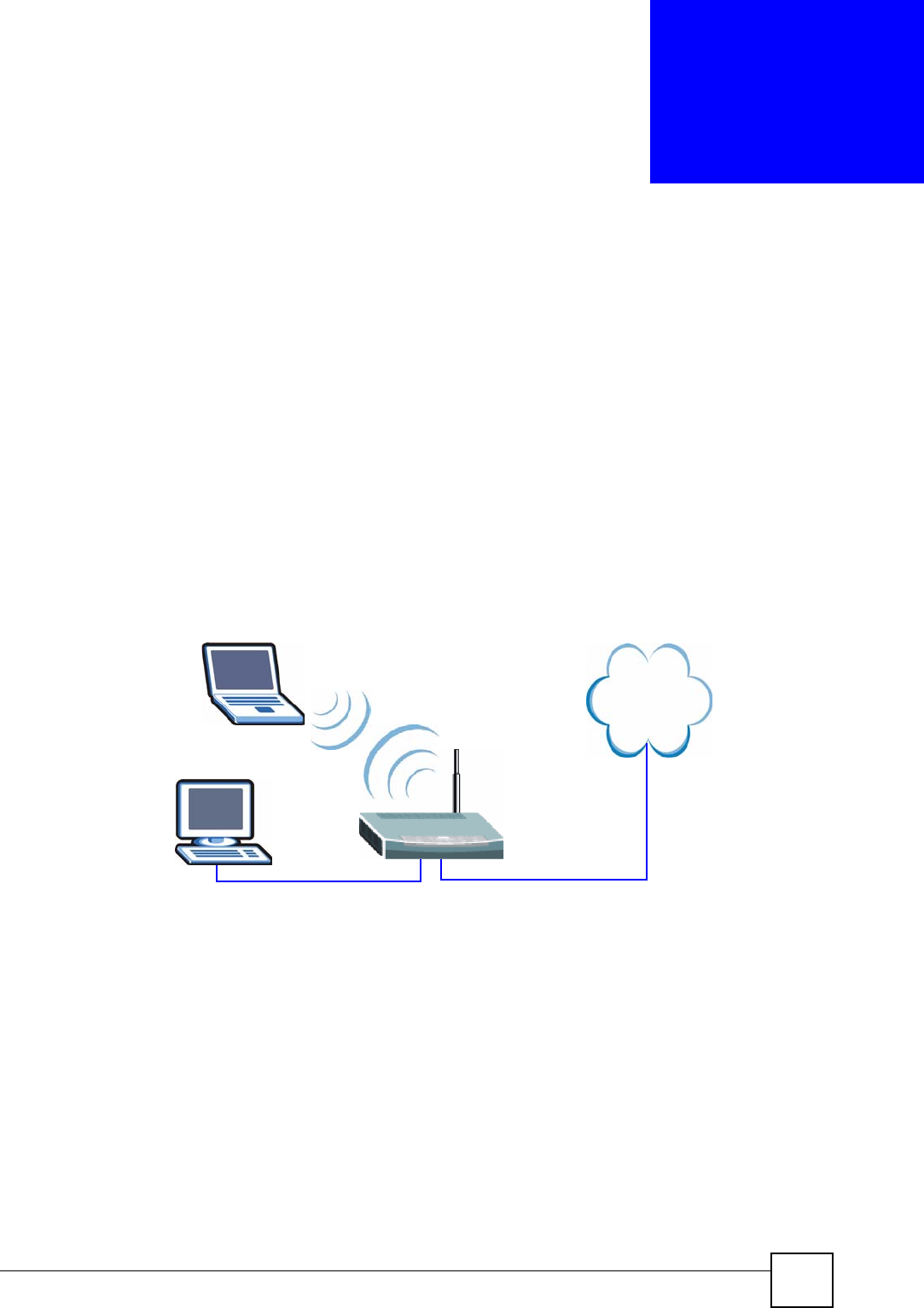
P-660W-Tx v2 User’s Guide 29
CHAPTER 1
Introducing the ZyXEL Device
This chapter introduces the main applications and features of the ZyXEL Device. It also
introduces the ways you can manage the ZyXEL Device.
1.1 Overview
The ZyXEL Device is an ADSL2+ gateway that allows fast, secure Internet access over analog
(POTS) or digital (ISDN) telephone lines (depending on your model).
The ZyXEL Device is an ADSL (Asymmetric Digital Subscriber Line) router and modem
with wireless capability. See Chapter 20 on page 201 for a complete list of features.
Figure 1 High-speed Internet Access with the ZyXEL Device
Connect your computer(s) to the ZyXEL Device. The ZyXEL Device uses the phone line to
provide high-speed Internet access to the computer(s). You can continue to use the phone line
for regular phone calls as well. See the Quick Start Guide for instructions on making these
connections.
1.2 Ways to Manage the ZyXEL Device
Use any of the following methods to manage the ZyXEL Device.
• Web Configurator. This is recommended for everyday management of the ZyXEL Device
using a (supported) web browser. See Chapter 2 on page 33.
• Command Line Interface. Line commands are mostly used for troubleshooting by service
engineers. See the CLI Reference Guide.
INTERNET
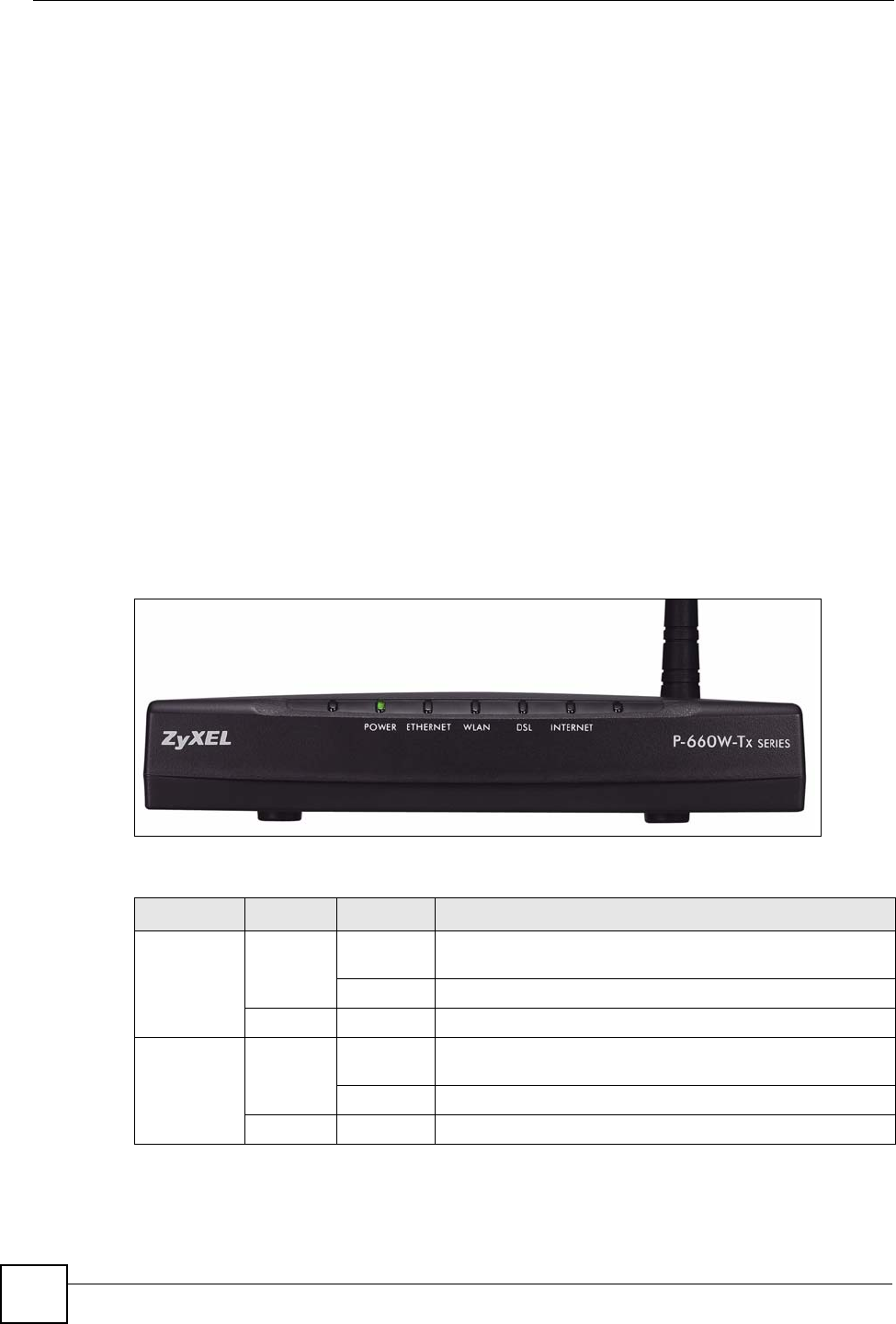
Chapter 1 Introducing the ZyXEL Device
P-660W-Tx v2 User’s Guide
30
• FTP. Use File Transfer Protocol for firmware upgrades and configuration backup/restore.
See Chapter 18 on page 190.
1.3 Good Habits for Managing the ZyXEL Device
Do the following things regularly to make the ZyXEL Device more secure and to manage the
ZyXEL Device more effectively.
• Change the password. Use a password that’s not easy to guess and that consists of
different types of characters, such as numbers and letters.
• Write down the password and put it in a safe place.
• Back up the configuration (and make sure you know how to restore it). Restoring an
earlier working configuration may be useful if the ZyXEL Device becomes unstable or
even crashes. If you forget your password, you will have to reset the ZyXEL Device to its
factory default settings. If you backed up an earlier configuration file, you would not have
to totally re-configure the ZyXEL Device. You could simply restore your last
configuration.
1.4 LEDs
The following figure shows the front panel LEDs.
The following table describes the LEDs.
Table 2 Front Panel LEDs
LED COLOR STATUS DESCRIPTION
POWER Green On The ZyXEL Device is receiving power and functioning
properly.
Blinking The ZyXEL Device is rebooting or performing diagnostics.
Off The system is not ready or has malfunctioned.
ETHERNET Green On The ZyXEL Device has a successful 10/100 Mb Ethernet
connection.
Blinking The ZyXEL Device is sending/receiving data.
Off The ZyXEL Device does not have an Ethernet connection.

Chapter 1 Introducing the ZyXEL Device
P-660W-Tx v2 User’s Guide 31
WLAN Green On The ZyXEL Device is ready, but is not sending/receiving data
through the wireless LAN.
Blinking The ZyXEL Device is sending/receiving data through the
wireless LAN.
Off The wireless LAN is not ready or has failed.
DSL Green Fast
Blinking
The ZyXEL Device is trying to detect the DSL signal.
Slow
Blinking
The ZyXEL Device is initializing the DSL line.
On The DSL link is successful.
Off The DSL link is down.
INTERNET Green On The ZyXEL Device has a successful connection to the
Internet.
Blinking There is data traffic on the ZyXEL Device’s Internet
connection.
Off The ZyXEL Device has no connection with the Internet.
Table 2 Front Panel LEDs (continued)
LED COLOR STATUS DESCRIPTION

Chapter 1 Introducing the ZyXEL Device
P-660W-Tx v2 User’s Guide
32

P-660W-Tx v2 User’s Guide 33
CHAPTER 2
Introducing the Web
Configurator
This chapter describes how to access and navigate the web configurator.
2.1 Web Configurator Overview
The web configurator is an HTML-based management interface that allows easy ZyXEL
Device setup and management via Internet browser. Use Internet Explorer 6.0 and later or
Netscape Navigator 7.0 and later versions. The recommended screen resolution is 1024 by 768
pixels.
In order to use the web configurator you need to allow:
• Web browser pop-up windows from your device. Web pop-up blocking is enabled by
default in Windows XP SP (Service Pack) 2.
• JavaScripts (enabled by default).
• Java permissions (enabled by default).
See the chapter on troubleshooting if you need to make sure these functions are allowed in
Internet Explorer.
2.1.1 Accessing the Web Configurator
Note: Even though you can connect to the ZyXEL Device wirelessly, it is
recommended that you connect your computer to a LAN port for initial
configuration.
1Make sure your ZyXEL Device hardware is properly connected (refer to the Quick Start
Guide).
2Prepare your computer/computer network to connect to the ZyXEL Device (refer to the
Quick Start Guide).
3Launch your web browser.
4Type “192.168.1.1” as the URL.
5A window displays as shown.The Password field already contains the default password
“1234”. Click Login to proceed to a screen asking you to change your password or click
Cancel to revert to the default password.

Chapter 2 Introducing the Web Configurator
P-660W-Tx v2 User’s Guide
34
Figure 2 Password Screen
6It is highly recommended you change the default password! Enter a new password
between 1 and 30 characters, retype it to confirm and click Apply; alternatively click
Ignore to proceed to the main menu if you do not want to change the password now.
Note: If you do not change the password at least once, the following screen appears
every time you log in.
Figure 3 Change Password at Login
7You should now see the SITE MAP screen.
Note: The ZyXEL Device automatically times out after five minutes of inactivity.
Simply log back into the ZyXEL Device if this happens to you.
2.1.2 Resetting the ZyXEL Device
If you forget your password or cannot access the web configurator, you will need to use the
RESET button at the back of the ZyXEL Device to reload the factory-default configuration
file. This means that you will lose all configurations that you had previously and the password
will be reset to “1234”.
2.1.2.1 Using the Reset Button
1Make sure the POWER LED is on (not blinking).
2Press the RESET button for ten seconds or until the POWER LED begins to blink and
then release it. When the POWER LED begins to blink, the defaults have been restored
and the ZyXEL Device restarts.
2.1.3 Navigating the Web Configurator
The following summarizes how to navigate the web configurator from the SITE MAP screen.
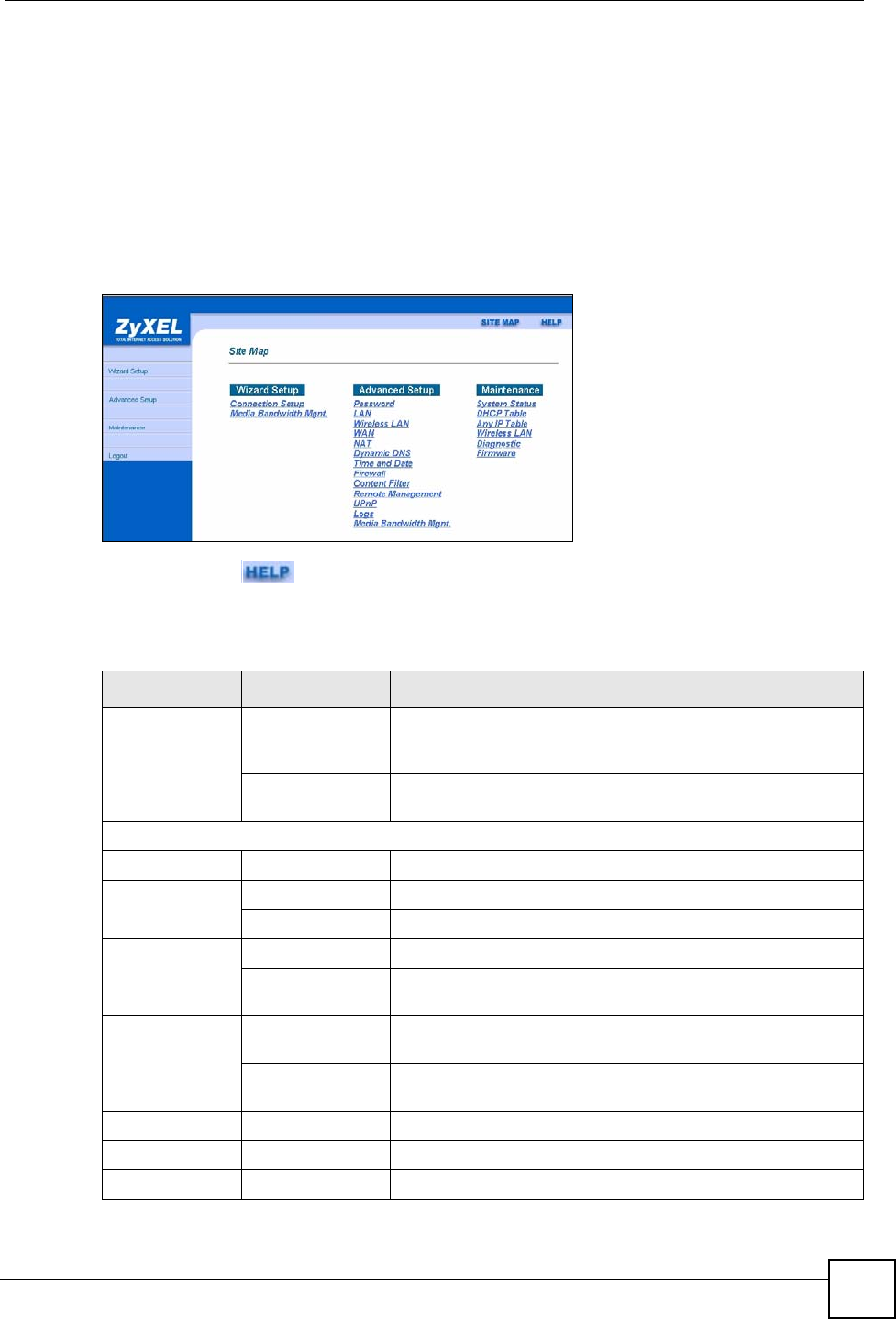
Chapter 2 Introducing the Web Configurator
P-660W-Tx v2 User’s Guide 35
• Click Wizard Setup to begin a series of screens to configure your ZyXEL Device for the
first time.
• Click a link under Advanced Setup to configure advanced ZyXEL Device features.
• Click a link under Maintenance to see ZyXEL Device performance statistics, upload
firmware and back up, restore or upload a configuration file.
• Click Site Map to go to the Site Map screen.
• Click Logout in the navigation panel when you have finished a ZyXEL Device
management session.
Figure 4 Web Configurator: Site Map Screen
Note: Click the icon (located in the top right corner of most screens) to view
embedded help.
Table 3 Web Configurator Screens Summary
LINK SUB-LINK FUNCTION
Wizard Setup Connection Setup Use these screens for initial configuration including general
setup, ISP parameters for Internet Access and WAN IP/DNS
Server/MAC address assignment.
Media Bandwidth
Mgnt
Use these screens to limit bandwidth usage by application.
Advanced Setup
Password Use this screen to change your password.
LAN LAN Setup Use this screen to configure LAN settings.
Static DHCP Use this screen to configure static DHCP settings on your LAN.
Wireless LAN Wireless Use this screen to configure the wireless LAN settings.
MAC Filter Use this screen to change MAC filter settings on the ZyXEL
Device.
WAN WAN Setup Use this screen to change the ZyXEL Device’s WAN remote
node settings.
WAN Backup Use this screen to configure your traffic redirect properties and
WAN backup settings.
NAT Use this screen to configure the NAT mode.
Dynamic DNS Use this screen to set up dynamic DNS.
Time and Date Use this screen to change your ZyXEL Device’s time and date.

Chapter 2 Introducing the Web Configurator
P-660W-Tx v2 User’s Guide
36
Firewall Default Policy Use this screen to activate/deactivate the firewall and the
direction of network traffic to which to apply the rule.
Rule Summary This screen shows a summary of the firewall rules, and allows
you to edit/add a firewall rule.
Anti Probing Use this screen to change your anti-probing settings.
Threshold Use this screen to configure the threshold for DoS attacks.
Content Filter Keyword Use this screen to block sites containing certain keywords in the
URL.
Schedule Use this screen to set the days and times for the ZyXEL Device
to perform content filtering.
Trusted Use this screen to exclude a range of users on the LAN from
content filtering on your ZyXEL Device.
Remote
Management
Use this screen to configure through which interface(s) and
from which IP address(es) users can use Telnet/FTP/Web to
manage the ZyXEL Device.
UPnP Use this screen to enable UPnP on the ZyXEL Device.
Logs Log Settings Use this screen to change your ZyXEL Device’s log settings.
View Log Use this screen to view the logs for the categories that you
selected.
Media Bandwidth
Management
Summary Use this screen to assign bandwidth limits to specific types of
traffic.
Class Setup Use this screen to define a bandwidth class.
Monitor Use this screen to view bandwidth class statistics.
Maintenance
System Status This screen contains administrative and system-related
information.
DHCP Table This screen displays DHCP (Dynamic Host Configuration
Protocol) related information and is READ-ONLY.
Any IP Table Use this screen to view the IP and MAC addresses of LAN
computers communicating with the ZyXEL Device.
Wireless LAN Association List This screen displays the MAC address(es) of the wireless
stations that are currently associating with the ZyXEL Device.
Diagnostic General These screens display information to help you identify problems
with the ZyXEL Device general connection.
DSL Line These screens display information to help you identify problems
with the DSL line.
Firmware Use this screen to upload firmware to your ZyXEL Device
LOGOUT Click Logout to exit the web configurator.
Table 3 Web Configurator Screens Summary (continued)
LINK SUB-LINK FUNCTION
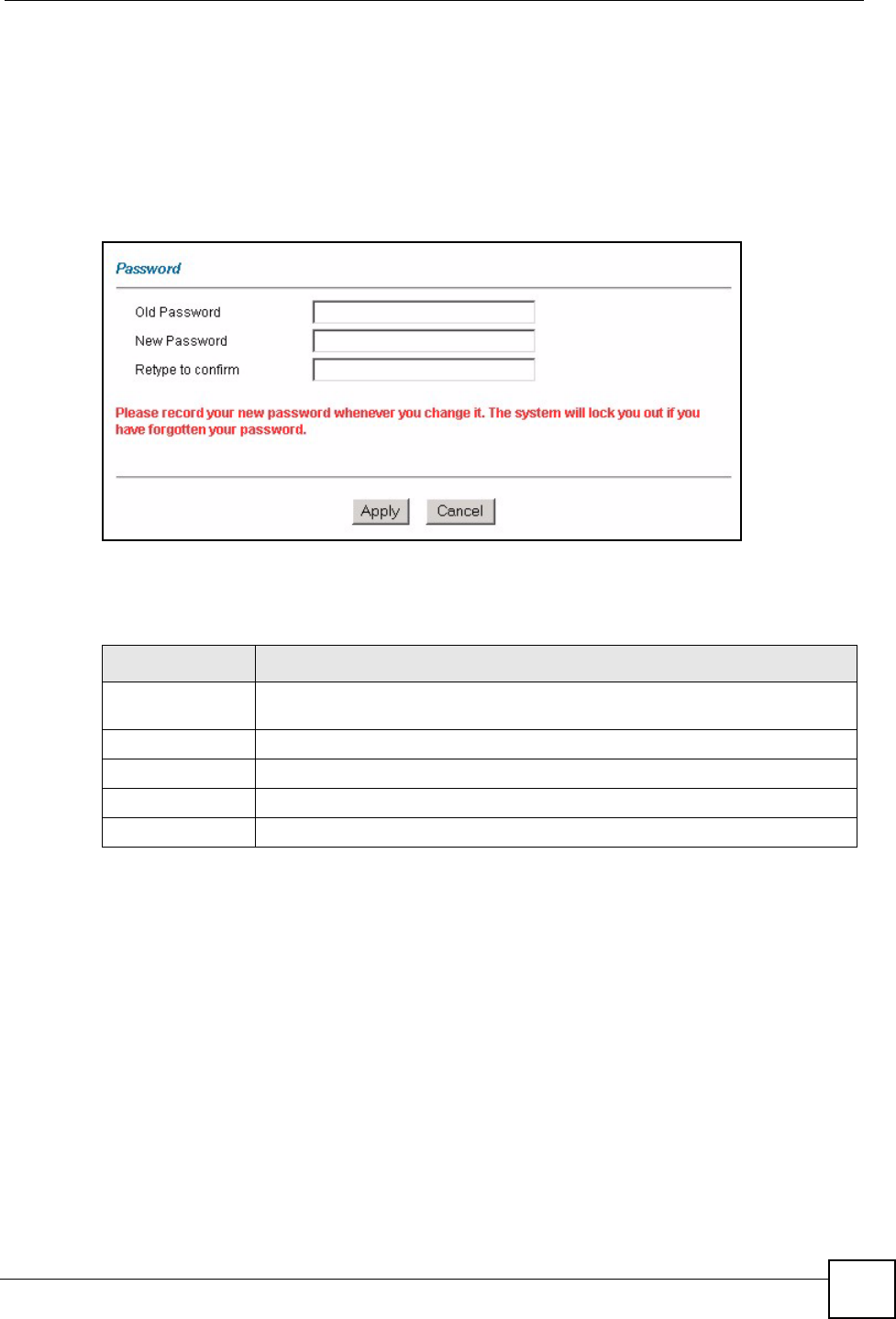
Chapter 2 Introducing the Web Configurator
P-660W-Tx v2 User’s Guide 37
2.2 Change Login Password
It is highly recommended that you periodically change the password for accessing the ZyXEL
Device. If you didn’t change the default one after you logged in or you want to change to a
new password again, then click Password in the Site Map screen to display the screen as
shown next.
Figure 5 Password
The following table describes the fields in this screen.
Table 4 Password
LABEL DESCRIPTION
Old Password Type the default password or the existing password you use to access the system
in this field.
New Password Type the new password in this field.
Retype to Confirm Type the new password again in this field.
Apply Click Apply to save your changes back to the ZyXEL Device.
Cancel Click Cancel to begin configuring this screen afresh.

Chapter 2 Introducing the Web Configurator
P-660W-Tx v2 User’s Guide
38

39
PART II
Setup Wizard
Connection Setup Wizard (41)
Media Bandwidth Management Wizard (49)

40

P-660W-Tx v2 User’s Guide 41
CHAPTER 3
Connection Setup Wizard
The Connection Wizard assists you in setting up Internet access. This chapter provides
information on the Connection Wizard screens in the web configurator.
3.1 Introduction
Use the Connection Wizard screens to configure your system for Internet access with the
information given to you by your ISP (Internet Service Provider).
Note: See the advanced menu chapters for background information on these fields.
3.1.1 Internet Access Wizard Setup
1 In the SITE MAP screen click Connection Setup to display the first wizard screen.
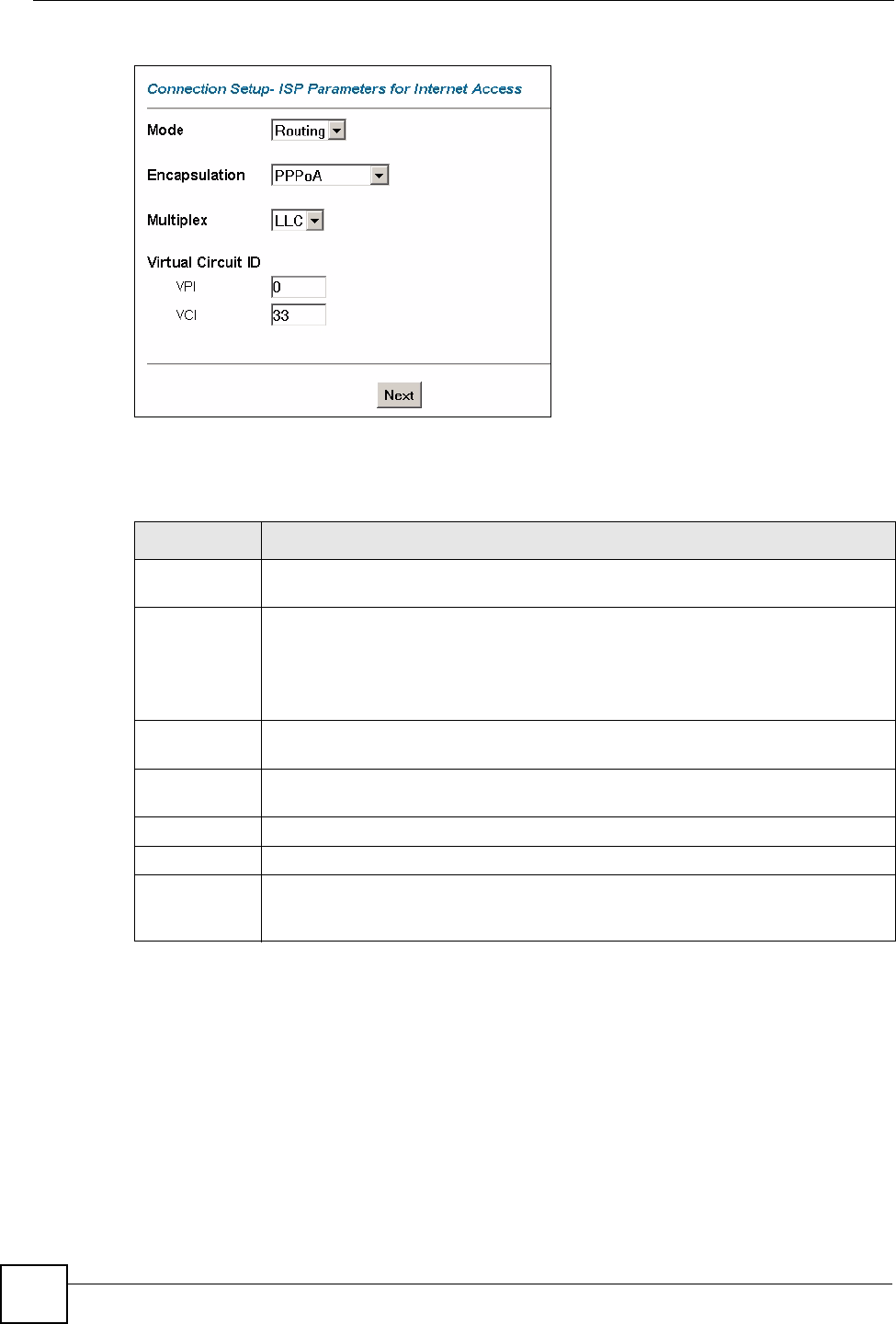
Chapter 3 Connection Setup Wizard
P-660W-Tx v2 User’s Guide
42
Figure 6 Internet Access Wizard Setup: ISP Parameters
The following table describes the fields in this screen.
2The next wizard screen varies depending on what mode and encapsulation type you use.
All screens shown are with routing mode. Configure the fields and click Next to continue.
Table 5 Internet Access Wizard Setup: ISP Parameters
LABEL DESCRIPTION
Mode From the Mode drop-down list box, select Routing (default) if your ISP allows
multiple computers to share an Internet account. Otherwise select Bridge.
Encapsulation Select the encapsulation type your ISP uses from the Encapsulation drop-down list
box. Choices vary depending on what you select in the Mode field.
If you select Bridge in the Mode field, select either PPPoA or RFC 1483.
If you select Routing in the Mode field, select PPPoA, RFC 1483, ENET ENCAP or
PPPoE.
Multiplex Select the multiplexing method used by your ISP from the Multiplex drop-down list
box either VC-based or LLC-based.
Virtual Circuit
ID
VPI (Virtual Path Identifier) and VCI (Virtual Channel Identifier) define a virtual circuit.
Refer to the appendix for more information.
VPI Enter the VPI assigned to you. This field may already be configured.
VCI Enter the VCI assigned to you. This field may already be configured.
Next Click this button to go to the next wizard screen. The next wizard screen you see
depends on what protocol you chose above. Click on the protocol link to see the next
wizard screen for that protocol.
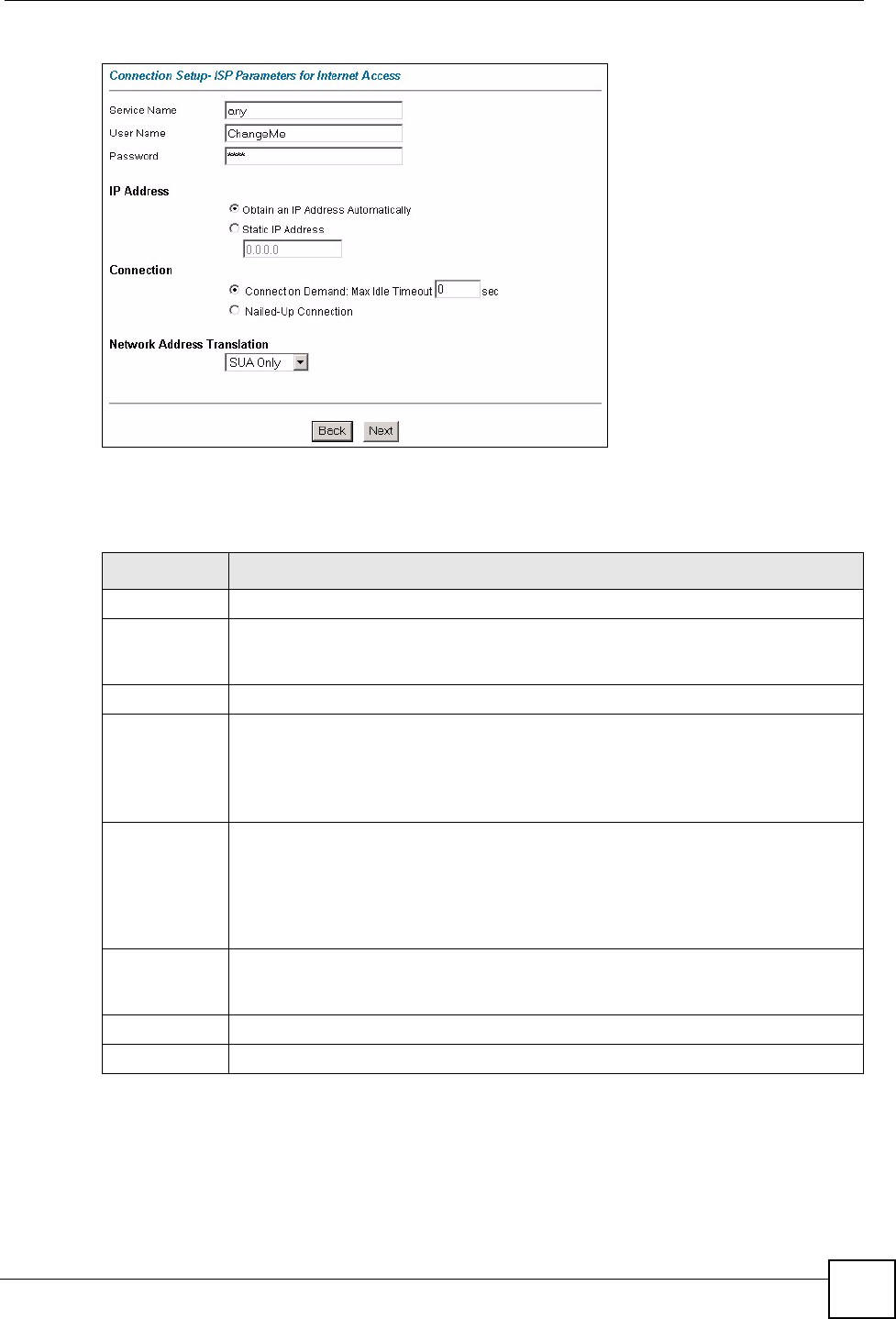
Chapter 3 Connection Setup Wizard
P-660W-Tx v2 User’s Guide 43
Figure 7 Internet Connection with PPPoE
The following table describes the fields in this screen.
Table 6 Internet Connection with PPPoE
LABEL DESCRIPTION
Service Name Type the name of your PPPoE service here.
User Name Enter the user name exactly as your ISP assigned. If assigned a name in the form
user@domain where domain identifies a service name, then enter both components
exactly as given.
Password Enter the password associated with the user name above.
IP Address A static IP address is a fixed IP that your ISP gives you. A dynamic IP address is not
fixed; the ISP assigns you a different one each time you connect to the Internet.
Select Obtain an IP Address Automatically if you have a dynamic IP address;
otherwise select Static IP Address and type your ISP assigned IP address in the text
box below.
Connection Select Connect on Demand when you don't want the connection up all the time and
specify an idle time-out (in seconds) in the Max. Idle Timeout field. The default
setting selects Connection on Demand with 0 as the idle time-out, which means the
Internet session will not timeout.
Select Nailed-Up Connection when you want your connection up all the time. The
ZyXEL Device will try to bring up the connection automatically if it is disconnected.
Network
Address
Translation
Select None, SUA Only or Full Feature from the drop-down list box. Refer to the
NAT chapter for more details.
Back Click Back to go back to the first wizard screen.
Next Click Next to continue to the next wizard screen.
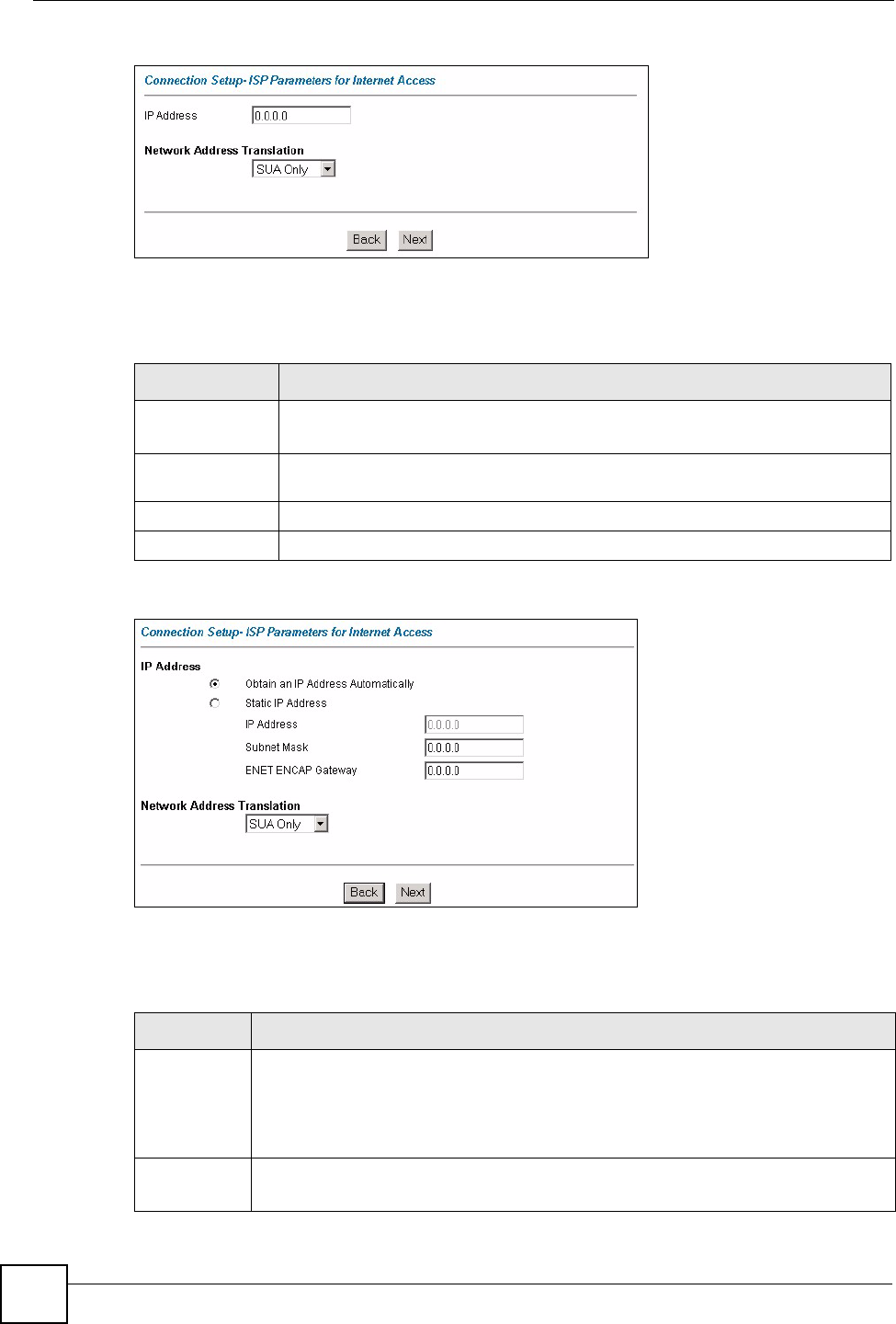
Chapter 3 Connection Setup Wizard
P-660W-Tx v2 User’s Guide
44
Figure 8 Internet Connection with RFC 1483
The following table describes the fields in this screen.
Figure 9 Internet Connection with ENET ENCAP
The following table describes the fields in this screen.
Table 7 Internet Connection with RFC 1483
LABEL DESCRIPTION
IP Address This field is available if you select Routing in the Mode field.
Type your ISP assigned IP address in this field.
Network Address
Translation
Select None, SUA Only or Full Feature from the drop-down list box. Refer to the
NAT chapter for more details.
Back Click Back to go back to the first wizard screen.
Next Click Next to continue to the next wizard screen.
Table 8 Internet Connection with ENET ENCAP
LABEL DESCRIPTION
IP Address A static IP address is a fixed IP that your ISP gives you. A dynamic IP address is not
fixed; the ISP assigns you a different one each time you connect to the Internet.
Select Obtain an IP Address Automatically if you have a dynamic IP address;
otherwise select Static IP Address and type your ISP assigned IP address in the IP
Address text box below.
Subnet Mask Enter a subnet mask in dotted decimal notation.
Refer to the appendices to calculate a subnet mask If you are implementing subnetting.
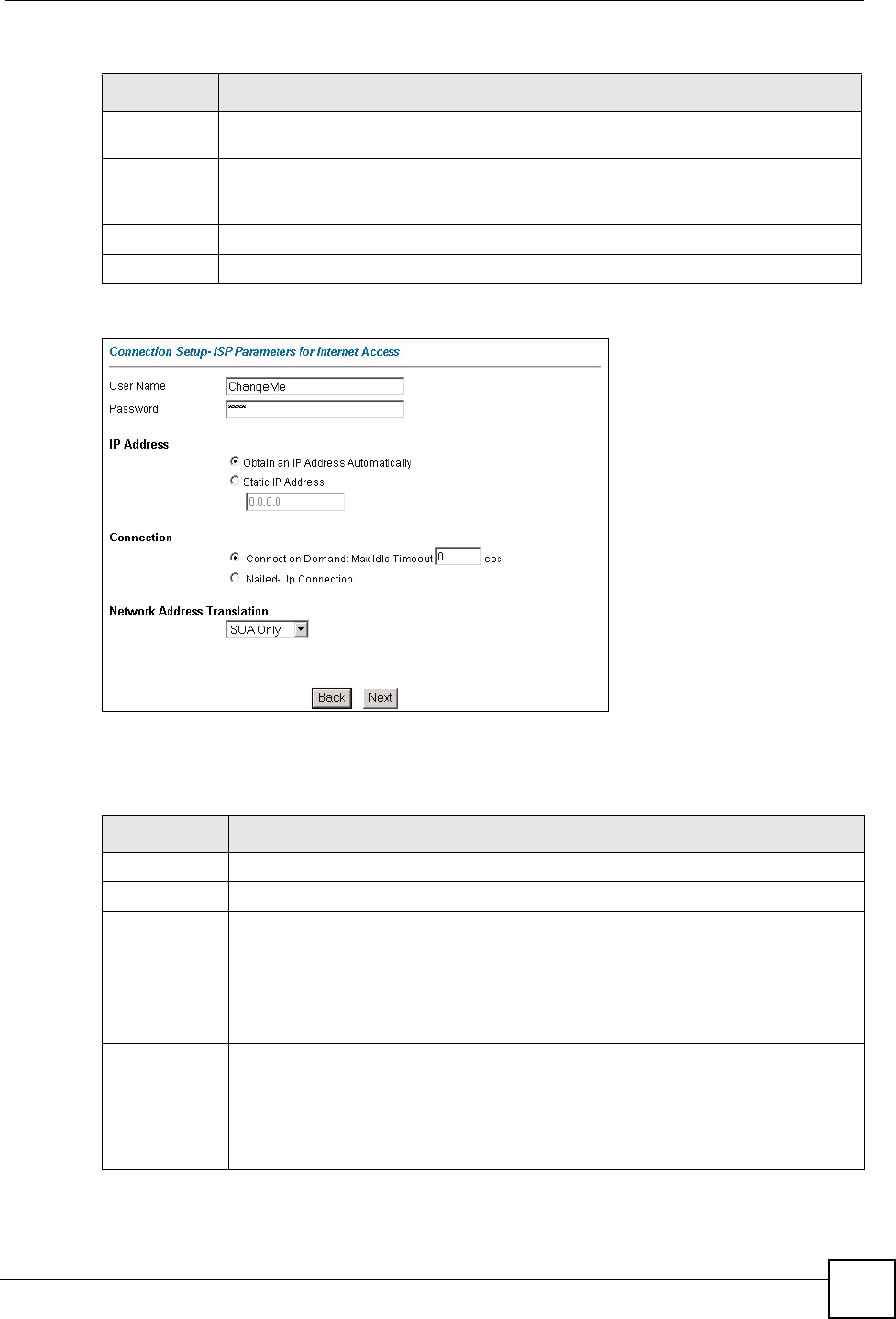
Chapter 3 Connection Setup Wizard
P-660W-Tx v2 User’s Guide 45
Figure 10 Internet Connection with PPPoA
The following table describes the fields in this screen.
ENET ENCAP
Gateway
You must specify a gateway IP address (supplied by your ISP) when you use ENET
ENCAP in the Encapsulation field in the previous screen.
Network
Address
Translation
Select None, SUA Only or Full Feature from the drop-sown list box. Refer to the NAT
chapter for more details.
Back Click Back to go back to the first wizard screen.
Next Click Next to continue to the next wizard screen.
Table 9 Internet Connection with PPPoA
LABEL DESCRIPTION
User Name Enter the login name that your ISP gives you.
Password Enter the password associated with the user name above.
IP Address This option is available if you select Routing in the Mode field.
A static IP address is a fixed IP that your ISP gives you. A dynamic IP address is not
fixed; the ISP assigns you a different one each time you connect to the Internet.
Click Obtain an IP Address Automatically if you have a dynamic IP address;
otherwise click Static IP Address and type your ISP assigned IP address in the IP
Address text box below.
Connection Select Connect on Demand when you don't want the connection up all the time and
specify an idle time-out (in seconds) in the Max. Idle Timeout field. The default setting
selects Connection on Demand with 0 as the idle time-out, which means the Internet
session will not timeout.
Select Nailed-Up Connection when you want your connection up all the time. The
ZyXEL Device will try to bring up the connection automatically if it is disconnected.
Table 8 Internet Connection with ENET ENCAP (continued)
LABEL DESCRIPTION
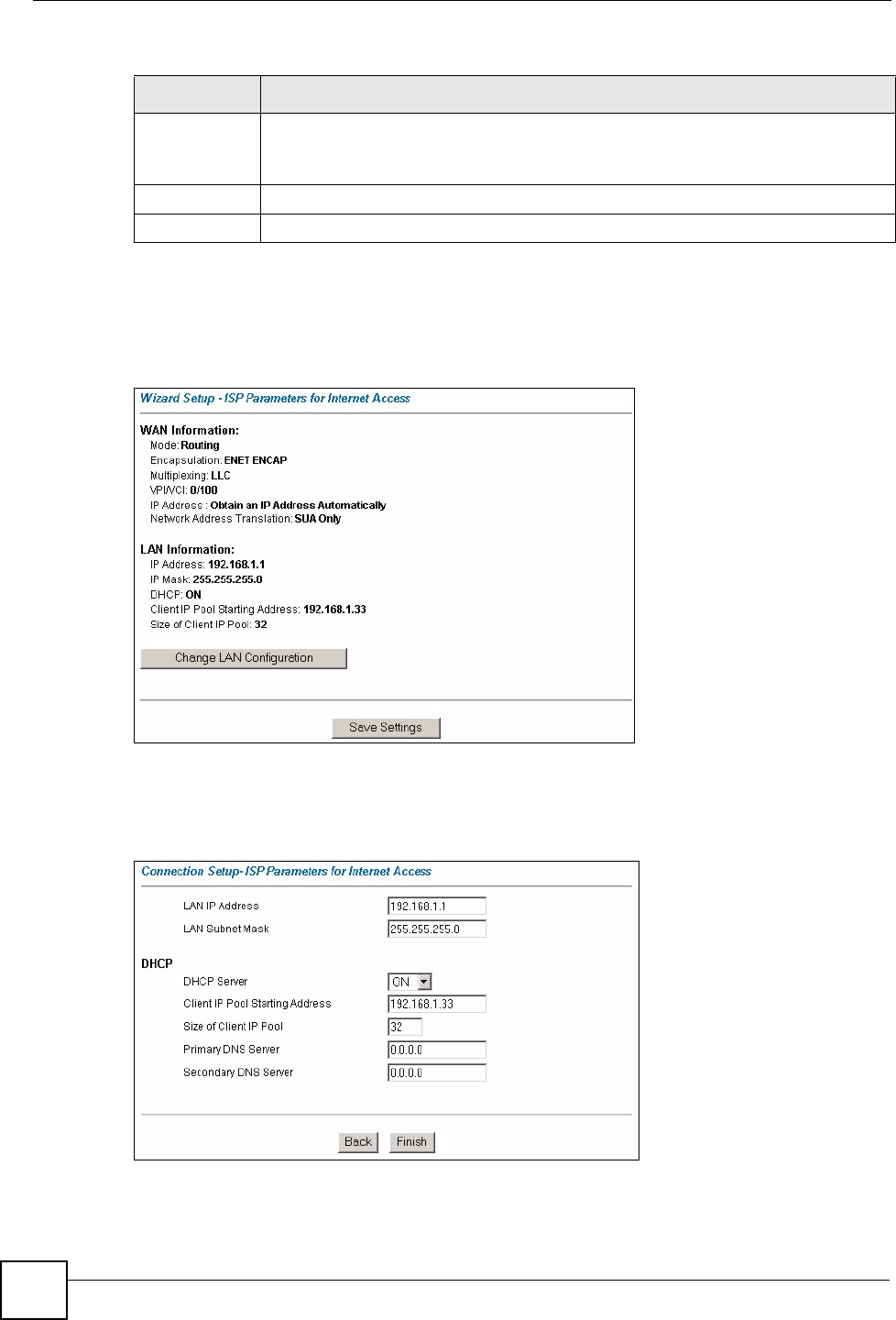
Chapter 3 Connection Setup Wizard
P-660W-Tx v2 User’s Guide
46
3Verify the settings in the screen shown next. To change the LAN information on the
ZyXEL Device, click Change LAN Configurations. Otherwise click Save Settings to
save the configuration and skip to the section 3.13.
Figure 11 Internet Access Wizard Setup: Third Screen
If you want to change your ZyXEL Device LAN settings, click Change LAN Configuration
to display the screen as shown next.
Figure 12 Internet Access Wizard Setup: LAN Configuration
Network
Address
Translation
This option is available if you select Routing in the Mode field.
Select None, SUA Only or Full Feature from the drop-sown list box. Refer to the NAT
chapter for more details.
Back Click Back to go back to the first wizard screen.
Next Click Next to continue to the next wizard screen.
Table 9 Internet Connection with PPPoA (continued)
LABEL DESCRIPTION
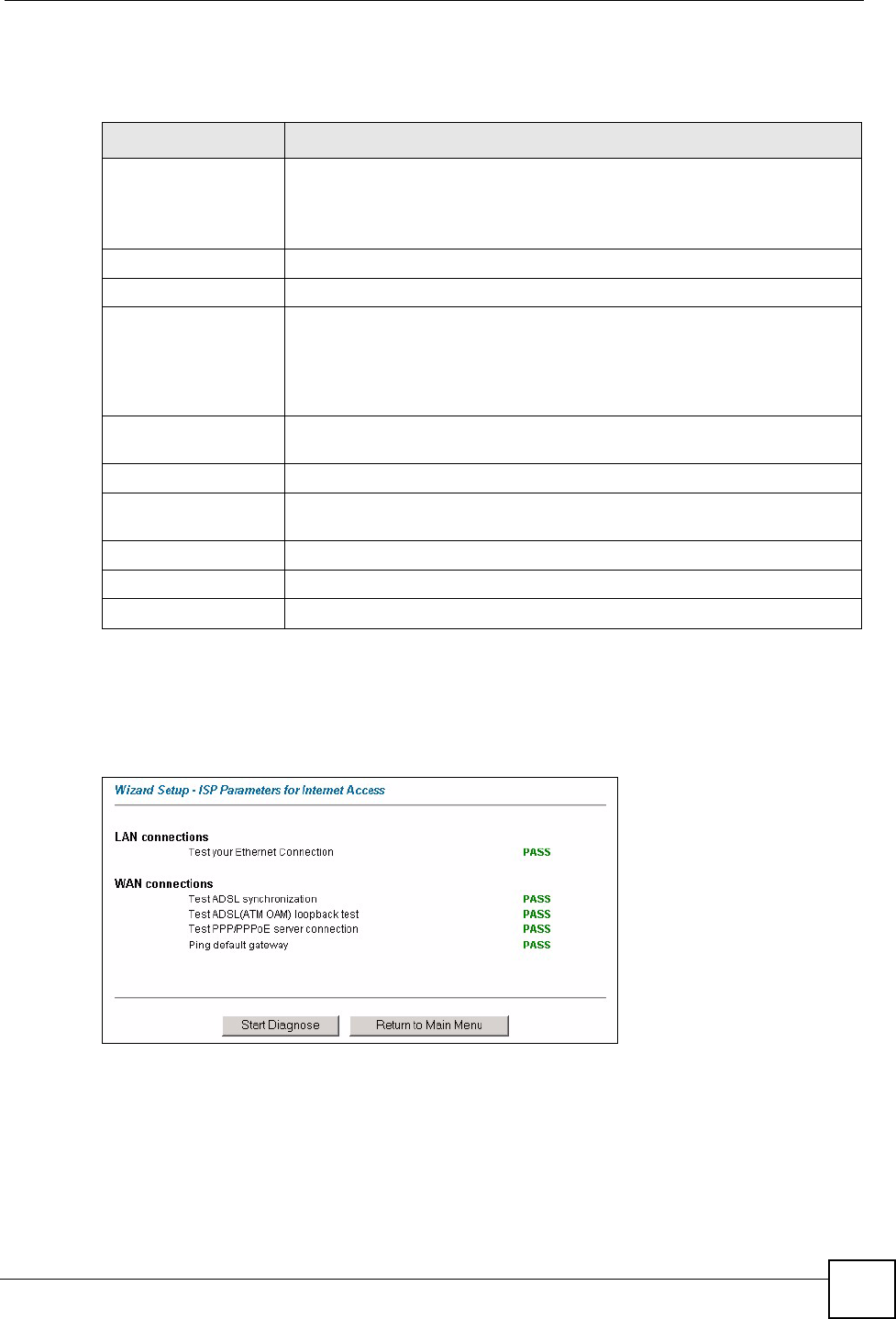
Chapter 3 Connection Setup Wizard
P-660W-Tx v2 User’s Guide 47
The following table describes the fields in this screen.
4The ZyXEL Device automatically tests the connection to the computer(s) connected to
the LAN ports. To test the connection from the ZyXEL Device to the ISP, click Start
Diagnose. Otherwise click Return to Main Menu to go back to the Site Map screen.
Figure 13 Internet Access Wizard Setup: Connection Tests
Launch your web browser and navigate to www.zyxel.com. Refer to the rest of this guide for
more detailed information on the complete range of ZyXEL Device features. If you cannot
access the Internet, open the web configurator again to confirm that the Internet settings you
configured in the Wizard Setup are correct.
Table 10 Internet Access Wizard Setup: LAN Configuration
LABEL DESCRIPTION
LAN IP Address Enter the IP address of your ZyXEL Device in dotted decimal notation, for
example, 192.168.1.1 (factory default).
If you changed the ZyXEL Device's LAN IP address, you must use the new IP
address if you want to access the web configurator again.
LAN Subnet Mask Enter a subnet mask in dotted decimal notation.
DHCP
DHCP Server From the DHCP Server drop-down list box, select On to allow your ZyXEL
Device to assign IP addresses, an IP default gateway and DNS servers to
computer systems that support the DHCP client. Select Off to disable DHCP
server.
When DHCP server is used, set the following items:
Client IP Pool Starting
Address
This field specifies the first of the contiguous addresses in the IP address
pool.
Size of Client IP Pool This field specifies the size or count of the IP address pool.
Primary DNS Server Enter the IP addresses of the DNS servers. The DNS servers are passed to
the DHCP clients along with the IP address and the subnet mask.
Secondary DNS Server As above.
Back Click Back to go back to the previous screen.
Finish Click Finish to save the settings and proceed to the next wizard screen.

Chapter 3 Connection Setup Wizard
P-660W-Tx v2 User’s Guide
48

P-660W-Tx v2 User’s Guide 49
CHAPTER 4
Media Bandwidth Management
Wizard
4.1 Introduction
Bandwidth management allows you to allocate priority to different kinds of traffic on your
network to ensure the smoother flow of network traffic. For example, you can allocate a high
priority to XBox Live traffic. Use the Media Bandwidth Management (MBM) Wizard screens
to configure bandwidth management on your ZyXEL Device.
"See Chapter 17 on page 165 for background information on Media Bandwidth
Management.
4.1.1 Media Bandwidth Management Wizard
1 In the SITE MAP screen click Media Bandwidth Management Wizard to display the
first wizard screen.
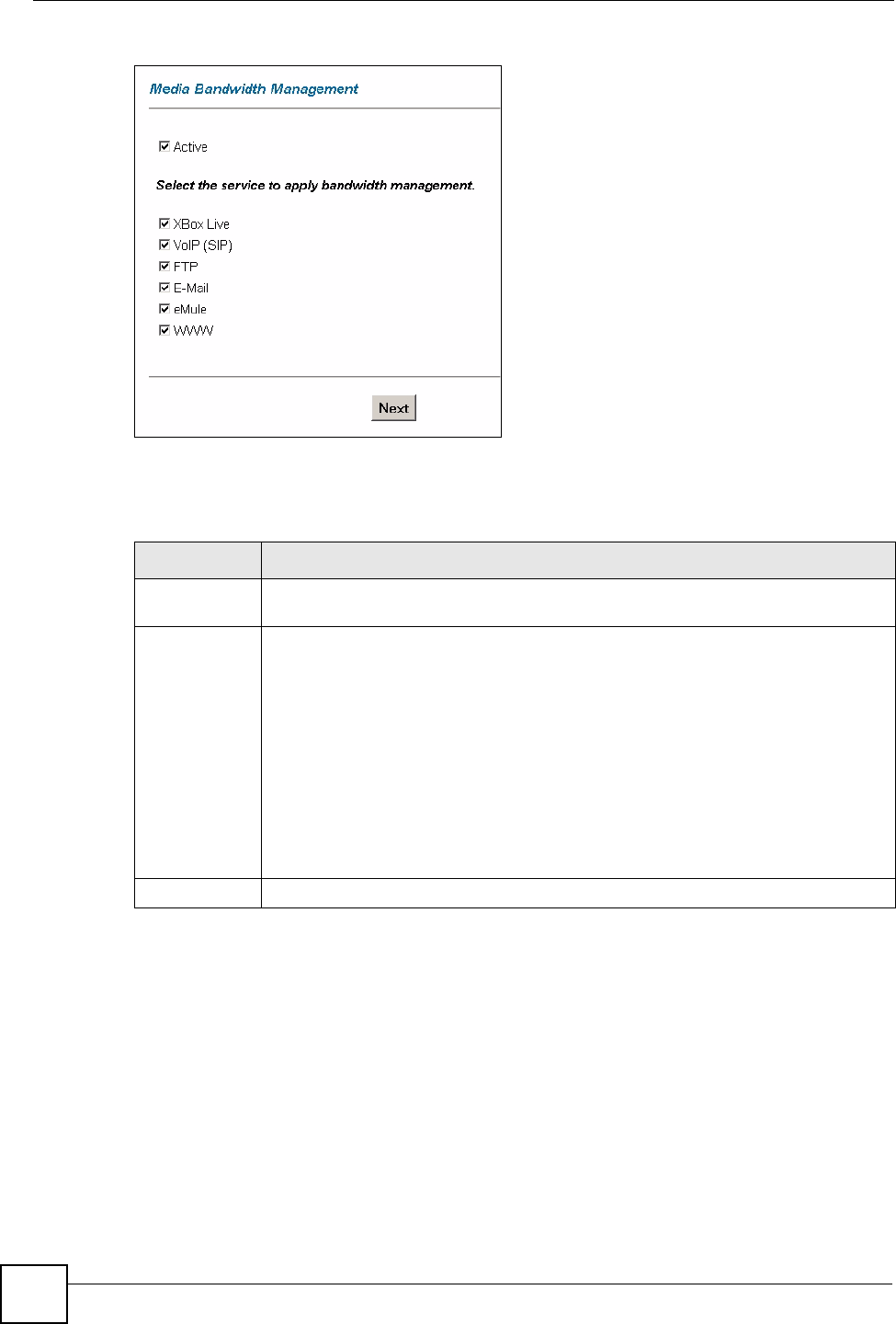
Chapter 4 Media Bandwidth Management Wizard
P-660W-Tx v2 User’s Guide
50
Figure 14 MBM Wizard: Media Bandwidth Management
The following table describes the fields in this screen.
2Configure levels of priority for the services you have selected in the next screen.
Table 11 MBM Wizard: Media Bandwidth Management
LABEL DESCRIPTION
Active Select Active to enable the Media Bandwidth Management feature on your ZyXEL
Device.
Select the
service to apply
bandwidth
management
Select the traffic type(s) to which you want to allocate priority. You can select the
following:
XBox Live - a game playing device used for gaming on the Internet, as well as
playing media files such as videos.
VoIP (SIP) - Voice over IP, this allows you to make calls over the Internet using a SIP
server.
FTP - File Transfer Protocol, a service used for downloading files.
E-Mail - the email application used on your computer, rather than web-based email.
eMule - a file-sharing application
WWW - the World Wide Web
If you do not use a service, it is not necessary to set a priority for that service.
Next Click Next to continue with the Wizard.
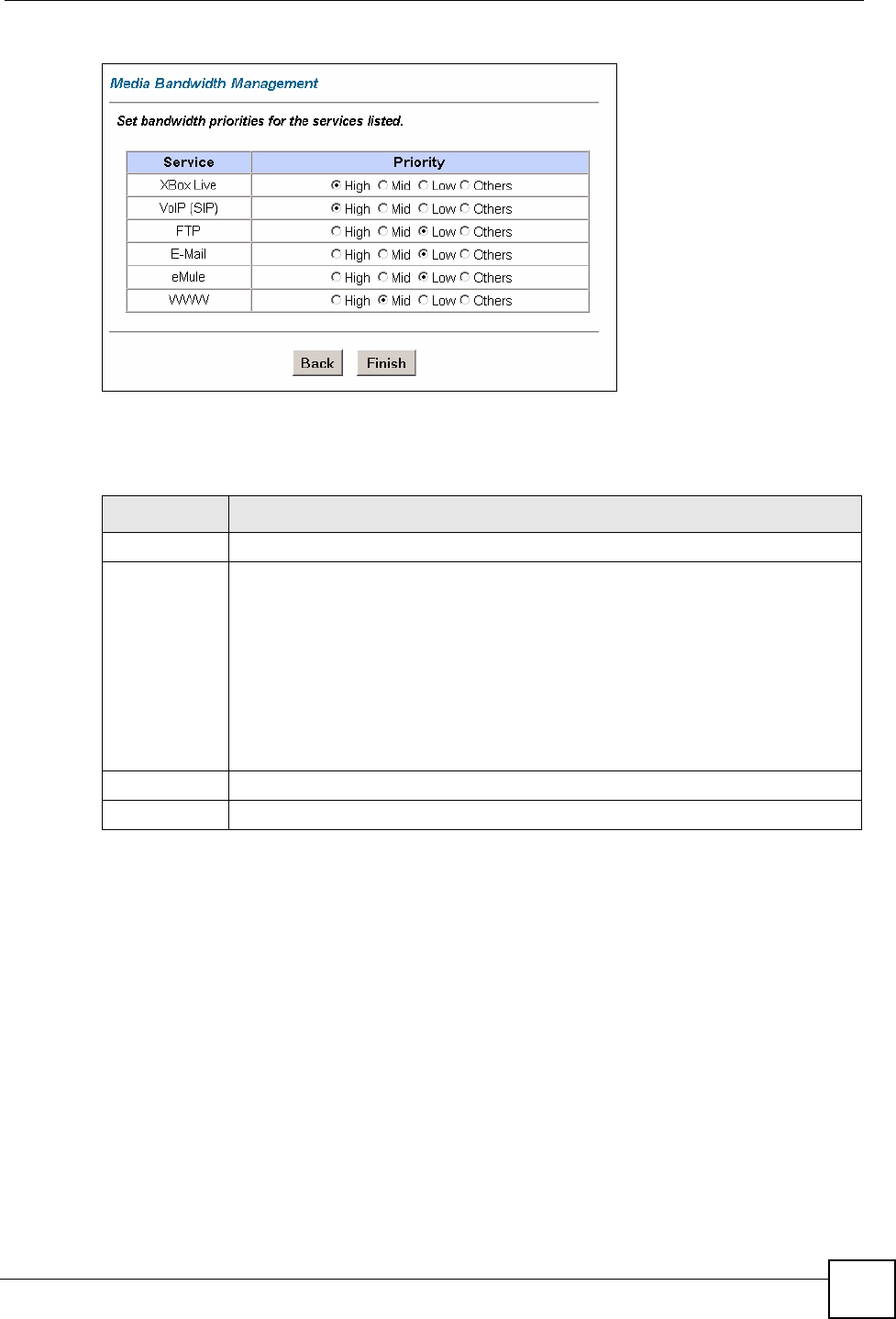
Chapter 4 Media Bandwidth Management Wizard
P-660W-Tx v2 User’s Guide 51
Figure 15 MBM Wizard: Media Bandwidth Management
The following table describes the fields in this screen.
Table 12 MBM Wizard: Media Bandwidth Management
LABEL DESCRIPTION
Service This field lists the services selected in the previous screen
Priority Select a priority level for each service you have specified in the previous screen. The
options are High, Mid, Low and Others.
Give voice and video applications a high priority, as quality is affected by transmission
delays. VoIP is a voice service and XBox Live is a video service, so they should
receive a high priority.
Give Internet browsing a medium level priority as quality is not noticeably affected by
brief delays.
Give data transfer services such as eMule, FTP or E-Mail a low priority as quality is
not affected by delays in transmission.
Select Others for applications to which you do not want to apply QoS.
Back Click Back to return to the previous screen.
Finish Click Finish to save your settings and return to the main menu.

Chapter 4 Media Bandwidth Management Wizard
P-660W-Tx v2 User’s Guide
52

53
PART III
Advanced Setup
LAN Setup (55)
Wireless LAN (65)
WA N Se tu p ( 81 )
Network Address Translation (NAT) Screens (93)
Dynamic DNS Setup (103)
Time and Date (105)
Firewalls (107)
Firewall Configuration (119)
Content Filtering (139)
Remote Management Configuration (143)
Universal Plug-and-Play (UPnP) (147)
Logs Screens (159)
Media Bandwidth Management Advanced Setup (165)

54
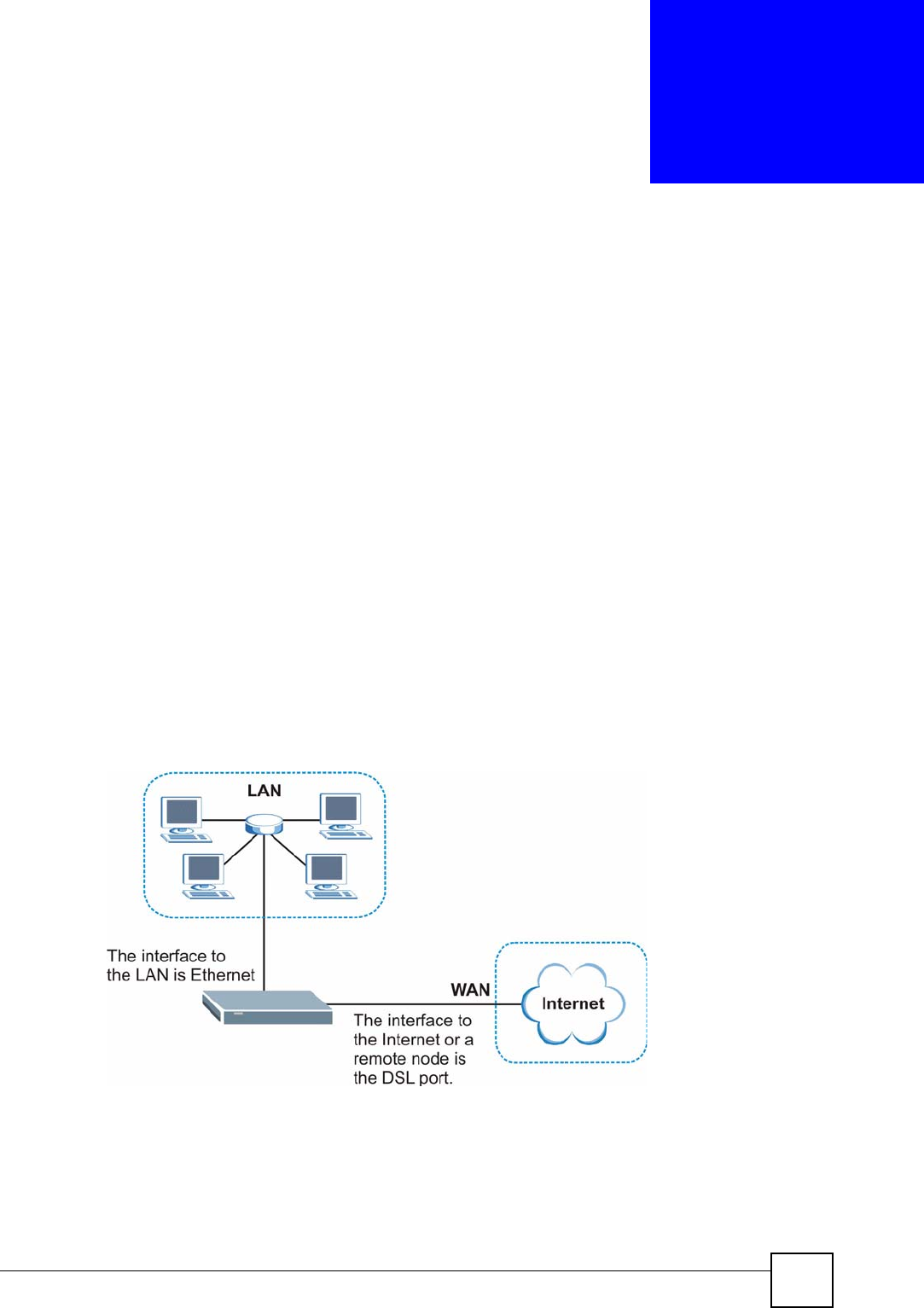
P-660W-Tx v2 User’s Guide 55
CHAPTER 5
LAN Setup
This chapter describes how to configure LAN settings.
5.1 LAN Overview
A Local Area Network (LAN) is a shared communication system to which many computers
are attached. A LAN is a computer network limited to the immediate area, usually the same
building or floor of a building. The LAN screens can help you configure a LAN DHCP server
and manage IP addresses.
See Section 5.3 on page 60 to configure the LAN screens.
5.1.1 LANs, WANs and the ZyXEL Device
The actual physical connection determines whether the ZyXEL Device ports are LAN or
WAN ports. There are two separate IP networks, one inside the LAN network and the other
outside the WAN network as shown next.
Figure 16 LAN and WAN IP Addresses

Chapter 5 LAN Setup
P-660W-Tx v2 User’s Guide
56
5.1.2 DHCP Setup
DHCP (Dynamic Host Configuration Protocol, RFC 2131 and RFC 2132) allows individual
clients to obtain TCP/IP configuration at start-up from a server. You can configure the ZyXEL
Device as a DHCP server or disable it. When configured as a server, the ZyXEL Device
provides the TCP/IP configuration for the clients. If you turn DHCP service off, you must
have another DHCP server on your LAN, or else the computer must be manually configured.
5.1.2.1 IP Pool Setup
The ZyXEL Device is pre-configured with a pool of IP addresses for the DHCP clients (DHCP
Pool). See the product specifications in the appendices. Do not assign static IP addresses from
the DHCP pool to your LAN computers.
5.1.3 DNS Server Address
DNS (Domain Name System) is for mapping a domain name to its corresponding IP address
and vice versa. The DNS server is extremely important because without it, you must know the
IP address of a machine before you can access it. The DNS server addresses that you enter in
the DHCP setup are passed to the client machines along with the assigned IP address and
subnet mask.
There are two ways that an ISP disseminates the DNS server addresses. The first is for an ISP
to tell a customer the DNS server addresses, usually in the form of an information sheet, when
s/he signs up. If your ISP gives you the DNS server addresses, enter them in the DNS Server
fields in DHCP Setup, otherwise, leave them blank.
Some ISP’s choose to pass the DNS servers using the DNS server extensions of PPP IPCP (IP
Control Protocol) after the connection is up. If your ISP did not give you explicit DNS servers,
chances are the DNS servers are conveyed through IPCP negotiation. The ZyXEL Device
supports the IPCP DNS server extensions through the DNS proxy feature.
If the Primary and Secondary DNS Server fields in the LAN Setup screen are not specified,
for instance, left as 0.0.0.0, the ZyXEL Device tells the DHCP clients that it itself is the DNS
server. When a computer sends a DNS query to the ZyXEL Device, the ZyXEL Device
forwards the query to the real DNS server learned through IPCP and relays the response back
to the computer.
Please note that DNS proxy works only when the ISP uses the IPCP DNS server extensions. It
does not mean you can leave the DNS servers out of the DHCP setup under all circumstances.
If your ISP gives you explicit DNS servers, make sure that you enter their IP addresses in the
LAN Setup screen. This way, the ZyXEL Device can pass the DNS servers to the computers
and the computers can query the DNS server directly without the ZyXEL Device’s
intervention.
5.1.4 DNS Server Address Assignment
Use DNS (Domain Name System) to map a domain name to its corresponding IP address and
vice versa. The DNS server is extremely important because without it, you must know the IP
address of a computer before you can access it.
There are two ways that an ISP disseminates the DNS server addresses.

Chapter 5 LAN Setup
P-660W-Tx v2 User’s Guide 57
• The ISP tells you the DNS server addresses, usually in the form of an information sheet,
when you sign up. If your ISP gives you DNS server addresses, enter them in the DNS
Server fields in the LAN Setup screen.
• The ZyXEL Device acts as a DNS proxy when the Primary and Secondary DNS Server
fields are left blank in the LAN Setup screen.
5.2 LAN TCP/IP
The ZyXEL Device has built-in DHCP server capability that assigns IP addresses and DNS
servers to systems that support DHCP client capability.
5.2.1 IP Address and Subnet Mask
Similar to the way houses on a street share a common street name, so too do computers on a
LAN share one common network number.
Where you obtain your network number depends on your particular situation. If the ISP or
your network administrator assigns you a block of registered IP addresses, follow their
instructions in selecting the IP addresses and the subnet mask.
If the ISP did not explicitly give you an IP network number, then most likely you have a single
user account and the ISP will assign you a dynamic IP address when the connection is
established. If this is the case, it is recommended that you select a network number from
192.168.0.0 to 192.168.255.0 and you must enable the Network Address Translation (NAT)
feature of the ZyXEL Device. The Internet Assigned Number Authority (IANA) reserved this
block of addresses specifically for private use; please do not use any other number unless you
are told otherwise. Let's say you select 192.168.1.0 as the network number; which covers 254
individual addresses, from 192.168.1.1 to 192.168.1.254 (zero and 255 are reserved). In other
words, the first three numbers specify the network number while the last number identifies an
individual computer on that network.
Once you have decided on the network number, pick an IP address that is easy to remember,
for instance, 192.168.1.1, for your ZyXEL Device, but make sure that no other device on your
network is using that IP address.
The subnet mask specifies the network number portion of an IP address. Your ZyXEL Device
will compute the subnet mask automatically based on the IP address that you entered. You
don't need to change the subnet mask computed by the ZyXEL Device unless you are
instructed to do otherwise.
5.2.1.1 Private IP Addresses
Every machine on the Internet must have a unique address. If your networks are isolated from
the Internet, for example, only between your two branch offices, you can assign any IP
addresses to the hosts without problems. However, the Internet Assigned Numbers Authority
(IANA) has reserved the following three blocks of IP addresses specifically for private
networks:
• 10.0.0.0 — 10.255.255.255
• 172.16.0.0 — 172.31.255.255
• 192.168.0.0 — 192.168.255.255

Chapter 5 LAN Setup
P-660W-Tx v2 User’s Guide
58
You can obtain your IP address from the IANA, from an ISP or it can be assigned from a
private network. If you belong to a small organization and your Internet access is through an
ISP, the ISP can provide you with the Internet addresses for your local networks. On the other
hand, if you are part of a much larger organization, you should consult your network
administrator for the appropriate IP addresses.
" Regardless of your particular situation, do not create an arbitrary IP address;
always follow the guidelines above. For more information on address
assignment, please refer to RFC 1597, Address Allocation for Private Internets
and RFC 1466, Guidelines for Management of IP Address Space.
5.2.2 RIP Setup
RIP (Routing Information Protocol) allows a router to exchange routing information with
other routers. The RIP Direction field controls the sending and receiving of RIP packets.
When set to:
•Both - the ZyXEL Device will broadcast its routing table periodically and incorporate the
RIP information that it receives.
•In Only - the ZyXEL Device will not send any RIP packets but will accept all RIP packets
received.
•Out Only - the ZyXEL Device will send out RIP packets but will not accept any RIP
packets received.
•None - the ZyXEL Device will not send any RIP packets and will ignore any RIP packets
received.
The Version field controls the format and the broadcasting method of the RIP packets that the
ZyXEL Device sends (it recognizes both formats when receiving). RIP-1 is universally
supported; but RIP-2 carries more information. RIP-1 is probably adequate for most networks,
unless you have an unusual network topology.
Both RIP-2B and RIP-2M sends the routing data in RIP-2 format; the difference being that
RIP-2B uses subnet broadcasting while RIP-2M uses multicasting.
5.2.3 Multicast
Traditionally, IP packets are transmitted in one of either two ways - Unicast (1 sender - 1
recipient) or Broadcast (1 sender - everybody on the network). Multicast delivers IP packets to
a group of hosts on the network - not everybody and not just 1.
IGMP (Internet Group Multicast Protocol) is a network-layer protocol used to establish
membership in a Multicast group - it is not used to carry user data. IGMP version 2 (RFC
2236) is an improvement over version 1 (RFC 1112) but IGMP version 1 is still in wide use. If
you would like to read more detailed information about interoperability between IGMP
version 2 and version 1, please see sections 4 and 5 of RFC 2236. The class D IP address is
used to identify host groups and can be in the range 224.0.0.0 to 239.255.255.255. The address
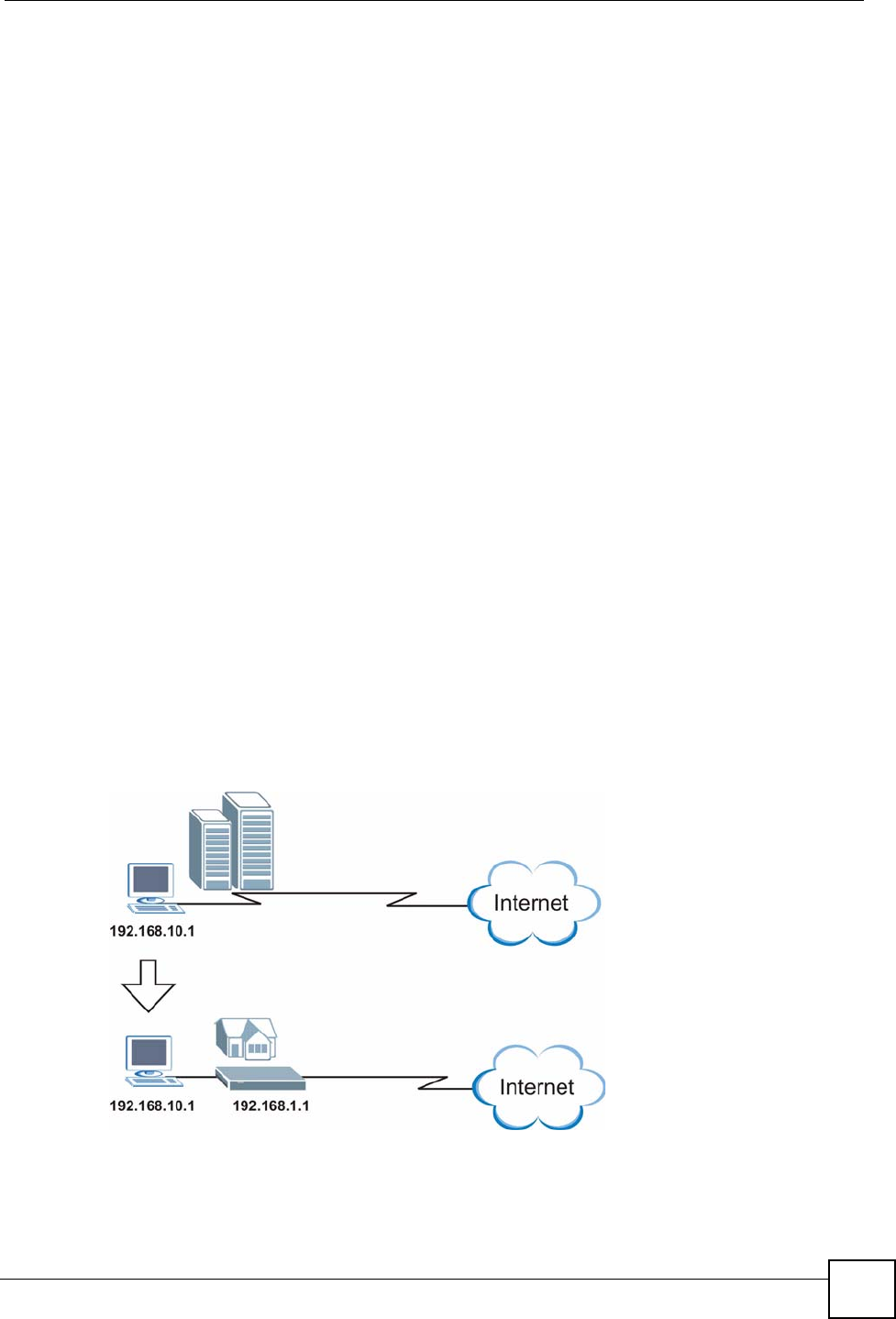
Chapter 5 LAN Setup
P-660W-Tx v2 User’s Guide 59
224.0.0.0 is not assigned to any group and is used by IP multicast computers. The address
224.0.0.1 is used for query messages and is assigned to the permanent group of all IP hosts
(including gateways). All hosts must join the 224.0.0.1 group in order to participate in IGMP.
The address 224.0.0.2 is assigned to the multicast routers group.
The ZyXEL Device supports both IGMP version 1 (IGMP-v1) and IGMP version 2 (IGMP-
v2). At start up, the ZyXEL Device queries all directly connected networks to gather group
membership. After that, the ZyXEL Device periodically updates this information. IP
multicasting can be enabled/disabled on the ZyXEL Device LAN and/or WAN interfaces in
the web configurator (LAN; WAN ). Select None to disable IP multicasting on these
interfaces.
5.2.4 Any IP
Traditionally, you must set the IP addresses and the subnet masks of a computer and the
ZyXEL Device to be in the same subnet to allow the computer to access the Internet (through
the ZyXEL Device). In cases where your computer is required to use a static IP address in
another network, you may need to manually configure the network settings of the computer
every time you want to access the Internet via the ZyXEL Device.
With the Any IP feature and NAT enabled, the ZyXEL Device allows a computer to access the
Internet without changing the network settings (such as IP address and subnet mask) of the
computer, when the IP addresses of the computer and the ZyXEL Device are not in the same
subnet. Whether a computer is set to use a dynamic or static (fixed) IP address, you can simply
connect the computer to the ZyXEL Device and access the Internet.
The following figure depicts a scenario where a computer is set to use a static private IP
address in the corporate environment. In a residential house where a ZyXEL Device is
installed, you can still use the computer to access the Internet without changing the network
settings, even when the IP addresses of the computer and the ZyXEL Device are not in the
same subnet.
Figure 17 Any IP Example
The Any IP feature does not apply to a computer using either a dynamic IP address or a static
IP address that is in the same subnet as the ZyXEL Device’s IP address.

Chapter 5 LAN Setup
P-660W-Tx v2 User’s Guide
60
"You must enable NAT/SUA to use the Any IP feature on the ZyXEL Device.
5.2.4.1 How Any IP Works
Address Resolution Protocol (ARP) is a protocol for mapping an Internet Protocol address (IP
address) to a physical machine address, also known as a Media Access Control or MAC
address, on the local area network. IP routing table is defined on IP Ethernet devices (the
ZyXEL Device) to decide which hop to use, to help forward data along to its specified
destination.
The following lists out the steps taken, when a computer tries to access the Internet for the first
time through the ZyXEL Device.
1When a computer (which is in a different subnet) first attempts to access the Internet, it
sends packets to its default gateway (which is not the ZyXEL Device) by looking at the
MAC address in its ARP table.
2When the computer cannot locate the default gateway, an ARP request is broadcast on
the LAN.
3The ZyXEL Device receives the ARP request and replies to the computer with its own
MAC address.
4The computer updates the MAC address for the default gateway to the ARP table. Once
the ARP table is updated, the computer is able to access the Internet through the ZyXEL
Device.
5When the ZyXEL Device receives packets from the computer, it creates an entry in the
IP routing table so it can properly forward packets intended for the computer.
After all the routing information is updated, the computer can access the ZyXEL Device and
the Internet as if it is in the same subnet as the ZyXEL Device.
5.3 Configuring LAN
Click LAN > LAN Setup to open the LAN Setup screen. See Section 5.1 on page 55 for
background information.
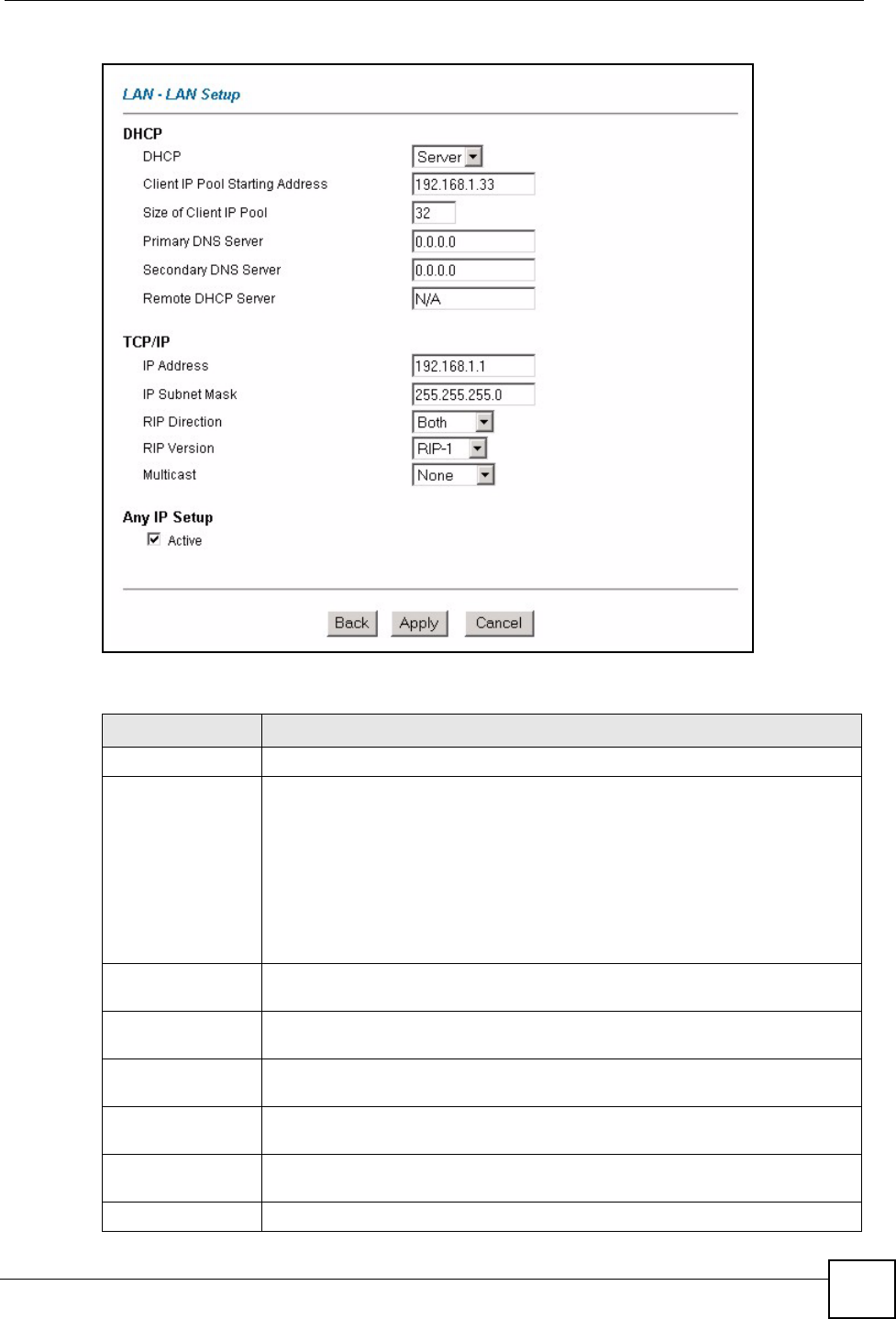
Chapter 5 LAN Setup
P-660W-Tx v2 User’s Guide 61
Figure 18 LAN Setup
The following table describes the fields in this screen.
Table 13 LAN Setup
LABEL DESCRIPTION
DHCP
DHCP If set to Server, your ZyXEL Device can assign IP addresses, an IP default
gateway and DNS servers to Windows 95, Windows NT and other systems that
support the DHCP client.
If set to None, the DHCP server will be disabled.
If set to Relay, the ZyXEL Device acts as a surrogate DHCP server and relays
DHCP requests and responses between the remote server and the clients. Enter
the IP address of the actual, remote DHCP server in the Remote DHCP Server
field in this case.
When DHCP is used, the following items need to be set:
Client IP Pool
Starting Address
This field specifies the first of the contiguous addresses in the IP address pool.
Size of Client IP
Pool
This field specifies the size or count of the IP address pool.
Primary DNS
Server
Enter the IP addresses of the DNS servers. The DNS servers are passed to the
DHCP clients along with the IP address and the subnet mask.
Secondary DNS
Server
As above.
Remote DHCP
Server
If Relay is selected in the DHCP field above then enter the IP address of the
actual remote DHCP server here.
TCP/IP
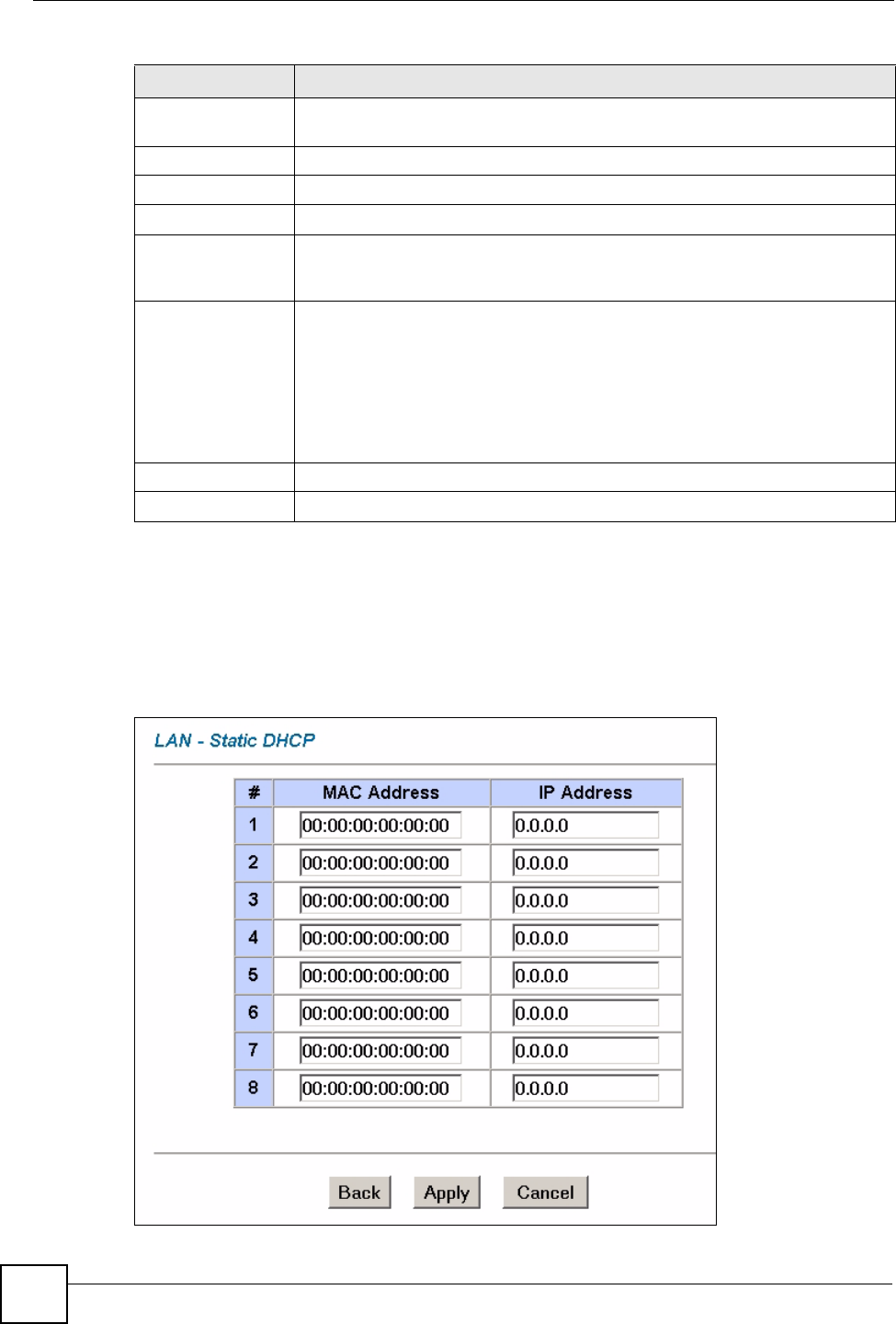
Chapter 5 LAN Setup
P-660W-Tx v2 User’s Guide
62
5.4 Configuring Static DHCP
Click LAN > Static DHCP to open the Static DHCP screen. See Section 5.1.2 on page 56 for
background information.
Figure 19 LAN > Static DHCP
IP Address Enter the IP address of your ZyXEL Device in dotted decimal notation, for
example, 192.168.1.1 (factory default).
IP Subnet Mask Type the subnet mask assigned to you by your ISP (if given).
RIP Direction Select the RIP direction from None, Both, In Only and Out Only.
RIP Version Select the RIP version from RIP-1, RIP-2B and RIP-2M.
Multicast IGMP (Internet Group Multicast Protocol) is a network-layer protocol used to
establish membership in a multicast group. The ZyXEL Device supports both
IGMP version 1 (IGMP-v1) and IGMP-v2. Select None to disable it.
Any IP Setup Select the Active check box to enable the Any IP feature. This allows a
computer to access the Internet without changing the network settings (such as
IP address and subnet mask) of the computer, even when the IP addresses of
the computer and the ZyXEL Device are not in the same subnet.
When you disable the Any IP feature, only computers with dynamic IP addresses
or static IP addresses in the same subnet as the ZyXEL Device’s LAN IP
address can connect to the ZyXEL Device or access the Internet through the
ZyXEL Device.
Apply Click Apply to save your changes back to the ZyXEL Device.
Cancel Click Cancel to begin configuring this screen afresh.
Table 13 LAN Setup (continued)
LABEL DESCRIPTION

Chapter 5 LAN Setup
P-660W-Tx v2 User’s Guide 63
The following table describes the fields in this screen.
Table 14 LAN Setup
LABEL DESCRIPTION
# This is the index number for the entries in this table.
MAC Address Type the MAC address of the device for which you are configuring the IP
address. Use hexadecimal characters in the following format:
“0A:A0:00:BB:CC:DD”
IP Address Type the IP address for the device you are configuring in dotted decimal
notation, for example, “150.222.0.1”.
Back Click Back to return to the previous screen.
Apply Click Apply to save your changes back to the ZyXEL Device.
Cancel Click Cancel to begin configuring this screen afresh.

Chapter 5 LAN Setup
P-660W-Tx v2 User’s Guide
64
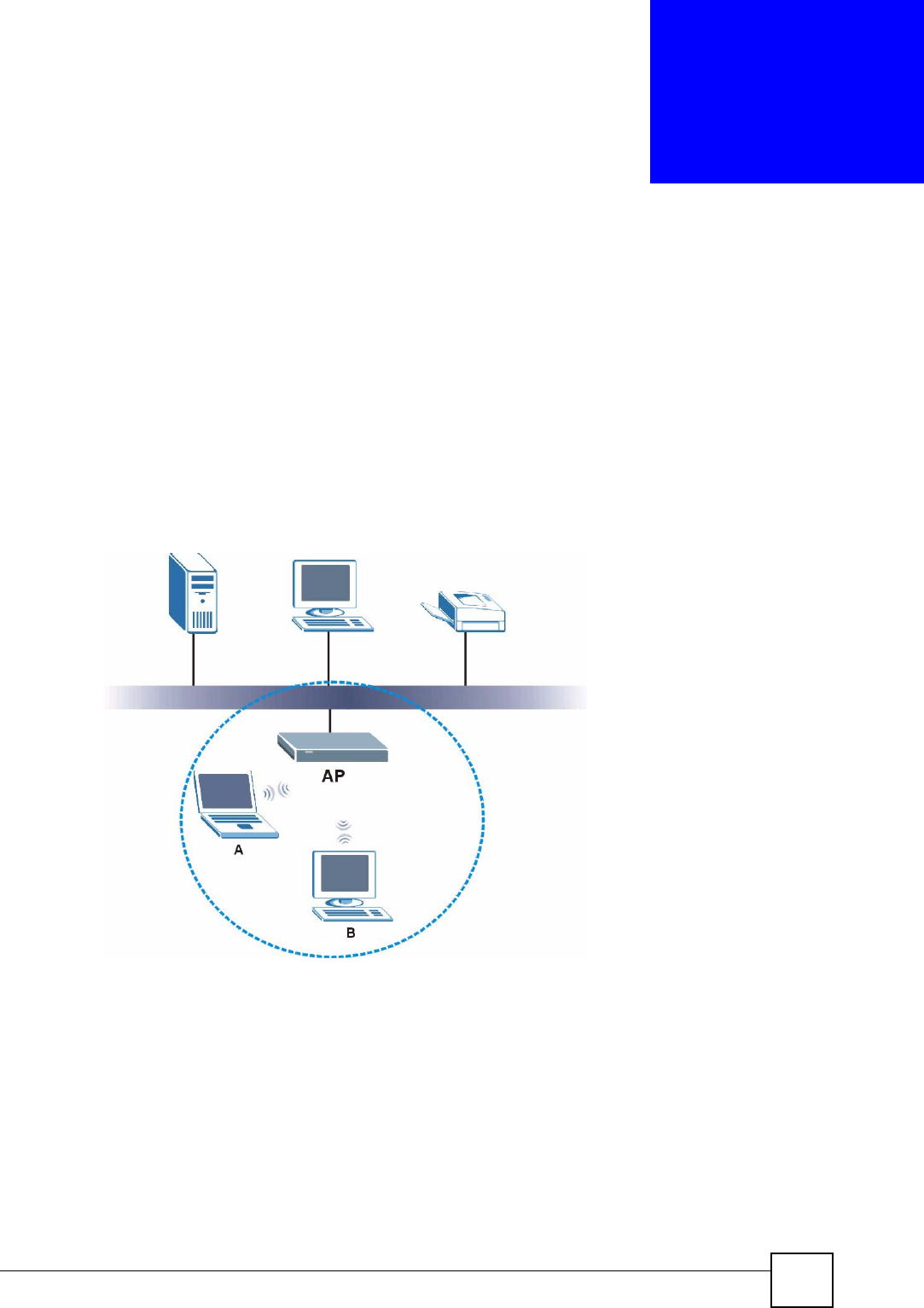
P-660W-Tx v2 User’s Guide 65
CHAPTER 6
Wireless LAN
This chapter discusses how to configure the wireless network settings in your ZyXEL Device.
See the appendices for more detailed information about wireless networks.
6.1 Wireless Network Overview
The following figure provides an example of a wireless network.
Figure 20 Example of a Wireless Network
The wireless network is the part in the blue circle. In this wireless network, devices A and B
are called wireless clients.The wireless clients use the access point (AP) to interact with other
devices (such as the printer) or with the Internet. Your ZyXEL Device is the AP.
Every wireless network must follow these basic guidelines.
• Every wireless client in the same wireless network must use the same SSID.
The SSID is the name of the wireless network. It stands for Service Set IDentity.
• If two wireless networks overlap, they should use different channels.
Like radio stations or television channels, each wireless network uses a specific channel,
or frequency, to send and receive information.

Chapter 6 Wireless LAN
P-660W-Tx v2 User’s Guide
66
• Every wireless client in the same wireless network must use security compatible with the
AP.
Security stops unauthorized devices from using the wireless network. It can also protect
the information that is sent in the wireless network.
6.2 Wireless Security Overview
The following sections introduce different types of wireless security you can set up in the
wireless network.
6.2.1 SSID
Normally, the AP acts like a beacon and regularly broadcasts the SSID in the area. You can
hide the SSID instead, in which case the AP does not broadcast the SSID. In addition, you
should change the default SSID to something that is difficult to guess.
This type of security is fairly weak, however, because there are ways for unauthorized devices
to get the SSID. In addition, unauthorized devices can still see the information that is sent in
the wireless network.
6.2.2 MAC Address Filter
Every wireless client has a unique identification number, called a MAC address.1 A MAC
address is usually written using twelve hexadecimal characters2; for example, 00A0C5000002
or 00:A0:C5:00:00:02. To get the MAC address for each wireless client, see the appropriate
User’s Guide or other documentation.
You can use the MAC address filter to tell the AP which wireless clients are allowed or not
allowed to use the wireless network. If a wireless client is allowed to use the wireless network,
it still has to have the correct settings (SSID, channel, and security). If a wireless client is not
allowed to use the wireless network, it does not matter if it has the correct settings.
This type of security does not protect the information that is sent in the wireless network.
Furthermore, there are ways for unauthorized devices to get the MAC address of an authorized
wireless client. Then, they can use that MAC address to use the wireless network.
6.2.3 User Authentication
You can make every user log in to the wireless network before they can use it. This is called
user authentication. However, every wireless client in the wireless network has to support
IEEE 802.1x to do this.
For wireless networks, there are two typical places to store the user names and passwords for
each user.
• In the AP: this feature is called a local user database or a local database.
• In a RADIUS server: this is a server used in businesses more than in homes.
1. Some wireless devices, such as scanners, can detect wireless networks but cannot use wireless networks.
These kinds of wireless devices might not have MAC addresses.
2. Hexadecimal characters are 0, 1, 2, 3, 4, 5, 6, 7, 8, 9, A, B, C, D, E, and F.

Chapter 6 Wireless LAN
P-660W-Tx v2 User’s Guide 67
If your AP does not provide a local user database and if you do not have a RADIUS server,
you cannot set up user names and passwords for your users.
Unauthorized devices can still see the information that is sent in the wireless network, even if
they cannot use the wireless network. Furthermore, there are ways for unauthorized wireless
users to get a valid user name and password. Then, they can use that user name and password
to use the wireless network.
Local user databases also have an additional limitation that is explained in the next section.
6.2.4 Encryption
Wireless networks can use encryption to protect the information that is sent in the wireless
network. Encryption is like a secret code. If you do not know the secret code, you cannot
understand the message.
The types of encryption you can choose depend on the type of user authentication. (See
Section 6.2.3 on page 66 for information about this.)
For example, if the wireless network has a RADIUS server, you can choose WPA or WPA2.
If users do not have to log in with a user name and password in order to access the wireless
network, you can choose no encryption, Static WEP, WPA-PSK, or WPA2-PSK.
Usually, you should set up the strongest encryption that every wireless client in the wireless
network supports. For example, suppose the AP does not have a local user database, and you
do not have a RADIUS server. Therefore, there is no user authentication. Suppose the wireless
network has two wireless clients. Device A only supports WEP, and device B supports WEP
and WPA. Therefore, you should set up Static WEP in the wireless network.
"It is recommended that wireless networks use WPA-PSK, WPA, or stronger
encryption. IEEE 802.1x and WEP encryption are better than none at all, but it
is still possible for unauthorized devices to figure out the original information
pretty quickly.
"It is not possible to use WPA-PSK, WPA or stronger encryption with a local
user database. In this case, it is better to set up stronger encryption with no
authentication than to set up weaker encryption with the local user database.
Table 15 Types of Encryption for Each Type of Authentication
NO AUTHENTICATION RADIUS SERVER
Weakest No Security WPA
Static WEP
WPA-PSK
Strongest WPA2-PSK WPA2

Chapter 6 Wireless LAN
P-660W-Tx v2 User’s Guide
68
When you select WPA2 or WPA2-PSK in your ZyXEL Device, you can also select an option
(WPA Compatible) to support WPA as well. In this case, if some wireless clients support
WPA and some support WPA2, you should set up WPA2-PSK or WPA2 (depending on the
type of wireless network login) and select the WPA Compatible option in the ZyXEL Device.
Many types of encryption use a key to protect the information in the wireless network. The
longer the key, the stronger the encryption. Every wireless client in the wireless network must
have the same key.
6.3 Additional Wireless Terms
The following table describes wireless network terms and acronyms used in the ZyXEL
Device’s Web Configurator.
6.4 The Main Wireless LAN Screen
Click Wireless LAN in the navigation panel to display the main Wireless LAN screen.
Table 16 Additional Wireless Terms
TERM DESCRIPTION
Intra-BSS Traffic This describes direct communication (not through the ZyXEL Device) between
two wireless devices within a wireless network. You might disable this kind of
communication to enhance security within your wireless network.
RTS/CTS Threshold In a wireless network which covers a large area, wireless devices are
sometimes not aware of each other’s presence. This may cause them to send
information to the AP at the same time and result in information colliding and
not getting through.
By setting this value lower than the default value, the wireless devices must
sometimes get permission to send information to the ZyXEL Device. The
lower the value, the more often the devices must get permission.
If this value is greater than the fragmentation threshold value (see below),
then wireless devices never have to get permission to send information to the
ZyXEL Device.
Preamble A preamble affects the timing in your wireless network. There are two
preamble modes: long and short. If a device uses a different preamble mode
than the ZyXEL Device does, it cannot communicate with the ZyXEL Device.
Authentication The process of verifying whether a wireless device is allowed to use the
wireless network.
Max. Frame Burst Enable this to improve the performance of both pure IEEE 802.11g and mixed
IEEE 802.11b/g networks. Maximum Frame Burst sets the maximum time that
the ZyXEL Device transmits IEEE 802.11g wireless traffic only.
Fragmentation
Threshold
A small fragmentation threshold is recommended for busy networks, while a
larger threshold provides faster performance if the network is not very busy.
Roaming If you have two or more ZyXEL Devices (or other wireless access points) on
your wireless network, you can enable this option so that wireless devices can
change locations without having to log in again. This is useful for devices,
such as notebooks, that move around a lot.
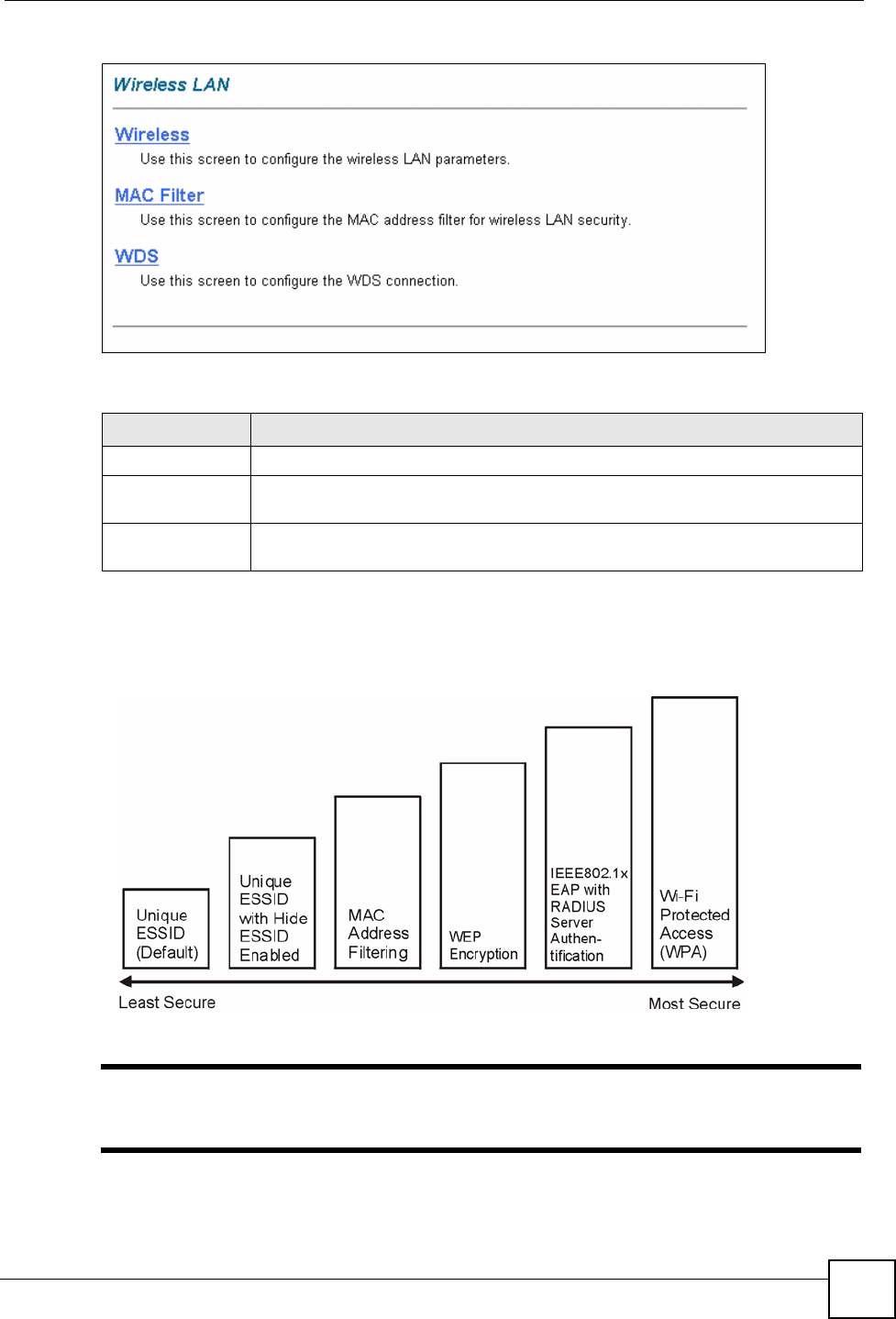
Chapter 6 Wireless LAN
P-660W-Tx v2 User’s Guide 69
Figure 21 Wireless LAN
The following table describes the links in this screen.
The following figure shows the relative effectiveness of these wireless security methods
available on your ZyXEL Device.
Figure 22 Wireless Security Methods
"You must enable the same wireless security settings on the ZyXEL Device and
on all wireless clients that you want to associate with it.
Table 17 Wireless LAN
LINK DESCRIPTION
Wireless Click this link to go to a screen where you can configure wireless settings.
MAC Filter Click this link to go to a screen where you can restrict access to your wireless
network by MAC address.
WDS Click this link to go to a screen where you can set up a WDS (Wireless Distribution
System) connection between your AP’s (access points).
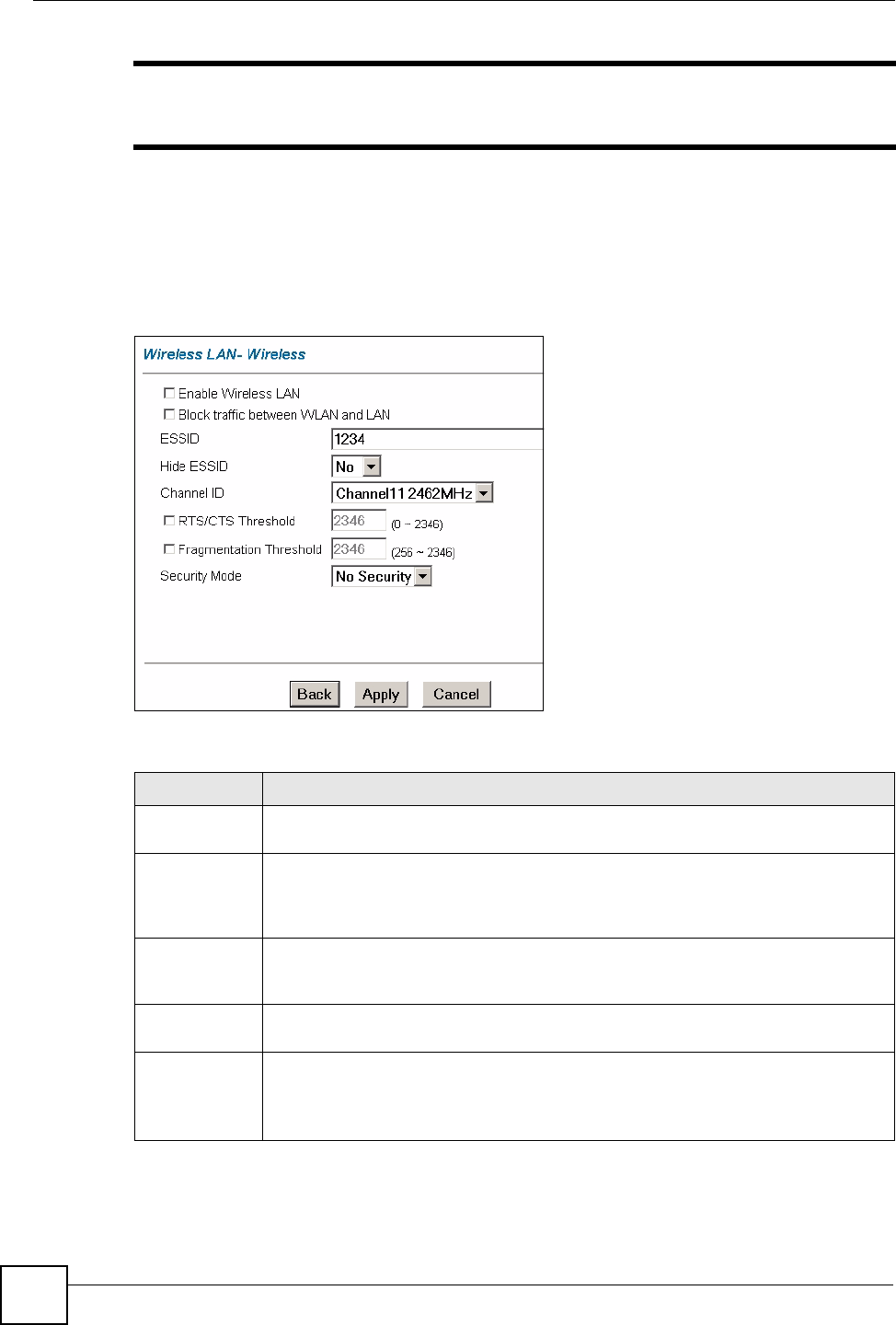
Chapter 6 Wireless LAN
P-660W-Tx v2 User’s Guide
70
"If you do not enable any wireless security on your ZyXEL Device, your network
is accessible to any wireless networking device that is within range.
6.5 Configuring the Wireless Screen
Click Advanced Setup > Wireless LAN to open the Wireless LAN screen.
Figure 23 Network > Wireless LAN
The following table describes the general wireless LAN labels in this screen.
Table 18 Network > Wireless LAN > General
LABEL DESCRIPTION
Enable
Wireless LAN
Click the check box to activate the wireless feature on your ZyXEL Device.
Block Traffic
between
WLAN and
LAN
ESSID The ESSID (Extended Service Set IDentity) identifies your wireless network. Enter a
descriptive name (up to 32 printable characters including spaces; alphabetic
characters are case-sensitive) for the wireless LAN.
Hide ESSID Select Yes to hide the ESSID from unauthorized individuals scanning for ESSIDs
using a site survey tool or select No.to make it visible to wireless devices in range.
Channel ID The range of radio frequencies used by wireless devices is called a channel.
Select a wireless channel if interference from other nearby devices is a problem. The
ZyXEL Device and other wireless devices in your wireless network must use the
same channel.
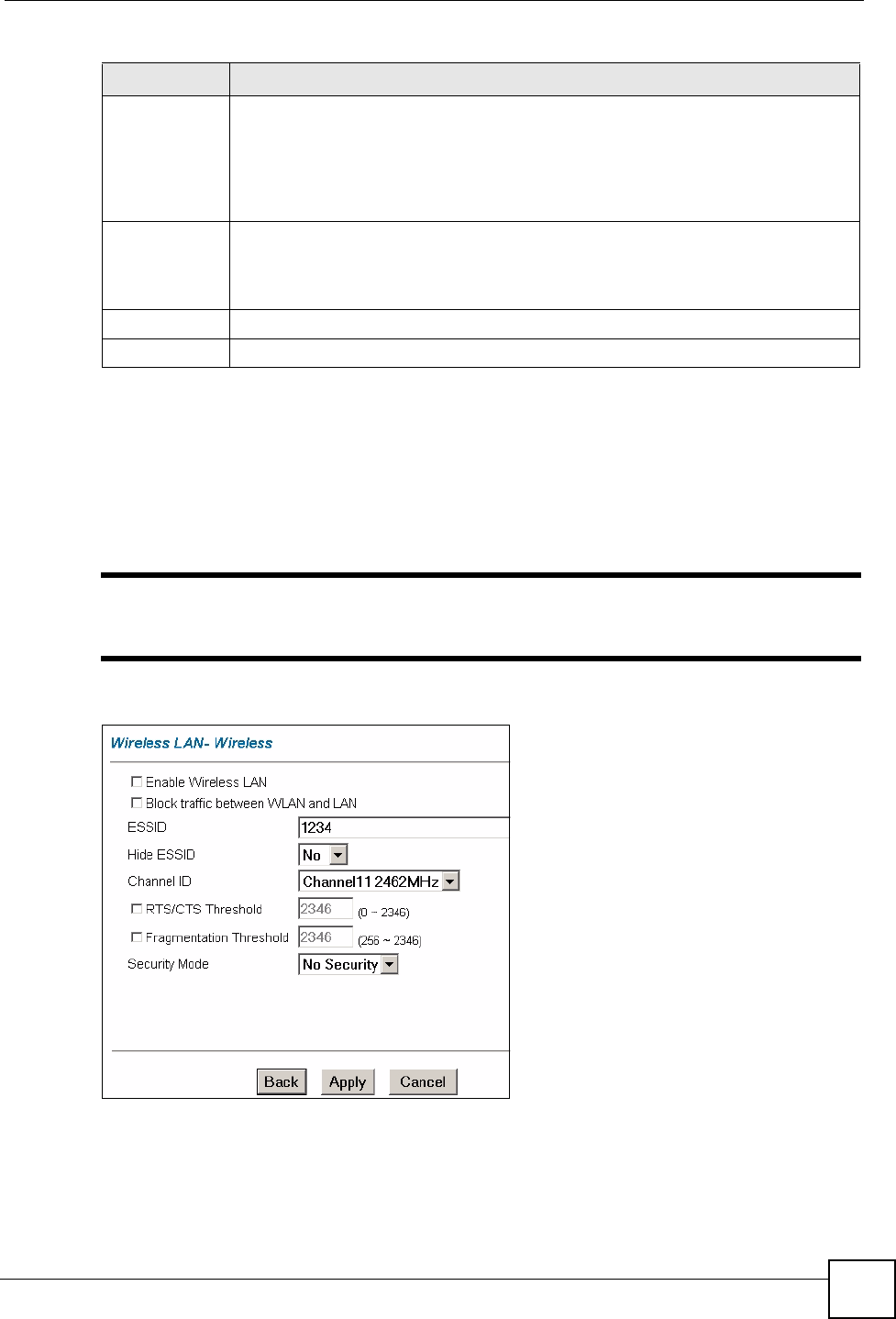
Chapter 6 Wireless LAN
P-660W-Tx v2 User’s Guide 71
See the rest of this chapter for information on the other labels in this screen.
6.5.1 No Security
Select No Security to allow wireless stations to communicate with the access points without
any data encryption.
"If you do not enable any wireless security on your ZyXEL Device, your network
is accessible to any wireless networking device that is within range.
Figure 24 Network > Wireless LAN: No Security
RTS/CTS
Threshold
The RTS (Request To Send) threshold (number of bytes) is for enabling RTS/CTS.
Data with its frame size larger than this value will perform the RTS/CTS handshake.
Setting this value to be larger than the maximum MSDU (MAC service data unit) size
turns off RTS/CTS. Setting this value to zero turns on RTS/CTS.
Select the check box to change the default value and enter a new value between 0
and 2432.
Fragmentation
Threshold
This is the threshold (number of bytes) for the fragmentation boundary for directed
messages. It is the maximum data fragment size that can be sent.
Select the check box to change the default value and enter a value between 256 and
2432.
Apply Click Apply to save your changes.
Reset Click Reset to reload the previous configuration for this screen.
Table 18 Network > Wireless LAN > General
LABEL DESCRIPTION
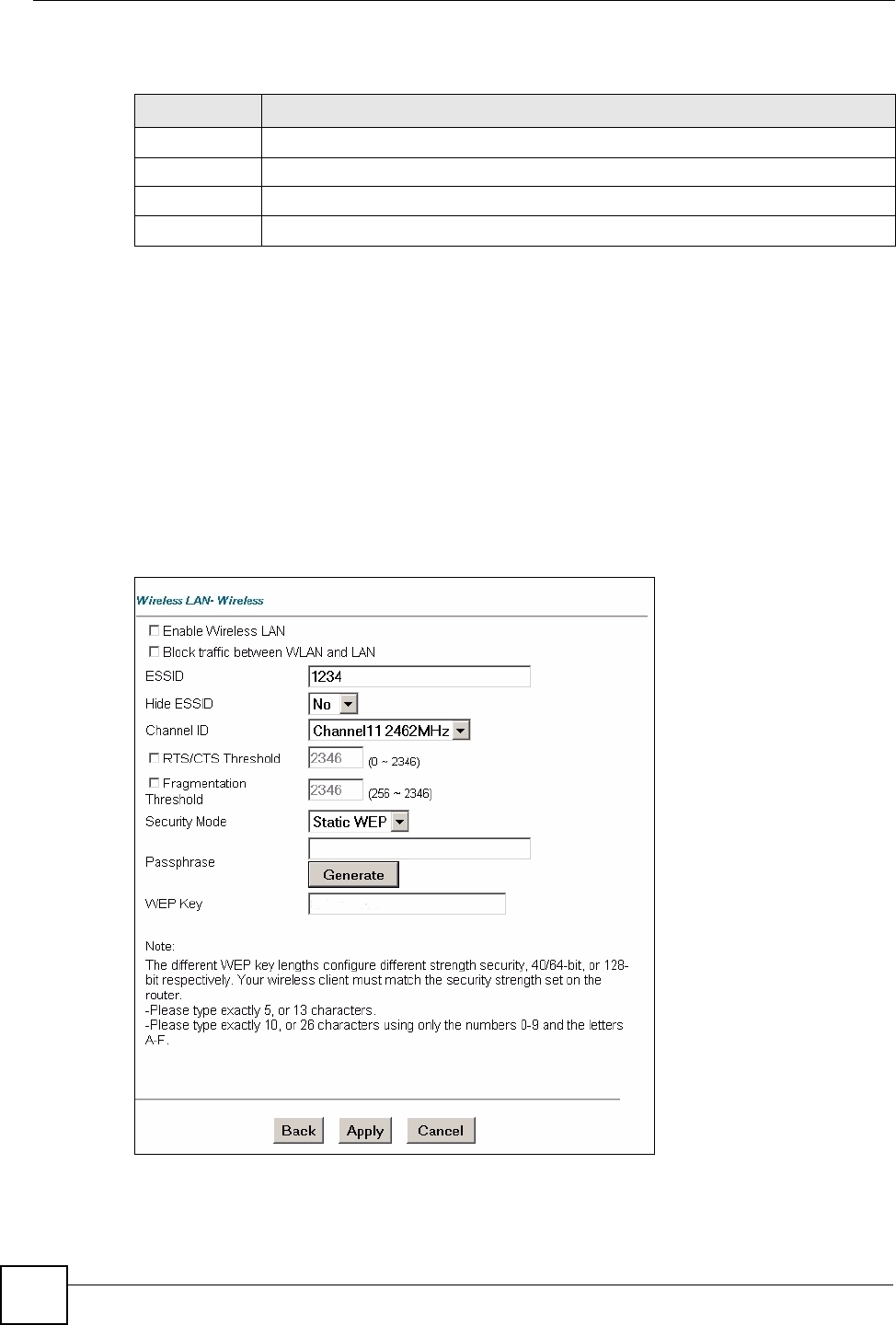
Chapter 6 Wireless LAN
P-660W-Tx v2 User’s Guide
72
The following table describes the labels in this screen.
6.5.2 WEP Encryption
WEP encryption scrambles the data transmitted between the wireless stations and the access
points to keep network communications private. It encrypts unicast and multicast
communications in a network. Both the wireless stations and the access points must use the
same WEP key.
Your ZyXEL Device allows you to configure up to four 64-bit, 128-bit or 256-bit WEP keys
but only one key can be enabled at any one time.
In order to configure and enable WEP encryption; click Wireless LAN and Wireless to the
display the Wireless screen.
Figure 25 Wireless Screen
Table 19 Wireless No Security
LABEL DESCRIPTION
Security Mode Choose No Security from the drop-down list box.
Back Click Back to return to the previous screen.
Apply Click Apply to save your changes.
Reset Click Reset to reload the previous configuration for this screen.

Chapter 6 Wireless LAN
P-660W-Tx v2 User’s Guide 73
The following table describes the labels in this screen.
6.5.3 WPA-PSK/WPA2-PSK
Click Advanced Setup > Wireless LAN to display the Wireless LAN screen. Select WPA-
PSK or WPA2-PSK from the Security Mode list.
Table 20 Wireless LAN
LABEL DESCRIPTION
Security Mode Select Static WEP from the drop-down list.
You won’t see the following WEP-related fields if you have WPA or WPA-PSK enabled.
Passphrase Enter a "passphrase" (password phrase) of up to 63 case-sensitive printable
characters and click Generate to have the ZyXEL Device create four different WEP
keys.
At the time of writing, you cannot use passphrase to generate 256-bit WEP keys.
Generate After you enter the passphrase, click Generate to have the ZyXEL Device generate
a WEP key automatically. The key displays in the WEP Key field.
WEP Key The WEP Key is used to encrypt data. Both the ZyXEL Device and other wireless
devices on your network must use the same WEP key.
If you want to manually set the WEP keys, type the key in this field. The length of
the key corresponds to the security strength.
For 64-bit security, type 5 ASCII characters or 10 hexadecimal characters ("0-9",
"A-F").
For 128-bit security, type13 ASCII characters or 26 hexadecimal characters ("0-9",
"A-F").
Back Click Back to go to the main wireless LAN setup screen.
Apply Click Apply to save your changes back to the ZyXEL Device.
Cancel Click Cancel to begin configuring this screen afresh.
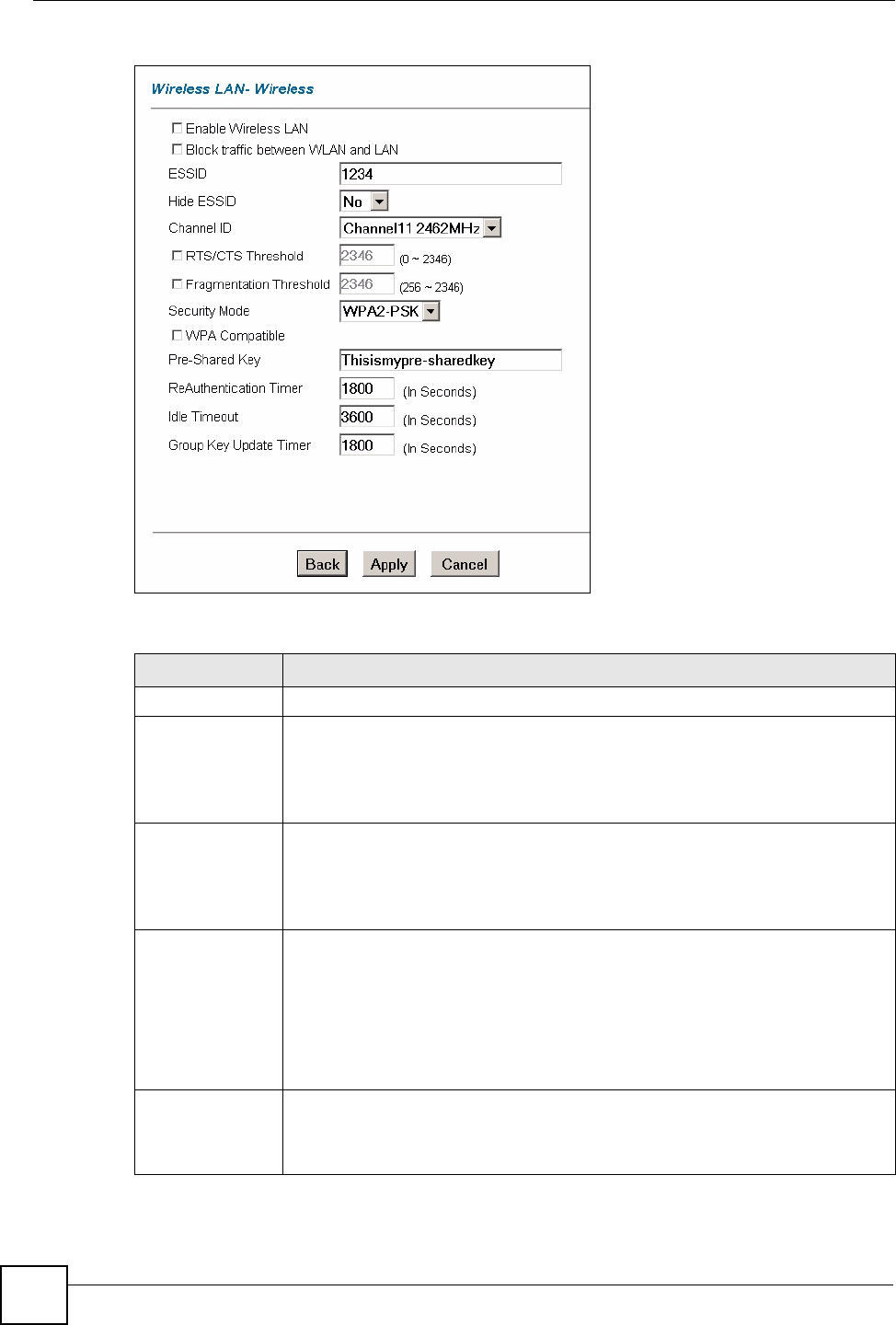
Chapter 6 Wireless LAN
P-660W-Tx v2 User’s Guide
74
Figure 26 Network > Wireless LAN: WPA-PSK/
The following table describes the labels in this screen.
Table 21 Network > Wireless LAN > General: WPA-PSK/WPA2-PSK
LABEL DESCRIPTION
Security Mode Select WPA-PSK or WPA2-PSK from the drop-down box.
WPA Compatible This check box is available only when you select WPA2-PSK or WPA2 in the
Security Mode field.
Select the check box to have both WPA2 and WPA wireless clients be able to
communicate with the ZyXEL Device even when the ZyXEL Device is using
WPA2-PSK or WPA2.
Pre-Shared Key The encryption mechanisms used for WPA/WPA2 and WPA-PSK/WPA2-PSK
are the same. The only difference between the two is that WPA-PSK/WPA2-PSK
uses a simple common password, instead of user-specific credentials.
Type a pre-shared key from 8 to 63 case-sensitive ASCII characters (including
spaces and symbols).
ReAuthentication
Timer (in
seconds)
Specify how often wireless stations have to resend usernames and passwords in
order to stay connected. Enter a time interval between 10 and 9999 seconds. The
default time interval is 1800 seconds (30 minutes).
Note: If wireless station authentication is done using a RADIUS
server, the reauthentication timer on the RADIUS server has
priority.
Idle Timeout The ZyXEL Device automatically disconnects a wireless station from the wired
network after a period of inactivity. The wireless station needs to enter the
username and password again before access to the wired network is allowed. The
default time interval is 3600 seconds (or 1 hour).
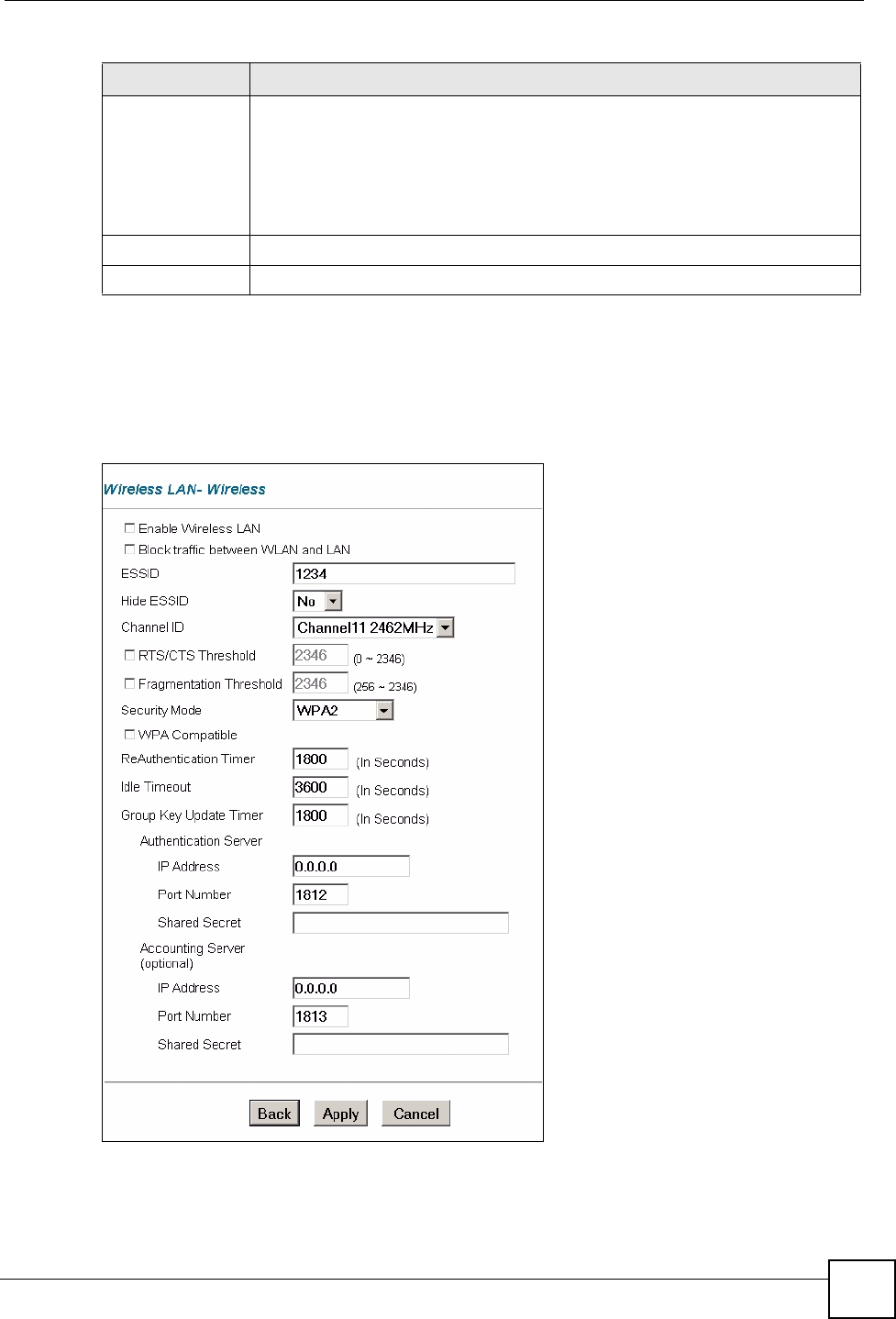
Chapter 6 Wireless LAN
P-660W-Tx v2 User’s Guide 75
6.5.4 WPA/WPA2
Click Advanced Setup > Wireless LAN to display the Wireless LAN screen. Select WPA or
WPA2 from the Security Mode list.
Figure 27 Network > Wireless LAN > General: WPA/WPA2
Group Key
Update Timer
The Group Key Update Timer is the rate at which the AP (if using WPA-PSK/
WPA2-PSK key management) or RADIUS server (if using WPA/WPA2 key
management) sends a new group key out to all clients. The re-keying process is
the WPA/WPA2 equivalent of automatically changing the WEP key for an AP and
all stations in a WLAN on a periodic basis. Setting of the Group Key Update
Timer is also supported in WPA-PSK/WPA2-PSK mode. The default is 1800
seconds (30 minutes).
Apply Click Apply to save your changes back to the ZyXEL Device.
Reset Click Reset to reload the previous configuration for this screen.
Table 21 Network > Wireless LAN > General: WPA-PSK/WPA2-PSK
LABEL DESCRIPTION

Chapter 6 Wireless LAN
P-660W-Tx v2 User’s Guide
76
The following table describes the labels in this screen.
Table 22 Network > Wireless LAN > General: WPA/WPA2
LABEL DESCRIPTION
WPA Compatible This check box is available only when you select WPA2-PSK or WPA2 in the
Security Mode field.
Select the check box to have both WPA2 and WPA wireless clients be able to
communicate with the ZyXEL Device even when the ZyXEL Device is using
WPA2-PSK or WPA2.
ReAuthentication
Timer
Specify how often wireless stations have to resend usernames and passwords in
order to stay connected. Enter a time interval between 10 and 9999 seconds.
The default time interval is 1800 seconds (30 minutes).
Note: If wireless station authentication is done using a RADIUS
server, the reauthentication timer on the RADIUS server
has priority.
Idle Timeout The ZyXEL Device automatically disconnects a wireless station from the wired
network after a period of inactivity. The wireless station needs to enter the
username and password again before access to the wired network is allowed.
The default time interval is 3600 seconds (or 1 hour).
Group Key Update
Timer
The Group Key Update Timer is the rate at which the AP (if using WPA-PSK/
WPA2-PSK key management) or RADIUS server (if using WPA/WPA2 key
management) sends a new group key out to all clients. The re-keying process is
the WPA/WPA2 equivalent of automatically changing the WEP key for an AP
and all stations in a WLAN on a periodic basis. Setting of the Group Key Update
Timer is also supported in WPA-PSK/WPA2-PSK mode. The ZyXEL Device
default is 1800 seconds (30 minutes).
Authentication Server
IP Address Enter the IP address of the external authentication server in dotted decimal
notation.
Port Number Enter the port number of the external authentication server. The default port
number is 1812.
You need not change this value unless your network administrator instructs you
to do so with additional information.
Shared Secret Enter a password (up to 31 alphanumeric characters) as the key to be shared
between the external authentication server and the ZyXEL Device.
The key must be the same on the external authentication server and your ZyXEL
Device. The key is not sent over the network.
Accounting Server
Active Select Yes from the drop down list box to enable user accounting through an
external authentication server.
IP Address Enter the IP address of the external accounting server in dotted decimal notation.
Port Number Enter the port number of the external accounting server. The default port number
is 1813.
You need not change this value unless your network administrator instructs you
to do so with additional information.
Shared Secret Enter a password (up to 31 alphanumeric characters) as the key to be shared
between the external accounting server and the ZyXEL Device.
The key must be the same on the external accounting server and your ZyXEL
Device. The key is not sent over the network.
Apply Click Apply to save your changes back to the ZyXEL Device.
Reset Click Reset to reload the previous configuration for this screen.

Chapter 6 Wireless LAN
P-660W-Tx v2 User’s Guide 77
"If you are configuring the ZyXEL Device from a computer connected to the
wireless LAN and you change the ZyXEL Device’s ESSID or security settings
(see Figure 22 on page 69), you will lose your wireless connection when you
press Apply to confirm. You must then change the wireless settings of your
computer to match the ZyXEL Device’s new settings.
6.6 Configuring MAC Filters
Every Ethernet device has a unique MAC (Media Access Control) address. The MAC address
is assigned at the factory and consists of six pairs of hexadecimal characters, for example,
00:A0:C5:00:00:02. You need to know the MAC addresses of the devices to configure this
screen. To change your ZyXEL Device’s MAC filter settings, click Advanced Setup >
Wireless LAN > MAC Filter to open the MAC Filter screen. The screen appears as shown.
"Be careful not to list your computer’s MAC address and set the Action field to
Deny Association when managing the ZyXEL Device via a wireless
connection. This would lock you out.
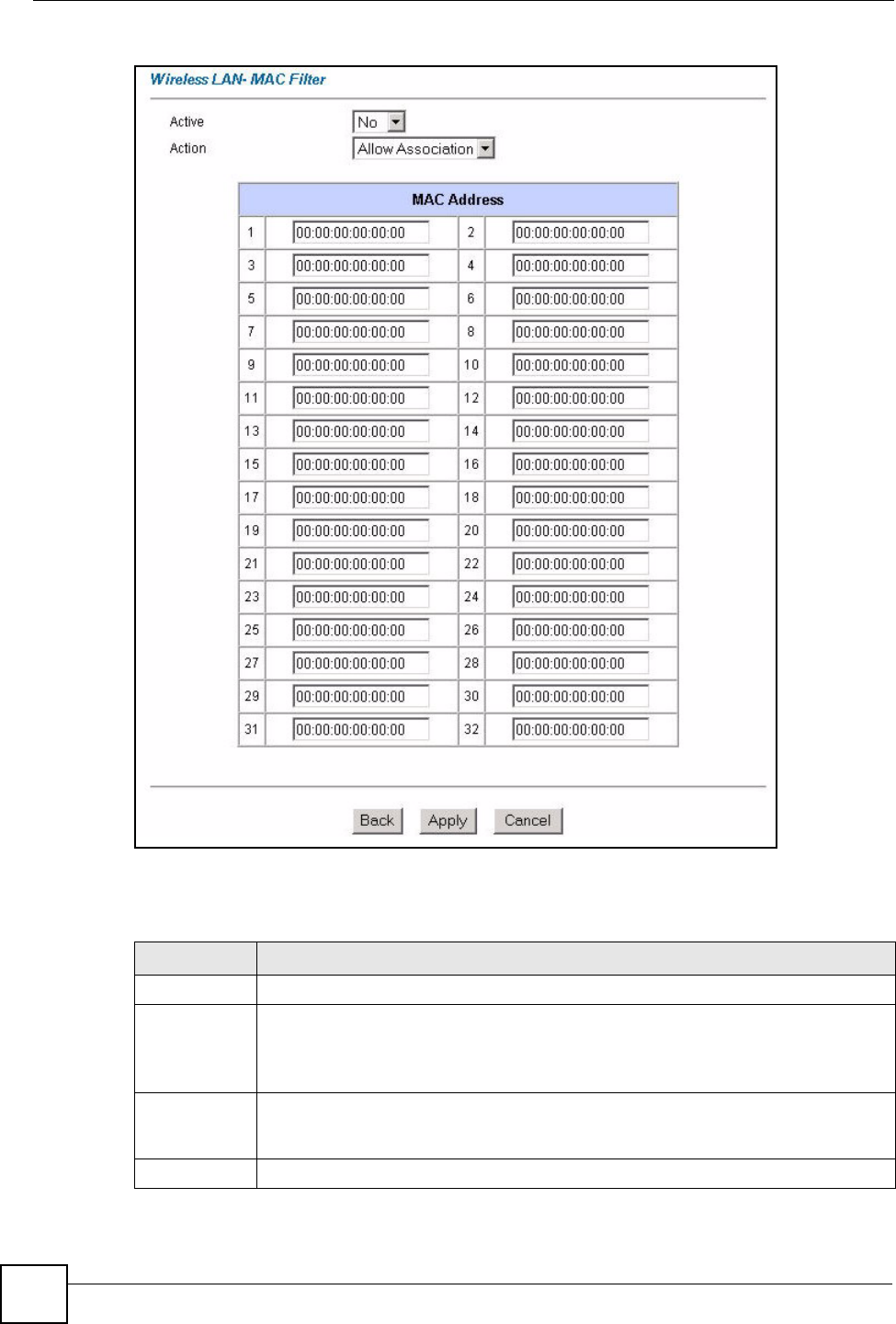
Chapter 6 Wireless LAN
P-660W-Tx v2 User’s Guide
78
Figure 28 MAC Filter
The following table describes the fields in this menu.
Table 23 MAC Filter
LABEL DESCRIPTION
Active Select Yes from the drop down list box to enable MAC address filtering.
Action Define the filter action for the list of MAC addresses in the MAC Address table.
Select Deny Association to block access to the router, MAC addresses not listed will
be allowed to access the ZyXEL Device. Select Allow Association to permit access
to the router, MAC addresses not listed will be denied access to the ZyXEL Device.
MAC Address Enter the MAC addresses in a valid MAC address format, that is, six hexadecimal
character pairs, for example, 12:34:56:78:9a:bc of the wireless stations that are
allowed or denied access to the ZyXEL Device in these address fields.
Back Click Back to go to the main wireless LAN setup screen.
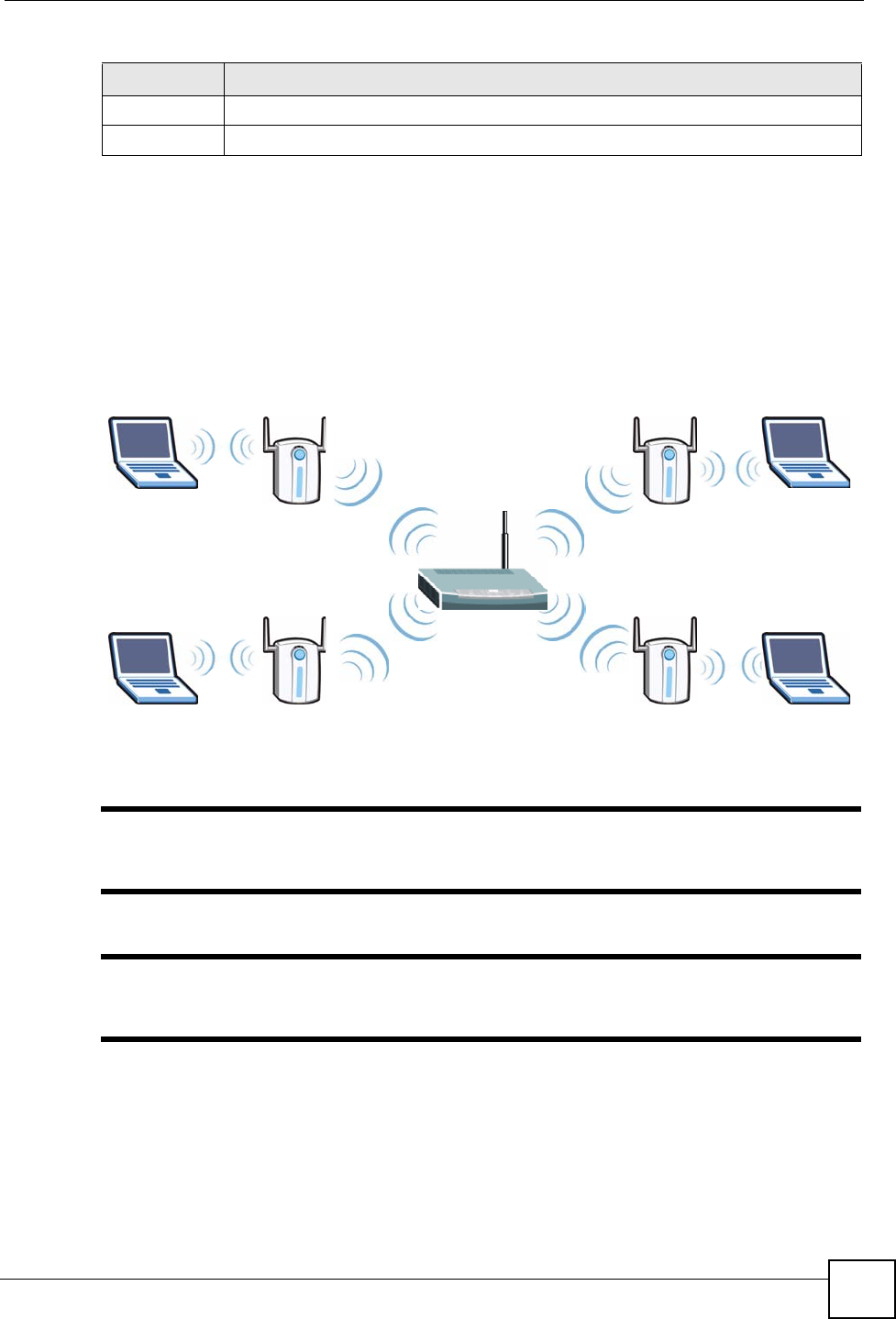
Chapter 6 Wireless LAN
P-660W-Tx v2 User’s Guide 79
6.7 WDS Screen
The WDS (Wireless Distribution System) allows you to configure the ZyXEL Device to
connect to two or more APs via wireless when WDS is enabled. An AP using WDS can
function as a wireless network bridge allowing you to wirelessly connect two wired network
segments.
Figure 29 Connecting Wireless Networks Using WDS
Use this screen to set up WDS between your ZyXEL Device and another AP.
"WDS security is independent of the security settings between the ZyXEL
Device and any wireless clients.
"At the time of writing, WDS is compatible with other ZyXEL APs only. Not all
models support WDS links. Check your other AP’s documentation.
Apply Click Apply to save your changes back to the ZyXEL Device.
Cancel Click Cancel to begin configuring this screen afresh.
Table 23 MAC Filter (continued)
LABEL DESCRIPTION
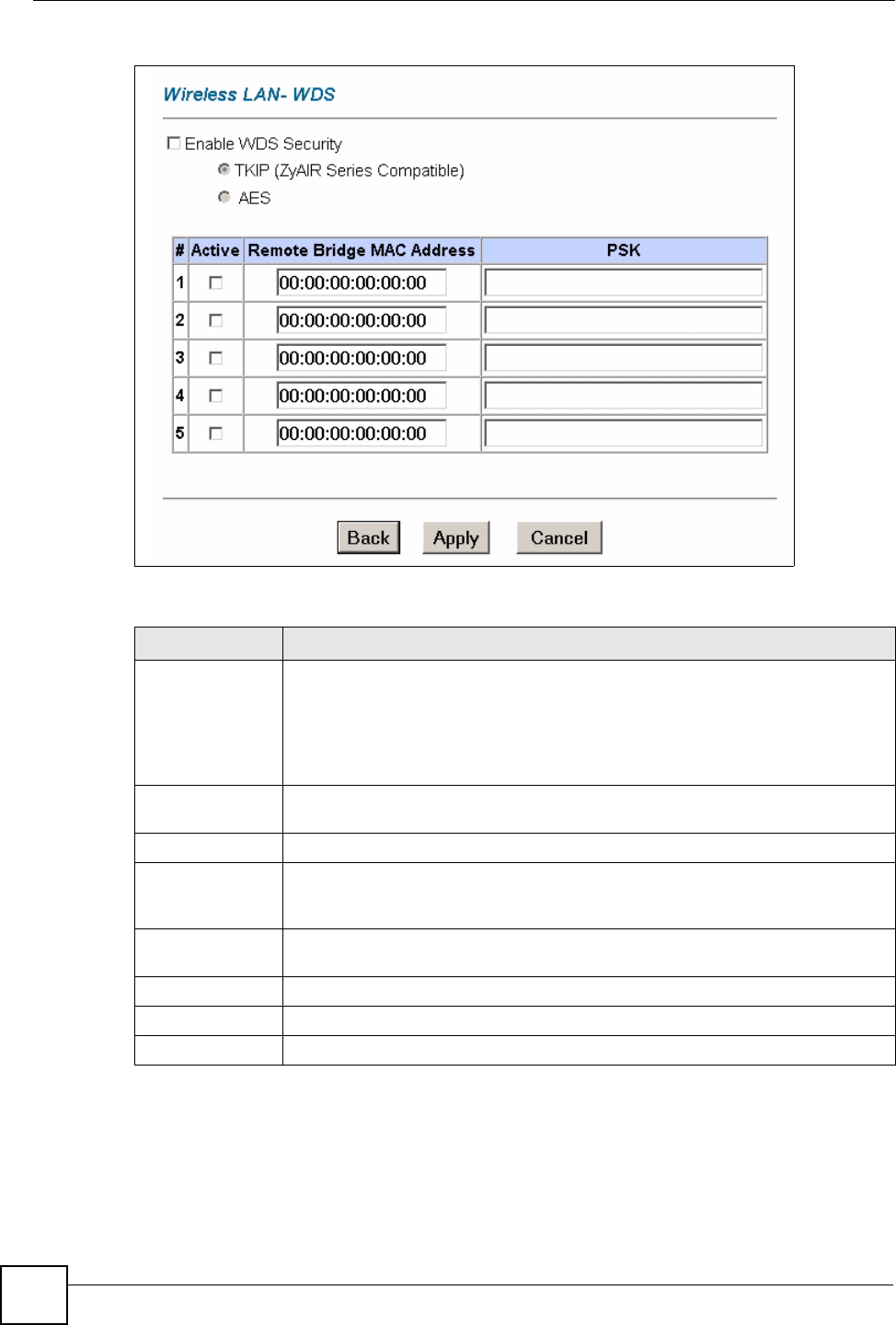
Chapter 6 Wireless LAN
P-660W-Tx v2 User’s Guide
80
Figure 30 Advanced Setup > Wireless LAN > WDS
The following table describes the labels in this screen.
Table 24 Advanced Setup > Wireless LAN > WDS
LABEL DESCRIPTION
Enable WDS
Security
Select this to set up security on your ZyXEL Device’s bridged connection with an
AP. Select AES (Advanced Encryption Standard) as your security method if the
AP’s on your network support it. Otherwise select TKIP Security (ZyAIR Series
Compatible) (Temporal Key Integrity Protocol).
If you de-select this option, the data sent between APs is not encrypted. Anyone
can read it.
#This is the index number of the access point (AP) with which you are setting up a
WDS connection.
Active Select this to enable a WDS connection with this AP.
Remote Bridge
MAC Address
Type the MAC address of the AP with which you are setting up a WDS connection
in a valid MAC address format (six hexadecimal character pairs, for example
12:34:56:78:9a:bc)..
PSK Type a PSK (Pre-Shared Key) in this field between 8~63 characters long (A~Z,
a~z,0~9).
Back Click Back to return to the Wireless LAN menu screen.
Apply Click Apply to save your changes back to the ZyXEL Device.
Cancel Click Cancel to cancel your changes.

P-660W-Tx v2 User’s Guide 81
CHAPTER 7
WAN Setup
This chapter describes how to configure WAN settings.
7.1 WAN Overview
A WAN (Wide Area Network) is an outside connection to another network or the Internet.
7.1.1 Encapsulation
Be sure to use the encapsulation method required by your ISP. The ZyXEL Device supports
the following methods.
7.1.1.1 ENET ENCAP
The MAC Encapsulated Routing Link Protocol (ENET ENCAP) is only implemented with the
IP network protocol. IP packets are routed between the Ethernet interface and the WAN
interface and then formatted so that they can be understood in a bridged environment. For
instance, it encapsulates routed Ethernet frames into bridged ATM cells. ENET ENCAP
requires that you specify a gateway IP address in the ENET ENCAP Gateway field in the
second wizard screen. You can get this information from your ISP.
7.1.1.2 PPP over Ethernet
PPPoE provides access control and billing functionality in a manner similar to dial-up services
using PPP. The ZyXEL Device bridges a PPP session over Ethernet (PPP over Ethernet, RFC
2516) from your computer to an ATM PVC (Permanent Virtual Circuit) which connects to
ADSL Access Concentrator where the PPP session terminates. One PVC can support any
number of PPP sessions from your LAN. For more information on PPPoE, see the appendices.
7.1.1.3 PPPoA
PPPoA stands for Point to Point Protocol over ATM Adaptation Layer 5 (AAL5). A PPPoA
connection functions like a dial-up Internet connection. The ZyXEL Device encapsulates the
PPP session based on RFC1483 and sends it through an ATM PVC (Permanent Virtual
Circuit) to the Internet Service Provider’s (ISP) DSLAM (digital access multiplexer). Please
refer to RFC 2364 for more information on PPPoA. Refer to RFC 1661 for more information
on PPP.

Chapter 7 WAN Setup
P-660W-Tx v2 User’s Guide
82
7.1.1.4 RFC 1483
RFC 1483 describes two methods for Multiprotocol Encapsulation over ATM Adaptation
Layer 5 (AAL5). The first method allows multiplexing of multiple protocols over a single
ATM virtual circuit (LLC-based multiplexing) and the second method assumes that each
protocol is carried over a separate ATM virtual circuit (VC-based multiplexing). Please refer
to the RFC for more detailed information.
7.1.2 Multiplexing
There are two conventions to identify what protocols the virtual circuit (VC) is carrying. Be
sure to use the multiplexing method required by your ISP.
7.1.2.1 VC-based Multiplexing
In this case, by prior mutual agreement, each protocol is assigned to a specific virtual circuit;
for example, VC1 carries IP, etc. VC-based multiplexing may be dominant in environments
where dynamic creation of large numbers of ATM VCs is fast and economical.
7.1.2.2 LLC-based Multiplexing
In this case one VC carries multiple protocols with protocol identifying information being
contained in each packet header. Despite the extra bandwidth and processing overhead, this
method may be advantageous if it is not practical to have a separate VC for each carried
protocol, for example, if charging heavily depends on the number of simultaneous VCs.
7.1.3 VPI and VCI
Be sure to use the correct Virtual Path Identifier (VPI) and Virtual Channel Identifier (VCI)
numbers assigned to you. The valid range for the VPI is 0 to 255 and for the VCI is 32 to
65535 (0 to 31 is reserved for local management of ATM traffic). Please see the appendix for
more information.
7.1.4 IP Address Assignment
A static IP is a fixed IP that your ISP gives you. A dynamic IP is not fixed; the ISP assigns you
a different one each time. The Single User Account feature can be enabled or disabled if you
have either a dynamic or static IP. However the encapsulation method assigned influences
your choices for IP address and ENET ENCAP gateway.
7.1.4.1 IP Assignment with PPPoA or PPPoE Encapsulation
If you have a dynamic IP, then the IP Address and ENET ENCAP Gateway fields are not
applicable (N/A). If you have a static IP, then you only need to fill in the IP Address field and
not the ENET ENCAP Gateway field.
7.1.4.2 IP Assignment with RFC 1483 Encapsulation
In this case the IP Address Assignment must be static with the same requirements for the IP
Address and ENET ENCAP Gateway fields as stated above.

Chapter 7 WAN Setup
P-660W-Tx v2 User’s Guide 83
7.1.4.3 IP Assignment with ENET ENCAP Encapsulation
In this case you can have either a static or dynamic IP. For a static IP you must fill in all the IP
Address and ENET ENCAP Gateway fields as supplied by your ISP. However for a
dynamic IP, the ZyXEL Device acts as a DHCP client on the WAN port and so the IP
Address and ENET ENCAP Gateway fields are not applicable (N/A) as the DHCP server
assigns them to the ZyXEL Device.
7.1.5 Nailed-Up Connection (PPP)
A nailed-up connection is a dial-up line where the connection is always up regardless of traffic
demand. The ZyXEL Device does two things when you specify a nailed-up connection. The
first is that idle timeout is disabled. The second is that the ZyXEL Device will try to bring up
the connection when turned on and whenever the connection is down. A nailed-up connection
can be very expensive for obvious reasons.
Do not specify a nailed-up connection unless your telephone company offers flat-rate service
or you need a constant connection and the cost is of no concern.
7.1.6 NAT
NAT (Network Address Translation - NAT, RFC 1631) is the translation of the IP address of a
host in a packet, for example, the source address of an outgoing packet, used within one
network to a different IP address known within another network.
7.2 Metric
The metric represents the "cost of transmission". A router determines the best route for
transmission by choosing a path with the lowest "cost". RIP routing uses hop count as the
measurement of cost, with a minimum of "1" for directly connected networks. The number
must be between "1" and "15"; a number greater than "15" means the link is down. The
smaller the number, the lower the "cost".
The metric sets the priority for the ZyXEL Device routes to the Internet. If any two of the
default routes have the same metric, the ZyXEL Device uses the following pre-defined
priorities:
• Normal route: designated by the ISP (see Section 7.7 on page 86)
• Traffic-redirect route (see Section 7.8 on page 90)
• WAN-backup route, also called dial-backup (see Section 7.9 on page 90)
For example, if the normal route has a metric of "1" and the traffic-redirect route has a metric
of "2" and dial-backup route has a metric of "3", then the normal route acts as the primary
default route. If the normal route fails to connect to the Internet, the ZyXEL Device tries the
traffic-redirect route next. In the same manner, the ZyXEL Device uses the dial-backup route
if the traffic-redirect route also fails.
If you want the dial-backup route to take first priority over the traffic-redirect route or even the
normal route, all you need to do is set the dial-backup route’s metric to "1" and the others to
"2" (or greater).

Chapter 7 WAN Setup
P-660W-Tx v2 User’s Guide
84
IP Policy Routing overrides the default routing behavior and takes priority over all of the
routes mentioned above.
7.3 PPPoE Encapsulation
The ZyXEL Device supports PPPoE (Point-to-Point Protocol over Ethernet). PPPoE is an
IETF Draft standard (RFC 2516) specifying how a personal computer (PC) interacts with a
broadband modem (DSL, cable, wireless, etc.) connection. The PPPoE option is for a dial-up
connection using PPPoE.
For the service provider, PPPoE offers an access and authentication method that works with
existing access control systems (for example Radius). PPPoE provides a login and
authentication method that the existing Microsoft Dial-Up Networking software can activate,
and therefore requires no new learning or procedures for Windows users.
One of the benefits of PPPoE is the ability to let you access one of multiple network services,
a function known as dynamic service selection. This enables the service provider to easily
create and offer new IP services for individuals.
Operationally, PPPoE saves significant effort for both you and the ISP or carrier, as it requires
no specific configuration of the broadband modem at the customer site.
By implementing PPPoE directly on the ZyXEL Device (rather than individual computers),
the computers on the LAN do not need PPPoE software installed, since the ZyXEL Device
does that part of the task. Furthermore, with NAT, all of the LANs’ computers will have
access.
7.4 Traffic Shaping
Traffic Shaping is an agreement between the carrier and the subscriber to regulate the average
rate and fluctuations of data transmission over an ATM network. This agreement helps
eliminate congestion, which is important for transmission of real time data such as audio and
video connections.
Peak Cell Rate (PCR) is the maximum rate at which the sender can send cells. This parameter
may be lower (but not higher) than the maximum line speed. 1 ATM cell is 53 bytes (424 bits),
so a maximum speed of 832Kbps gives a maximum PCR of 1962 cells/sec. This rate is not
guaranteed because it is dependent on the line speed.
Sustained Cell Rate (SCR) is the mean cell rate of each bursty traffic source. It specifies the
maximum average rate at which cells can be sent over the virtual connection. SCR may not be
greater than the PCR.
Maximum Burst Size (MBS) is the maximum number of cells that can be sent at the PCR.
After MBS is reached, cell rates fall below SCR until cell rate averages to the SCR again. At
this time, more cells (up to the MBS) can be sent at the PCR again.
If the PCR, SCR or MBS is set to the default of "0", the system will assign a maximum value
that correlates to your upstream line rate.
The following figure illustrates the relationship between PCR, SCR and MBS.
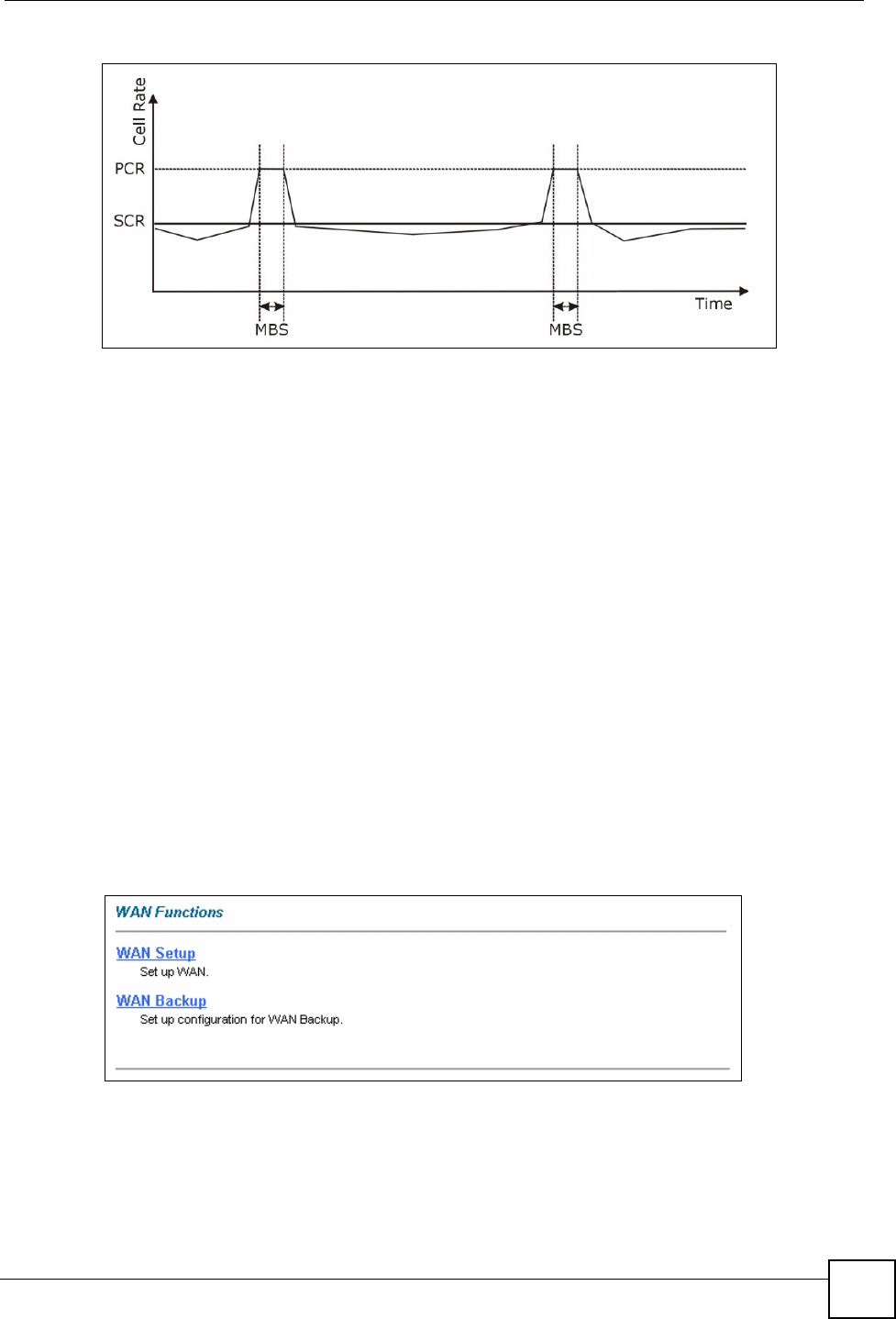
Chapter 7 WAN Setup
P-660W-Tx v2 User’s Guide 85
Figure 31 Example of Traffic Shaping
7.5 Zero Configuration Internet Access
Once you turn on and connect the ZyXEL Device to a telephone jack, it automatically detects
the Internet connection settings (such as the VCI/VPI numbers and the encapsulation method)
from the ISP and makes the necessary configuration changes. In cases where additional
account information (such as an Internet account user name and password) is required or the
ZyXEL Device cannot connect to the ISP, you will be redirected to web screen(s) for
information input or troubleshooting.
Zero configuration for Internet access is disabled when
• the ZyXEL Device is in bridge mode
• you set the ZyXEL Device to use a static (fixed) WAN IP address.
7.6 The Main WAN Screen
Click WA N in the navigation panel to display the man WA N screen.
See Section 7.1 on page 81 for more information.
Figure 32 WAN

Chapter 7 WAN Setup
P-660W-Tx v2 User’s Guide
86
The following table describes the links in this screen.
7.7 Configuring WAN Setup
To change your ZyXEL Device’s WAN remote node settings, click WA N and WA N S et up .
The screen differs by the encapsulation.
See Section 7.1 on page 81 for more information.
Table 25 WAN
LINK DESCRIPTION
WAN Setup Click this link to go to the screen where you can configure your ZyXEL Device for an
Internet connection.
WAN Backup Click this link to go to the screen where you can configure WAN backup connections
(traffic redirect and dial backup).
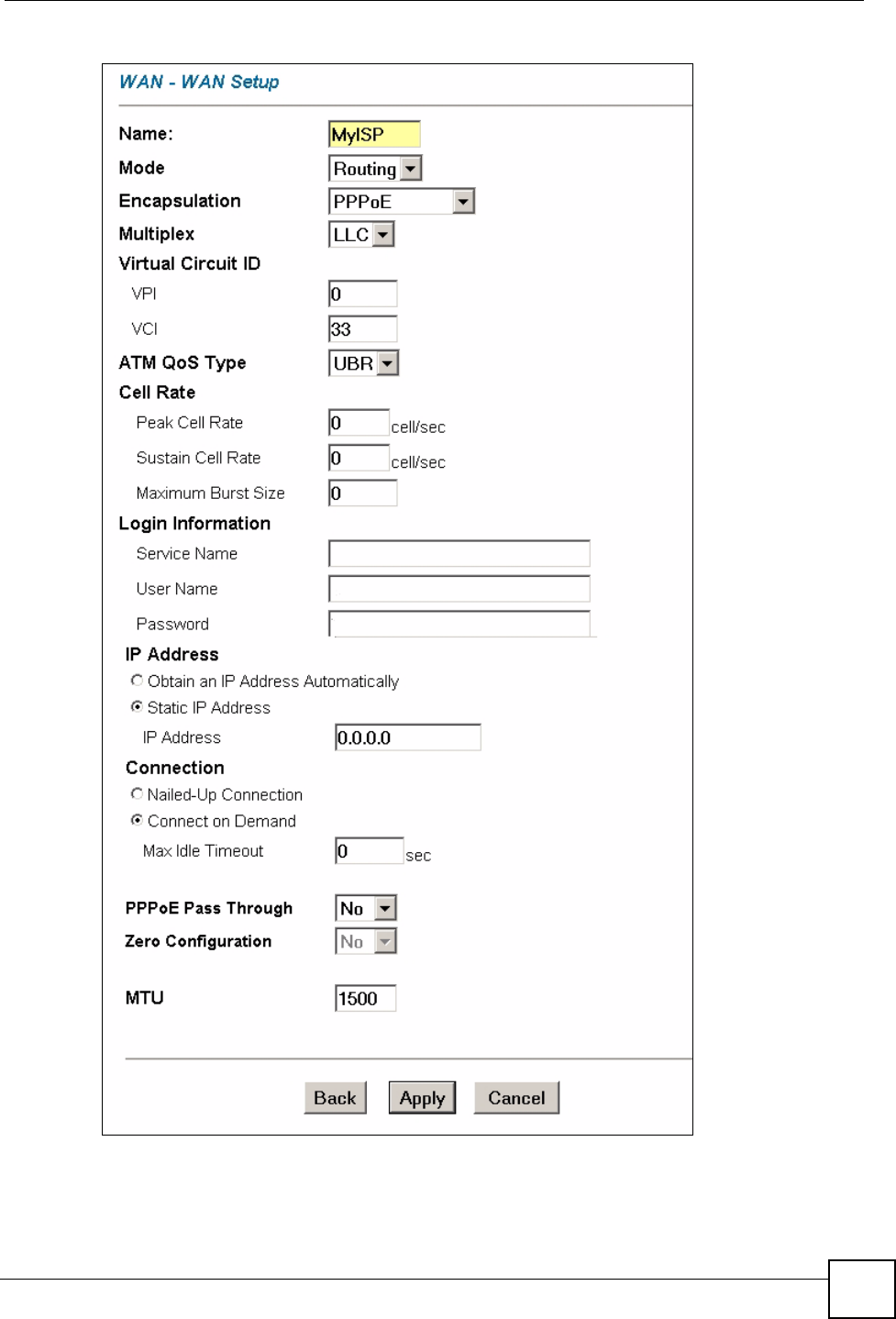
Chapter 7 WAN Setup
P-660W-Tx v2 User’s Guide 87
Figure 33 WAN Setup (PPPoE)

Chapter 7 WAN Setup
P-660W-Tx v2 User’s Guide
88
The following table describes the fields in this screen.
Table 26 WAN Setup
LABEL DESCRIPTION
Name Enter the name of your Internet Service Provider, e.g., MyISP. This information
is for identification purposes only.
Mode Select Routing (default) from the drop-down list box if your ISP allows multiple
computers to share an Internet account. Otherwise select Bridge.
Encapsulation Select the method of encapsulation used by your ISP from the drop-down list
box. Choices vary depending on the mode you select in the Mode field.
If you select Bridge in the Mode field, select either PPPoA or RFC 1483.
If you select Routing in the Mode field, select PPPoA, RFC 1483, ENET
ENCAP or PPPoE.
Multiplex Select the method of multiplexing used by your ISP from the drop-down list.
Choices are VC or LLC.
Virtual Circuit ID VPI (Virtual Path Identifier) and VCI (Virtual Channel Identifier) define a virtual
circuit. Refer to the appendix for more information.
VPI The valid range for the VPI is 0 to 255. Enter the VPI assigned to you.
VCI The valid range for the VCI is 32 to 65535 (0 to 31 is reserved for local
management of ATM traffic). Enter the VCI assigned to you.
ATM QoS Type Select CBR (Continuous Bit Rate) to specify fixed (always-on) bandwidth for
voice or data traffic. Select UBR (Unspecified Bit Rate) for applications that are
non-time sensitive, such as e-mail. Select VBR (Variable Bit Rate) for bursty
traffic and bandwidth sharing with other applications.
Cell Rate Cell rate configuration often helps eliminate traffic congestion that slows
transmission of real time data such as audio and video connections.
Peak Cell Rate Divide the DSL line rate (bps) by 424 (the size of an ATM cell) to find the Peak
Cell Rate (PCR). This is the maximum rate at which the sender can send cells.
Type the PCR here.
Sustain Cell Rate The Sustain Cell Rate (SCR) sets the average cell rate (long-term) that can be
transmitted. Type the SCR, which must be less than the PCR. Note that system
default is 0 cells/sec.
Maximum Burst
Size
Maximum Burst Size (MBS) refers to the maximum number of cells that can be
sent at the peak rate. Type the MBS, which is less than 65535.
Login Information (PPPoA and PPPoE encapsulation only)
Service Name (PPPoE only) Type the name of your PPPoE service here.
User Name Enter the user name exactly as your ISP assigned. If assigned a name in the
form user@domain where domain identifies a service name, then enter both
components exactly as given.
Password Enter the password associated with the user name above.
IP Address This option is available if you select Routing in the Mode field.
A static IP address is a fixed IP that your ISP gives you. A dynamic IP address is
not fixed; the ISP assigns you a different one each time you connect to the
Internet.
Select Obtain an IP Address Automatically if you have a dynamic IP address;
otherwise select Static IP Address and type your ISP assigned IP address in
the IP Address field below.

Chapter 7 WAN Setup
P-660W-Tx v2 User’s Guide 89
Connection
(PPPoA and PPPoE
encapsulation only)
Nailed-Up
Connection
Select Nailed-Up Connection when you want your connection up all the time.
The ZyXEL Device will try to bring up the connection automatically if it is
disconnected.
Connect on
Demand
Select Connect on Demand when you don't want the connection up all the time
and specify an idle time-out in the Max Idle Timeout field.
Max Idle Timeout Specify an idle time-out in the Max Idle Timeout field when you select Connect
on Demand. The default setting is 0, which means the Internet session will not
timeout.
PPPoE
Passthrough
(PPPoE
encapsulation only)
This field is available when you select PPPoE encapsulation.
In addition to the ZyXEL Device's built-in PPPoE client, you can enable PPPoE
pass through to allow up to ten hosts on the LAN to use PPPoE client software
on their computers to connect to the ISP via the ZyXEL Device. Each host can
have a separate account and a public WAN IP address.
PPPoE pass through is an alternative to NAT for application where NAT is not
appropriate.
Disable PPPoE pass through if you do not need to allow hosts on the LAN to use
PPPoE client software on their computers to connect to the ISP.
Subnet Mask
(ENET ENCAP
encapsulation only)
Enter a subnet mask in dotted decimal notation.
Refer to the appendices to calculate a subnet mask If you are implementing
subnetting.
ENET ENCAP
Gateway
(ENET ENCAP
encapsulation only)
You must specify a gateway IP address (supplied by your ISP) when you select
ENET ENCAP in the Encapsulation field.
Zero Configuration This feature is not applicable/available when you configure the ZyXEL Device to
use a static WAN IP address or in bridge mode.
Select Yes to set the ZyXEL Device to automatically detect the Internet
connection settings (such as the VCI/VPI numbers and the encapsulation
method) from the ISP and make the necessary configuration changes.
Select No to disable this feature. You must manually configure the ZyXEL
Device for Internet access.
MTU The MTU (Maximum Transmission Unit, measured in bytes) sets the largest
frame size your ZyXEL Device can send. Setting a high MTU allows larger
frames to be sent from your device resulting in the more efficient use of
bandwidth. However, the size of frames on your network may be limited by the
Ethernet maximum frame size limit of 1500 bytes. Furthermore, if other devices
have a smaller MTU setting, they must fragment packets received from the
ZyXEL Device, resulting in slower overall transmission speeds. Type the MTU in
this field if your ISP gave you it. Otherwise leave it at its default setting.
Back Click Back to return to the previous screen.
Apply Click Apply to save the changes.
Cancel Click Cancel to begin configuring this screen afresh.
Table 26 WAN Setup (continued)
LABEL DESCRIPTION
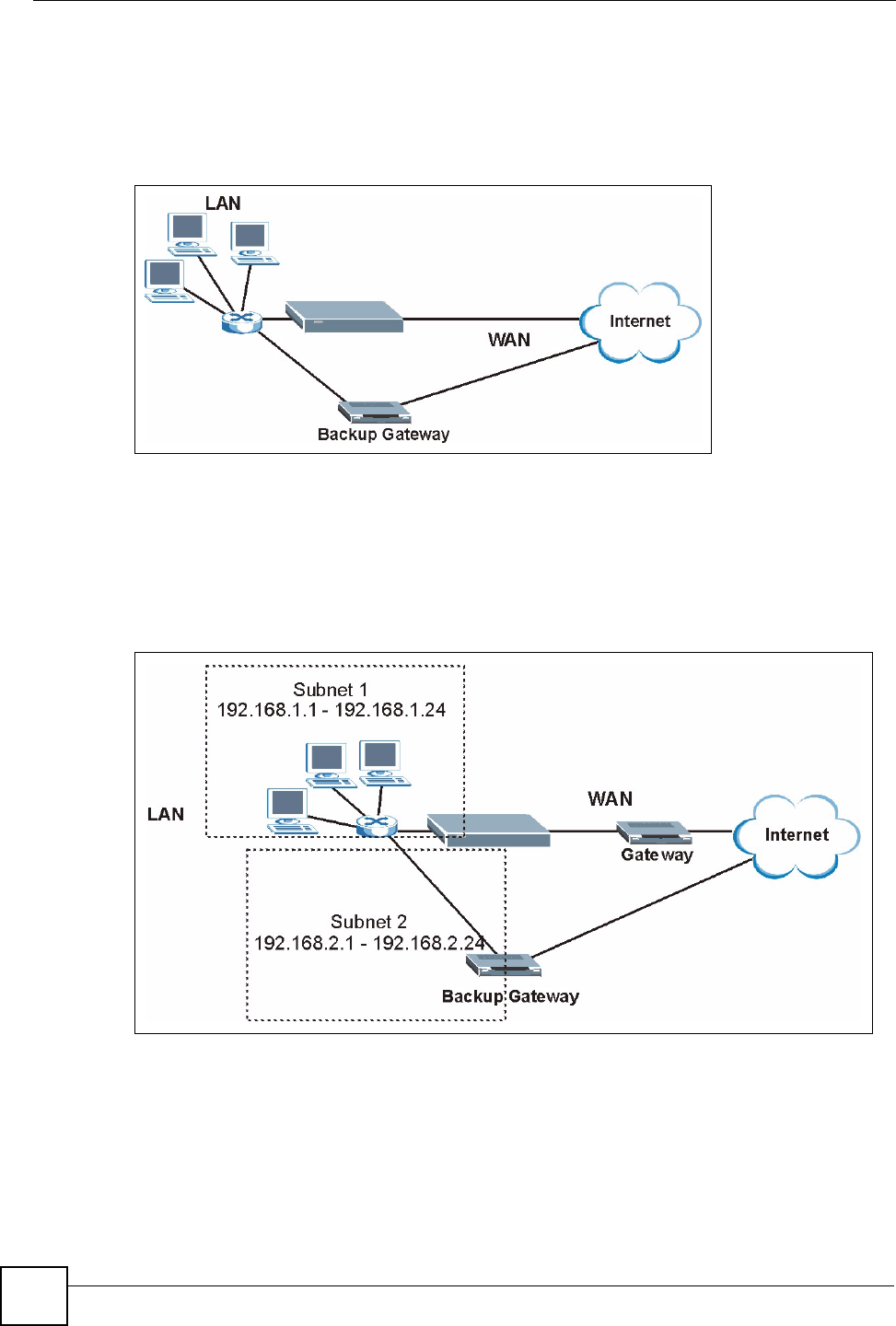
Chapter 7 WAN Setup
P-660W-Tx v2 User’s Guide
90
7.8 Traffic Redirect
Traffic redirect forwards traffic to a backup gateway when the ZyXEL Device cannot connect
to the Internet. An example is shown in the figure below.
Figure 34 Traffic Redirect Example
The following network topology allows you to avoid triangle route security issues when the
backup gateway is connected to the LAN. Use IP alias to configure the LAN into two or three
logical networks with the ZyXEL Device itself as the gateway for each LAN network. Put the
protected LAN in one subnet (Subnet 1 in the following figure) and the backup gateway in
another subnet (Subnet 2). Configure filters that allow packets from the protected LAN
(Subnet 1) to the backup gateway (Subnet 2).
Figure 35 Traffic Redirect LAN Setup
7.9 Configuring WAN Backup
Click WA N , then WAN Backup. The screen appears as shown. Use this screen to change
your ZyXEL Device’s WAN backup settings.
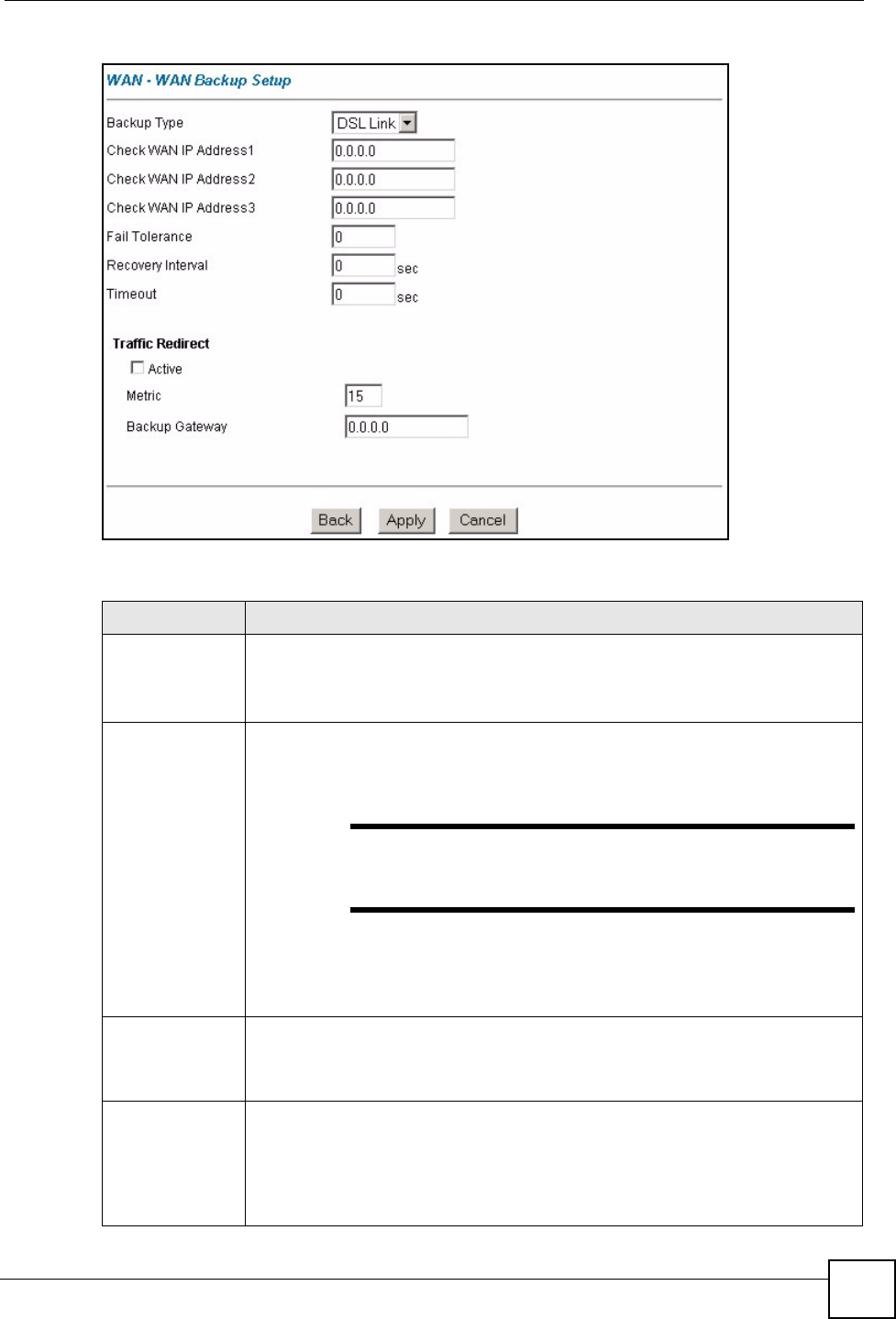
Chapter 7 WAN Setup
P-660W-Tx v2 User’s Guide 91
Figure 36 WAN Backup
The following table describes the fields in this screen.
Table 27 WAN Backup
LABEL DESCRIPTION
Backup Type Select the method that the ZyXEL Device uses to check the DSL connection.
Select DSL Link to have the ZyXEL Device check if the connection to the DSLAM
is up. Select ICMP to have the ZyXEL Device periodically ping the IP addresses
configured in the Check WAN IP Address fields.
Check WAN IP
Address1-3
Configure this field to test your ZyXEL Device's WAN accessibility. Type the IP
address of a reliable nearby computer (for example, your ISP's DNS server
address).
"If you activate either traffic redirect or dial backup,
you must configure at least one IP address here.
When using a WAN backup connection, the ZyXEL Device periodically pings the
addresses configured here and uses the other WAN backup connection (if
configured) if there is no response.
Fail Tolerance Type the number of times (2 recommended) that your ZyXEL Device may ping the
IP addresses configured in the Check WAN IP Address field without getting a
response before switching to a WAN backup connection (or a different WAN
backup connection).
Recovery Interval When the ZyXEL Device is using a lower priority connection (usually a WAN
backup connection), it periodically checks to whether or not it can use a higher
priority connection.
Type the number of seconds (30 recommended) for the ZyXEL Device to wait
between checks. Allow more time if your destination IP address handles lots of
traffic.

Chapter 7 WAN Setup
P-660W-Tx v2 User’s Guide
92
Timeout Type the number of seconds (3 recommended) for your ZyXEL Device to wait for a
ping response from one of the IP addresses in the Check WAN IP Address field
before timing out the request. The WAN connection is considered "down" after the
ZyXEL Device times out the number of times specified in the Fail Tolerance field.
Use a higher value in this field if your network is busy or congested.
Traffic Redirect Traffic redirect forwards traffic to a backup gateway when the ZyXEL Device
cannot connect to the Internet.
Active Select this check box to have the ZyXEL Device use traffic redirect if the normal
WAN connection goes down.
"If you activate traffic redirect, you must configure at
least one Check WAN IP Address.
Metric This field sets this route's priority among the routes the ZyXEL Device uses.
The metric represents the "cost of transmission". A router determines the best
route for transmission by choosing a path with the lowest "cost". RIP routing uses
hop count as the measurement of cost, with a minimum of "1" for directly
connected networks. The number must be between "1" and "15"; a number greater
than "15" means the link is down. The smaller the number, the lower the "cost".
Backup Gateway Type the IP address of your backup gateway in dotted decimal notation. The
ZyXEL Device automatically forwards traffic to this IP address if the ZyXEL
Device's Internet connection terminates.
Back Click Back to return to the previous screen.
Apply Click Apply to save the changes.
Cancel Click Cancel to begin configuring this screen afresh.
Table 27 WAN Backup (continued)
LABEL DESCRIPTION

P-660W-Tx v2 User’s Guide 93
CHAPTER 8
Network Address Translation
(NAT) Screens
This chapter discusses how to configure NAT on the ZyXEL Device.
8.1 NAT Overview
NAT (Network Address Translation - NAT, RFC 1631) is the translation of the IP address of a
host in a packet, for example, the source address of an outgoing packet, used within one
network to a different IP address known within another network.
8.1.1 NAT Definitions
Inside/outside denotes where a host is located relative to the ZyXEL Device, for example, the
computers of your subscribers are the inside hosts, while the web servers on the Internet are
the outside hosts.
Global/local denotes the IP address of a host in a packet as the packet traverses a router, for
example, the local address refers to the IP address of a host when the packet is in the local
network, while the global address refers to the IP address of the host when the same packet is
traveling in the WAN side.
Note that inside/outside refers to the location of a host, while global/local refers to the IP
address of a host used in a packet. Thus, an inside local address (ILA) is the IP address of an
inside host in a packet when the packet is still in the local network, while an inside global
address (IGA) is the IP address of the same inside host when the packet is on the WAN side.
The following table summarizes this information.
NAT never changes the IP address (either local or global) of an outside host.
Table 28 NAT Definitions
ITEM DESCRIPTION
Inside This refers to the host on the LAN.
Outside This refers to the host on the WAN.
Local This refers to the packet address (source or destination) as the packet travels on the
LAN.
Global This refers to the packet address (source or destination) as the packet travels on the
WAN.
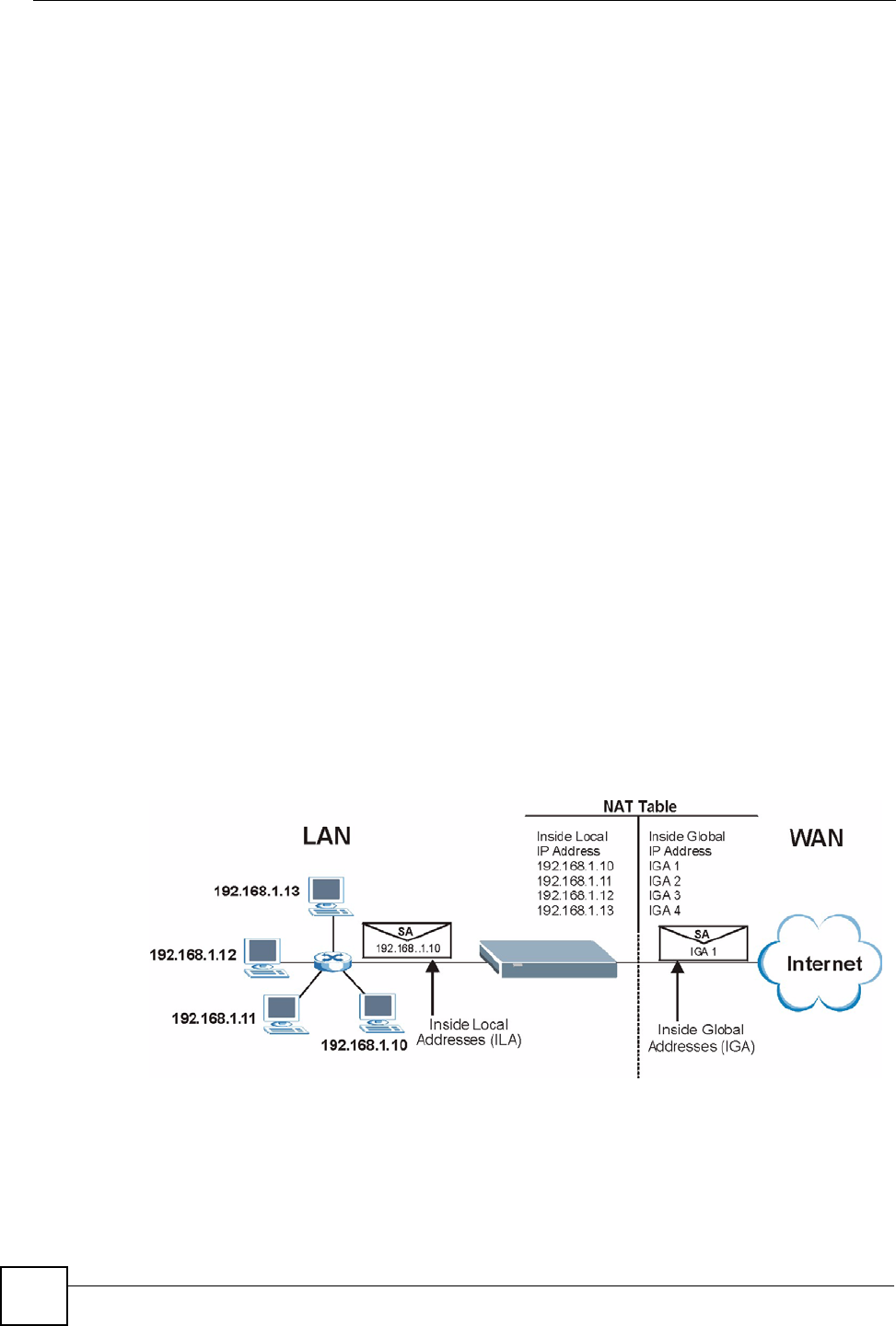
Chapter 8 Network Address Translation (NAT) Screens
P-660W-Tx v2 User’s Guide
94
8.1.2 What NAT Does
In the simplest form, NAT changes the source IP address in a packet received from a
subscriber (the inside local address) to another (the inside global address) before forwarding
the packet to the WAN side. When the response comes back, NAT translates the destination
address (the inside global address) back to the inside local address before forwarding it to the
original inside host. Note that the IP address (either local or global) of an outside host is never
changed.
The global IP addresses for the inside hosts can be either static or dynamically assigned by the
ISP. In addition, you can designate servers, for example, a web server and a telnet server, on
your local network and make them accessible to the outside world. If you do not define any
servers (for Many-to-One and Many-to-Many Overload mapping – see Table 29 on page 96),
NAT offers the additional benefit of firewall protection. With no servers defined, your ZyXEL
Device filters out all incoming inquiries, thus preventing intruders from probing your network.
For more information on IP address translation, refer to RFC 1631, The IP Network Address
Translator (NAT).
8.1.3 How NAT Works
Each packet has two addresses – a source address and a destination address. For outgoing
packets, the ILA (Inside Local Address) is the source address on the LAN, and the IGA (Inside
Global Address) is the source address on the WAN. For incoming packets, the ILA is the
destination address on the LAN, and the IGA is the destination address on the WAN. NAT
maps private (local) IP addresses to globally unique ones required for communication with
hosts on other networks. It replaces the original IP source address (and TCP or UDP source
port numbers for Many-to-One and Many-to-Many Overload NAT mapping) in each packet
and then forwards it to the Internet. The ZyXEL Device keeps track of the original addresses
and port numbers so incoming reply packets can have their original values restored. The
following figure illustrates this.
Figure 37 How NAT Works
8.1.4 NAT Application
The following figure illustrates a possible NAT application, where three inside LANs (logical
LANs using IP Alias) behind the ZyXEL Device can communicate with three distinct WAN
networks. More examples follow at the end of this chapter.
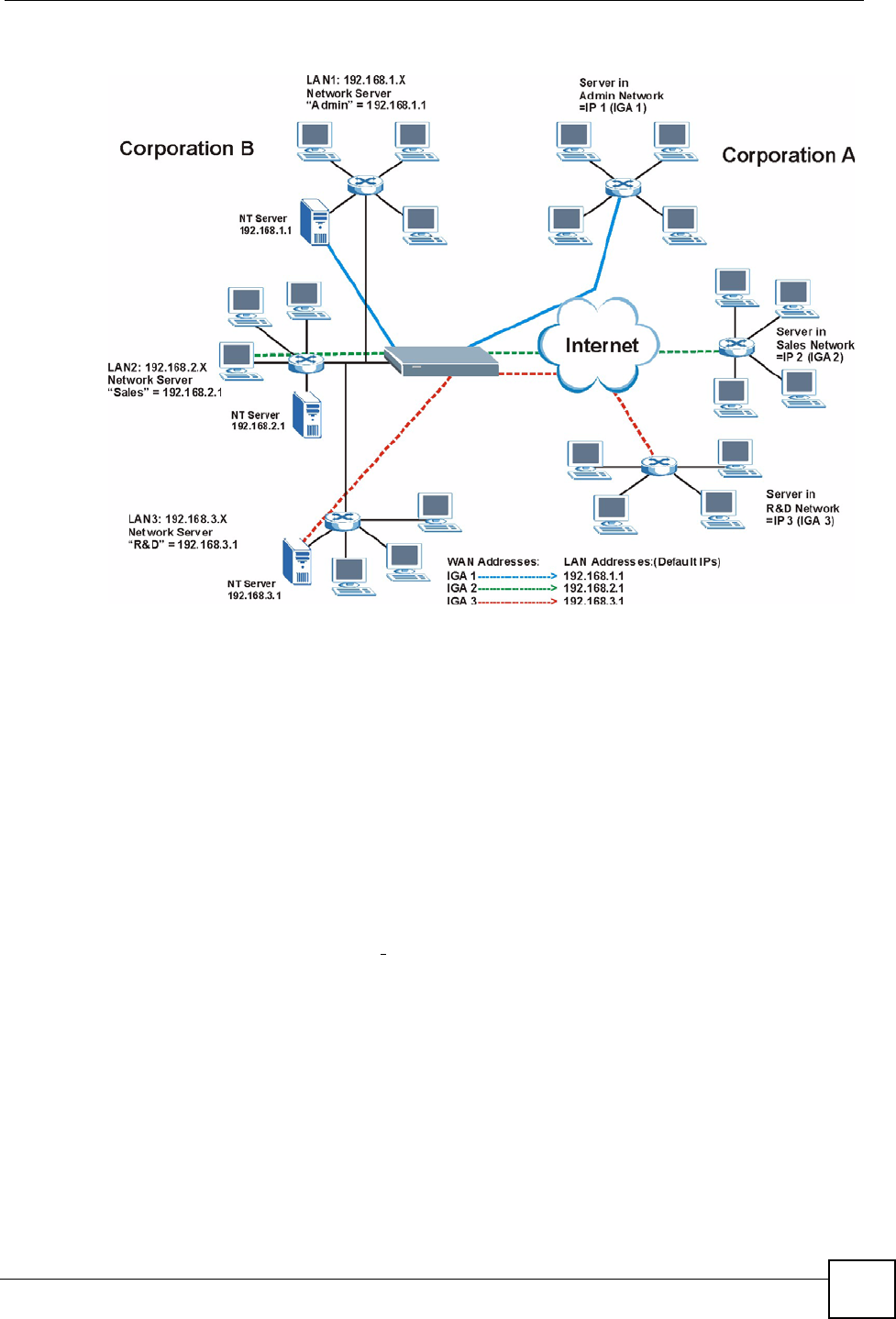
Chapter 8 Network Address Translation (NAT) Screens
P-660W-Tx v2 User’s Guide 95
Figure 38 NAT Application With IP Alias
8.1.5 NAT Mapping Types
NAT supports five types of IP/port mapping. They are:
•One to One: In One-to-One mode, the ZyXEL Device maps one local IP address to one
global IP address.
•Many to One: In Many-to-One mode, the ZyXEL Device maps multiple local IP
addresses to one global IP address. This is equivalent to SUA (for instance, PAT, port
address translation), ZyXEL’s Single User Account feature that previous ZyXEL routers
supported (the SUA Only option in today’s routers).
•Many to Many Overload: In Many-to-Many Overload mode, the ZyXEL Device maps
the multiple local IP addresses to shared global IP addresses.
•Many-to-Many No Overload: In Many-to-Many No Overload mode, the ZyXEL Device
maps each local IP address to a unique global IP address.
•Server: This type allows you to specify inside servers of different services behind the
NAT to be accessible to the outside world.
Port numbers do NOT change for One-to-One and Many-to-Many No Overload NAT
mapping types.

Chapter 8 Network Address Translation (NAT) Screens
P-660W-Tx v2 User’s Guide
96
The following table summarizes these types.
8.2 SUA (Single User Account) Versus NAT
SUA (Single User Account) is a ZyNOS implementation of a subset of NAT that supports two
types of mapping, Many-to-One and Server. The ZyXEL Device also supports Full
Feature NAT to map multiple global IP addresses to multiple private LAN IP addresses of
clients or servers using mapping types as outlined in Table 29 on page 96.
• Choose SUA Only if you have just one public WAN IP address for your ZyXEL Device.
• Choose Full Feature if you have multiple public WAN IP addresses for your ZyXEL
Device.
8.3 SUA Server
A SUA server set is a list of inside (behind NAT on the LAN) servers, for example, web or
FTP, that you can make visible to the outside world even though SUA makes your whole
inside network appear as a single computer to the outside world.
You may enter a single port number or a range of port numbers to be forwarded, and the local
IP address of the desired server. The port number identifies a service; for example, web
service is on port 80 and FTP on port 21. In some cases, such as for unknown services or
where one server can support more than one service (for example both FTP and web service),
it might be better to specify a range of port numbers. You can allocate a server IP address that
corresponds to a port or a range of ports.
Many residential broadband ISP accounts do not allow you to run any server processes (such
as a Web or FTP server) from your location. Your ISP may periodically check for servers and
may suspend your account if it discovers any active services at your location. If you are
unsure, refer to your ISP.
Table 29 NAT Mapping Types
TYPE IP MAPPING
One-to-One ILA1ÅÆ IGA1
Many-to-One (SUA/PAT) ILA1ÅÆ IGA1
ILA2ÅÆ IGA1
…
Many-to-Many Overload ILA1ÅÆ IGA1
ILA2ÅÆ IGA2
ILA3ÅÆ IGA1
ILA4ÅÆ IGA2
…
Many-to-Many No Overload ILA1ÅÆ IGA1
ILA2ÅÆ IGA2
ILA3ÅÆ IGA3
…
Server Server 1 IPÅÆ IGA1
Server 2 IPÅÆ IGA1
Server 3 IPÅÆ IGA1
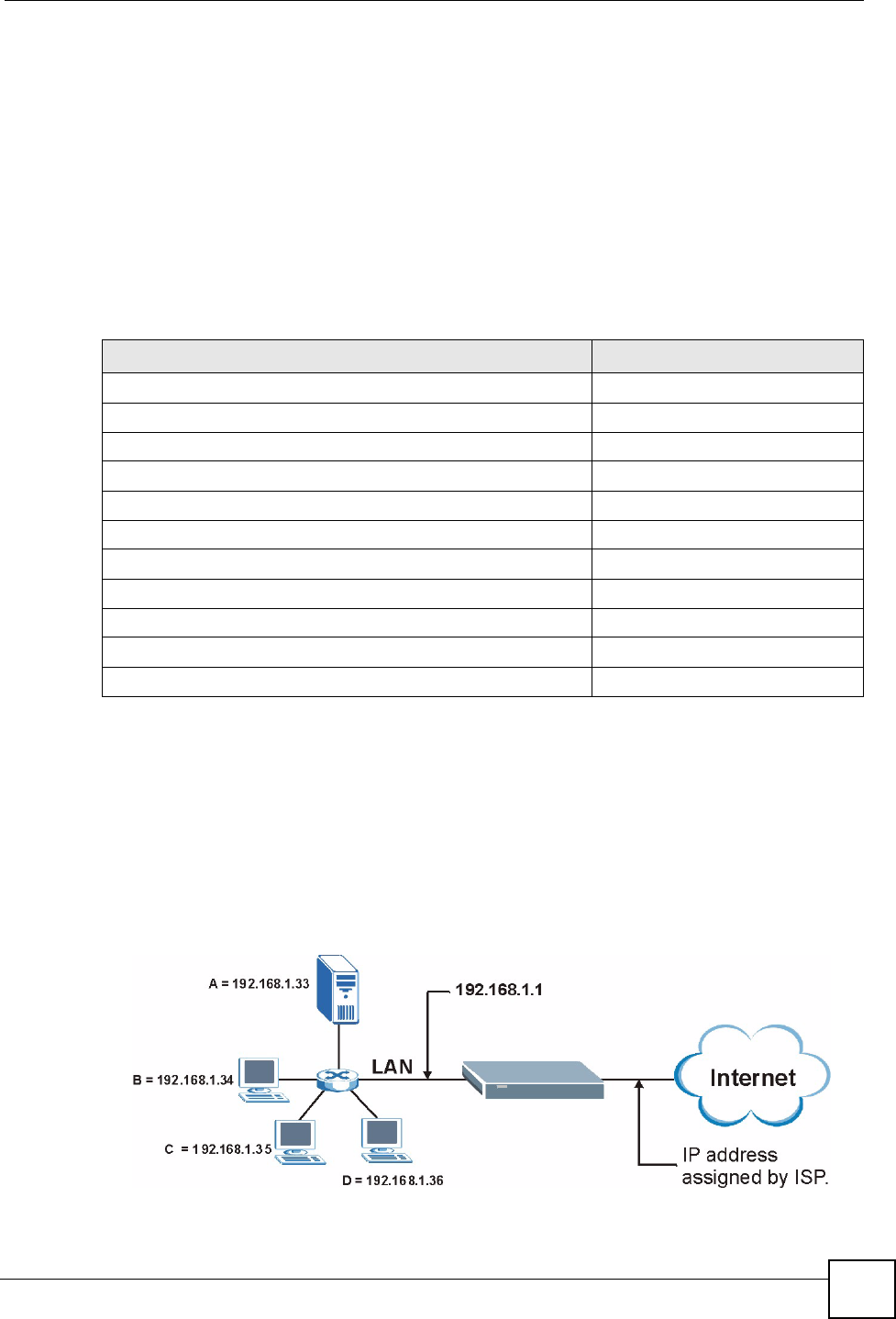
Chapter 8 Network Address Translation (NAT) Screens
P-660W-Tx v2 User’s Guide 97
8.3.1 Default Server IP Address
In addition to the servers for specified services, NAT supports a default server IP address. A
default server receives packets from ports that are not specified in this screen.
If you do not assign an IP address in Server Set 1 (default server) the ZyXEL Device discards
all packets received for ports that are not specified here or in the remote management setup.
8.3.2 Port Forwarding: Services and Port Numbers
The most often used port numbers are shown in the following table. Please refer to RFC 1700
for further information about port numbers.
8.3.3 Configuring Servers Behind SUA (Example)
Let's say you want to assign ports 21-25 to one FTP, Telnet and SMTP server (A in the
example), port 80 to another (B in the example) and assign a default server IP address of
192.168.1.35 to a third (C in the example). You assign the LAN IP addresses and the ISP
assigns the WAN IP address. The NAT network appears as a single host on the Internet.
IP address assigned by ISP.
Figure 39 Multiple Servers Behind NAT Example
Table 30 Services and Port Numbers
SERVICES PORT NUMBER
ECHO 7
FTP (File Transfer Protocol) 21
SMTP (Simple Mail Transfer Protocol) 25
DNS (Domain Name System) 53
Finger 79
HTTP (Hyper Text Transfer protocol or WWW, Web) 80
POP3 (Post Office Protocol) 110
NNTP (Network News Transport Protocol) 119
SNMP (Simple Network Management Protocol) 161
SNMP trap 162
PPTP (Point-to-Point Tunneling Protocol) 1723
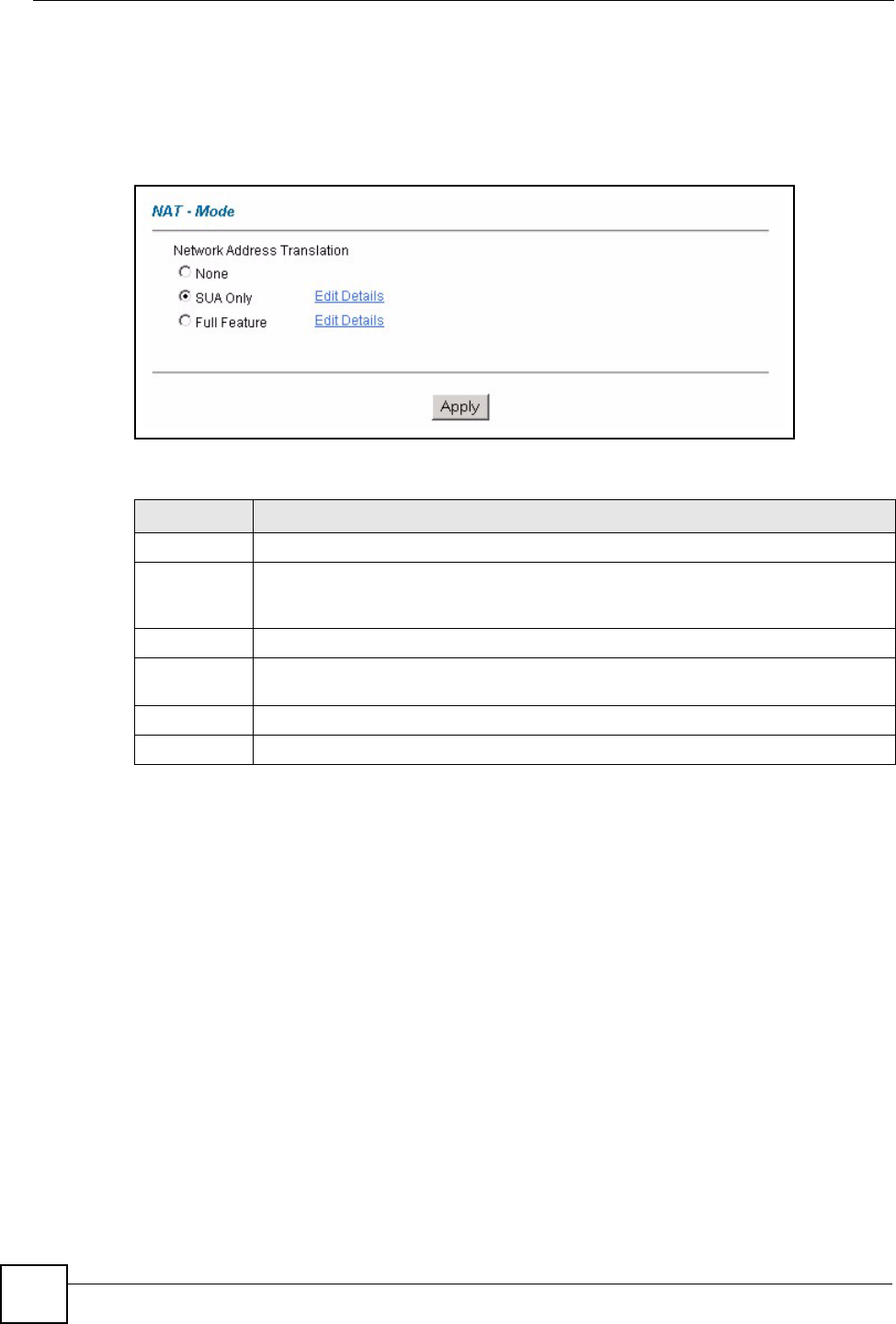
Chapter 8 Network Address Translation (NAT) Screens
P-660W-Tx v2 User’s Guide
98
8.4 Selecting the NAT Mode
You must create a firewall rule in addition to setting up SUA/NAT, to allow traffic from the
WAN to be forwarded through the ZyXEL Device. Click NAT to open the following screen.
Figure 40 NAT Mode
The following table describes the labels in this screen.
8.5 Configuring SUA Server Set
If you do not assign an IP address in Server Set 1 (default server) the ZyXEL Device discards
all packets received for ports that are not specified here or in the remote management setup.
Click NAT, select SUA Only and click Edit Details to open the following screen.
See Section 8.3 on page 96 for more information. See Table 30 on page 97 for port numbers
commonly used for particular services.
Table 31 NAT Mode
LABEL DESCRIPTION
None Select this radio button to disable NAT.
SUA Only Select this radio button if you have just one public WAN IP address for your ZyXEL
Device. The ZyXEL Device uses Address Mapping Set 1 in the NAT - Edit SUA/NAT
Server Set screen.
Edit Details Click this link to go to the NAT - Edit SUA/NAT Server Set screen.
Full Feature Select this radio button if you have multiple public WAN IP addresses for your ZyXEL
Device.
Edit Details Click this link to go to the NAT - Address Mapping Rules screen.
Apply Click Apply to save your configuration.
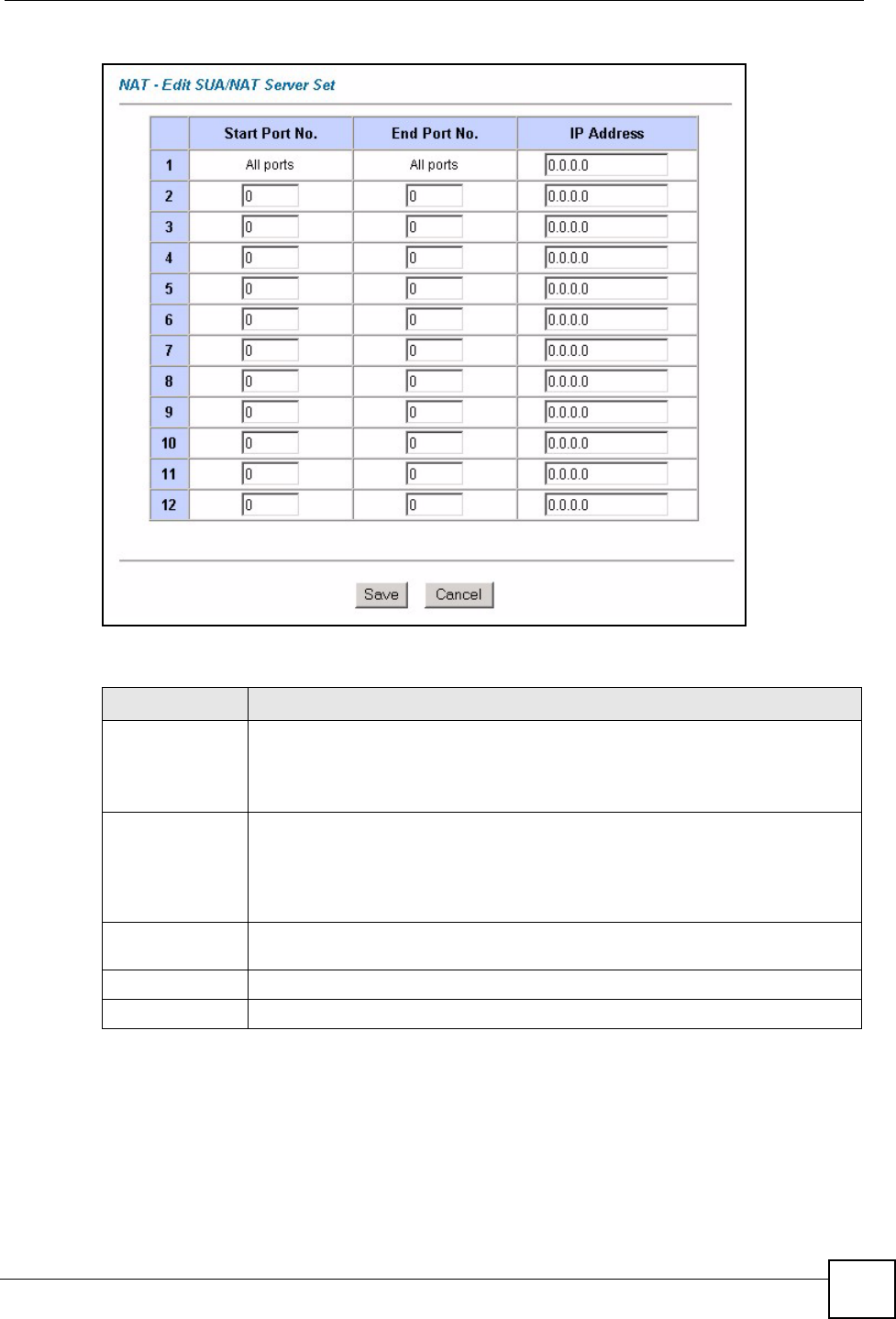
Chapter 8 Network Address Translation (NAT) Screens
P-660W-Tx v2 User’s Guide 99
Figure 41 Edit SUA/NAT Server Set
The following table describes the fields in this screen.
8.6 Configuring Address Mapping Rules
Ordering your rules is important because the ZyXEL Device applies the rules in the order that
you specify. When a rule matches the current packet, the ZyXEL Device takes the
corresponding action and the remaining rules are ignored. If there are any empty rules before
your new configured rule, your configured rule will be pushed up by that number of empty
Table 32 Edit SUA/NAT Server Set
LABEL DESCRIPTION
Start Port No. Enter a port number in this field.
To forward only one port, enter the port number again in the End Port No. field.
To forward a series of ports, enter the start port number here and the end port
number in the End Port No. field.
End Port No. Enter a port number in this field.
To forward only one port, enter the port number again in the Start Port No. field
above and then enter it again in this field.
To forward a series of ports, enter the last port number in a series that begins with
the port number in the Start Port No. field above.
Server IP
Address
Enter your server IP address in this field.
Save Click Save to save your changes back to the ZyXEL Device.
Cancel Click Cancel to return to the previous configuration.
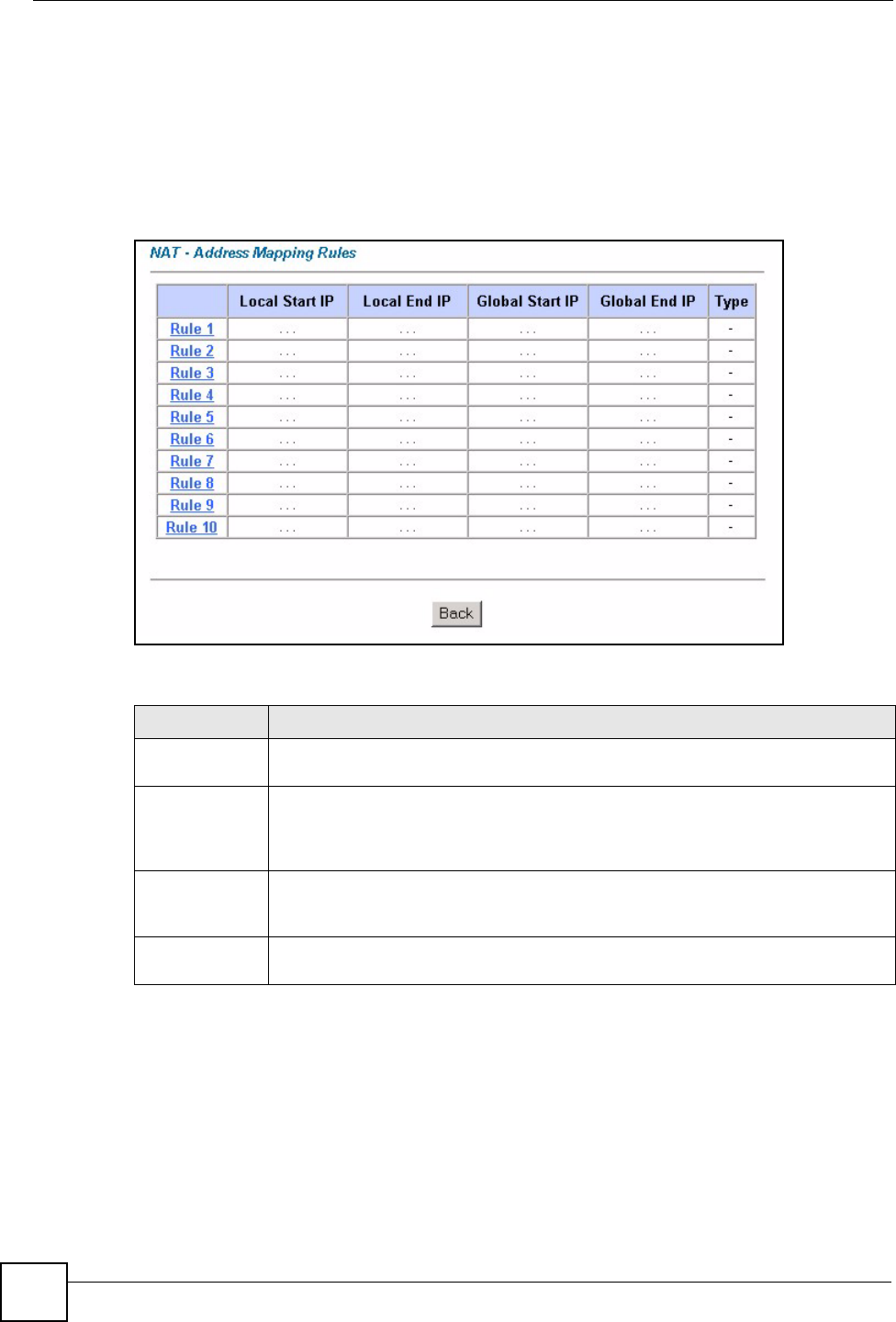
Chapter 8 Network Address Translation (NAT) Screens
P-660W-Tx v2 User’s Guide
100
rules. For example, if you have already configured rules 1 to 6 in your current set and now you
configure rule number 9. In the set summary screen, the new rule will be rule 7, not 9. Now if
you delete rule 4, rules 5 to 7 will be pushed up by 1 rule, so old rules 5, 6 and 7 become new
rules 4, 5 and 6.
Click NAT, select Full Feature and click Edit Details to open the following screen. Use this
screen to change your ZyXEL Device’s address mapping settings.
Figure 42 Address Mapping Rules
The following table describes the fields in this screen.
Table 33 Address Mapping Rules
LABEL DESCRIPTION
Local Start IP This is the starting Inside Local IP Address (ILA). Local IP addresses are N/A for
Server port mapping.
Local End IP This is the end Inside Local IP Address (ILA). If the rule is for all local IP addresses,
then this field displays 0.0.0.0 as the Local Start IP address and 255.255.255.255
as the Local End IP address. This field is N/A for One-to-one and Server mapping
types.
Global Start IP This is the starting Inside Global IP Address (IGA). Enter 0.0.0.0 here if you have a
dynamic IP address from your ISP. You can only do this for Many-to-One and
Server mapping types.
Global End IP This is the ending Inside Global IP Address (IGA). This field is N/A for One-to-one,
Many-to-One and Server mapping types.